The Wood Collection
a project by David Sellars (Dickson, TN)
September 2024
- Introduction
- Project Description
- Domestic Species
- Exotic Species
- Artist Resume
- Additional Information
David Sellars has generously donated his wood collection with 89 different types of wood. His collection and the accompanying information teach users about each wood's characteristics and woodturning quality. Each of the domestic and exotic species has detailed information that is helpful to other woodturners. This collection is on display in the Volpe Library. This website contains photos of each sample and detailed information about David's process and experience.
This project illustrates what happens when a retired English professor (me) becomes involved in an exciting new hobby (woodturning) while being confined during a pandemic (COVID-19 in 2020-21).
This project was conceived by my brother-in-law, Walter Lichtenberg Jr., who has a university degree in Forestry and worked for many years in the industry. I had advanced through the beginning level as a woodturner using mainly the maple, cherry, and walnut native to this locale. But even though I had many years of experience as a woodworker, I had little experience working with hardwoods. He suggested that I acquire samples of as many kinds of hardwood as possible and turn these samples so that I could learn about the qualities of each species. That was an excellent idea, and over the last four years, I have learned a tremendous amount about hardwood through this project.
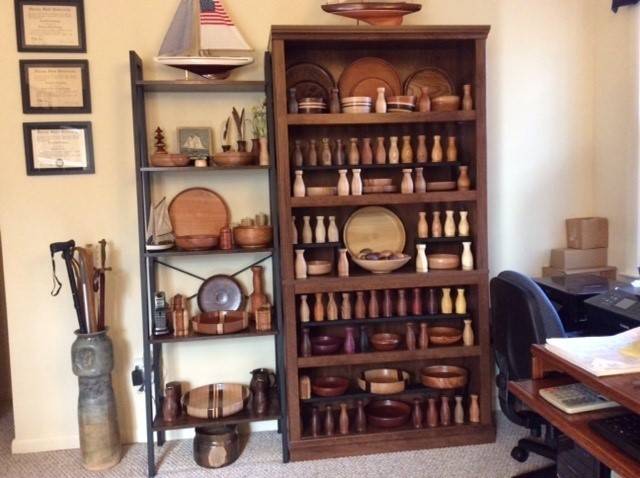
After some initial research and planning in 2019, the actual work on this project began in January of 2020, the first year of the coronavirus pandemic. Since then, I have completed over 90 samples of over 80 species, about half domestic and half exotic. In the preceding photo, the top three shelves on the bookcase hold domestic species, while the bottom two shelves hold exotic species.
Basically, the project consists of turning a small sample of a species into a “weed-pot,” a simple, common, decorative vase used to hold a few dried flowers, dried weeds, feathers, etc. The weed-pot shape was chosen for several reasons. When completed, the samples take up little space on a shelf compared to bowls, yet they are large enough to allow the color, grain, and texture of the wood to show. This shape allows the grain to be straight in some places but curved in others. The finished bottoms of the samples allow the end grain to show. Most of the samples were made from 2” x 2” x 6” turning blanks purchased online, but the diameters of the samples vary considerably, with some blanks as small as 1 ½” x 1 ½”. The samples were turned from these blanks freehand, and no two are exactly the same. A sample could be turned, sanded, and finished in about an hour. Finally, they could be made from the shortest 2” spindle blanks sold by most vendors, and shipping costs are minimized. After a sample was completed, I photographed it and wrote the informal shop notes below for future reference.
At first, this project was for my own growth as a woodturner. Then, my “wood buddies” began to contribute samples of additional species, and some suggested that I consider donating The Wood Library to a school. As a result, I have donated it to Tennessee Tech University in Cookeville, TN. It is on display in the Volpe Library and is available to students and faculty in all disciplines.
The samples of species grown in the U.S., even if non-native, are marked with D. Multiple samples of some species are included due to significant variations, such as Soft Maple, Curly Maple, Ambrosia Maple, Spalted Maple, and Mineralized Maple. The order of the samples reflects only the order in which the samples were completed.
With few exceptions, the domestic species chosen are American hardwood species that grow primarily east of the American Great Plains and are considered suitable for woodturning. Thus, West Coast woods (such as redwood, madrone, Douglas fir, etc.), woods from the arid Southwest (desert ironwood, Texas ebony, etc.), and woods from the Southern coastline (such as live oak, palm, orange, mangrove, etc.) were usually excluded.
Several common domestic species were intentionally omitted from the Wood Library. Samples of willow and basswood proved to be too soft to turn successfully. The escaped and invasive paulownia (also called princess tree or kiri) also proved too soft for turning.
This page is in progress.
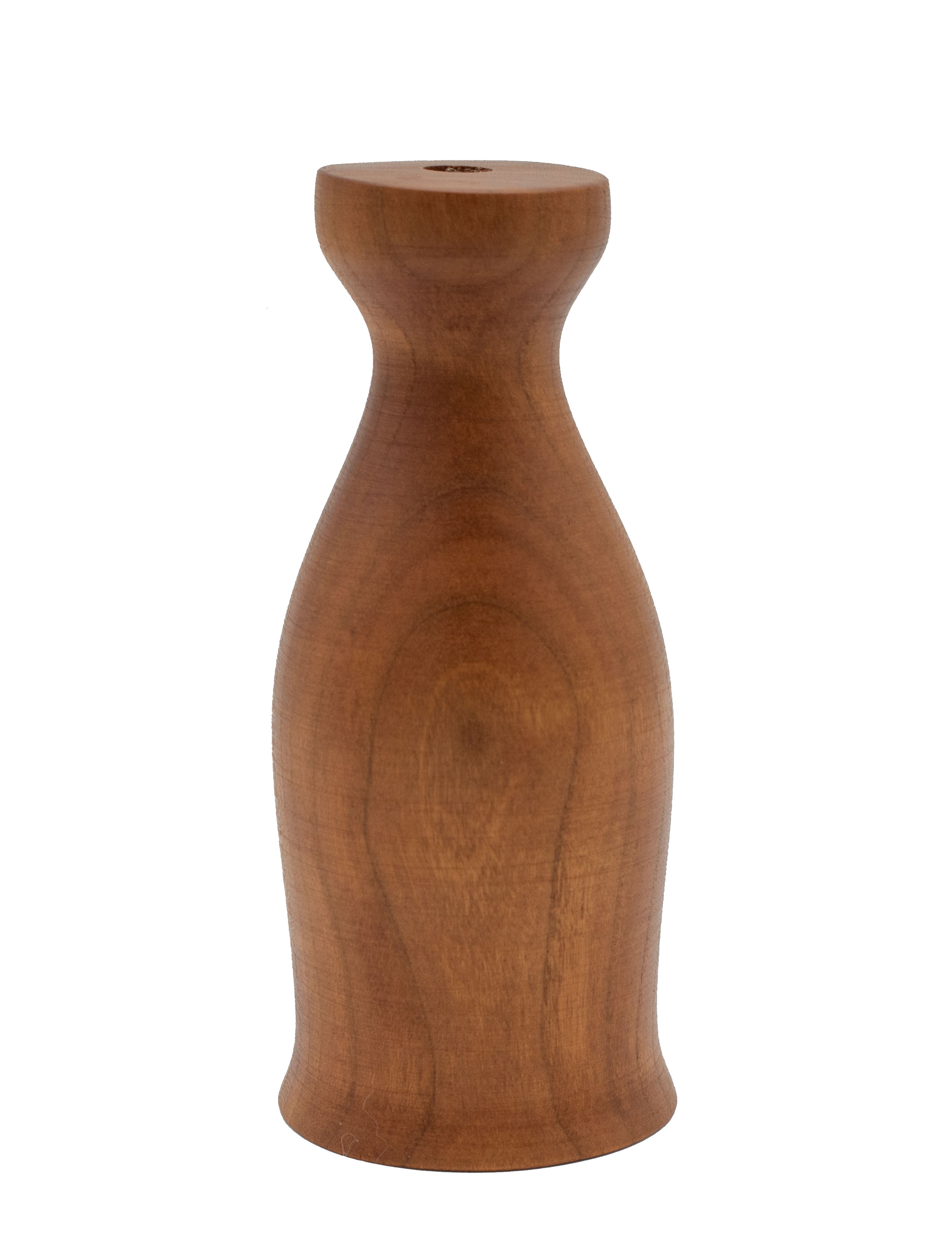
D1: Cherry
Prunus Serotina. From wild black cherry trees. Overall, one of the finest domestic turning woods. Easy
to work, glues well, forgiving to sand and finish. Can have reddish heartwood and
cream-colored sapwood in same blank. Can be curly. Widely used for quality furniture.
Readily available locally. Sample from Elwood Sellars. Would work with this species
again.
Larger view 1
Larger view 2
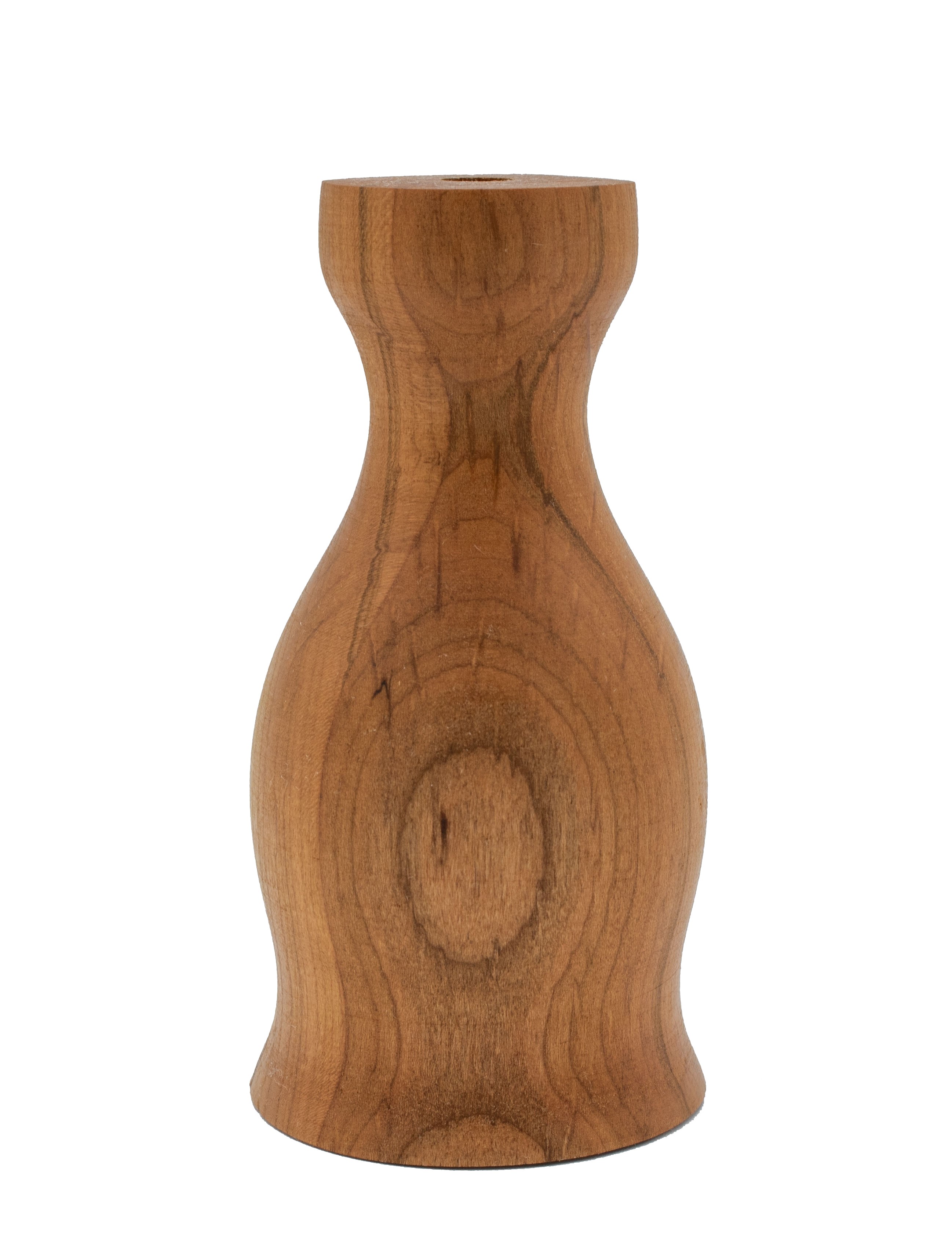
D2: Mineralized Cherry
Prunus Serotina. Same as above but with darker streak of minerals absorbed from the soil. Does not
weaken the wood. Same qualities as D 1. Not always available locally. Would work with
this species again.
Larger view 1
Larger view 2
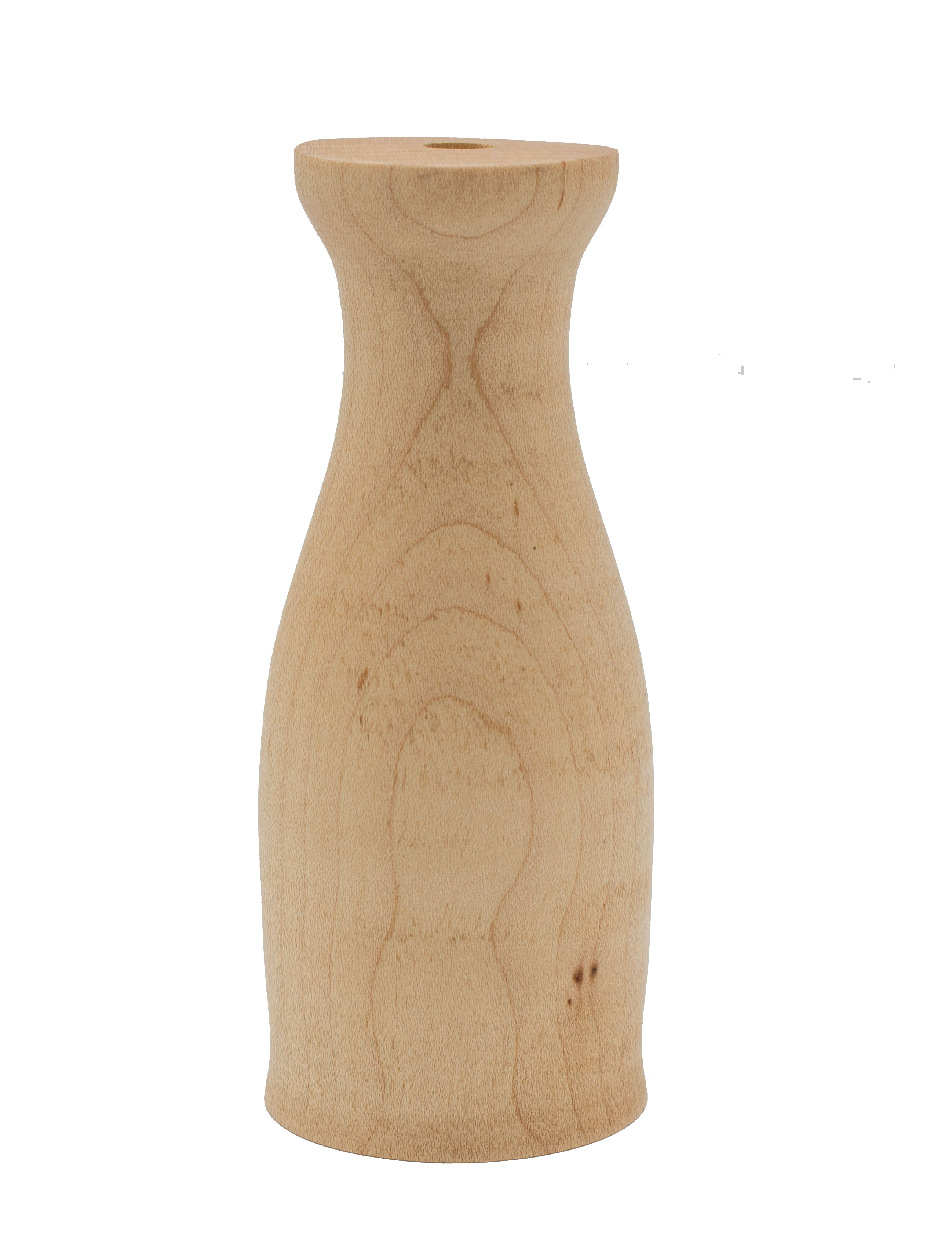
D3: Soft Maple
Acer spp. Usually silver maples, water maples, or red leaf maples, but others possible, including
box elder w/o red streaks. A generic label used w/in the lumber industry to distinguish
from hard maple which is more expensive. Easy to work and glues well, but must be
sanded carefully as any imperfection shows when finished. Burns easily on belt sander.
Tan flecks sometimes present in silver maple or red-leaf maple. Can be curly. Readily
available locally. Would work with this species again.
Larger view 1
Larger view 2
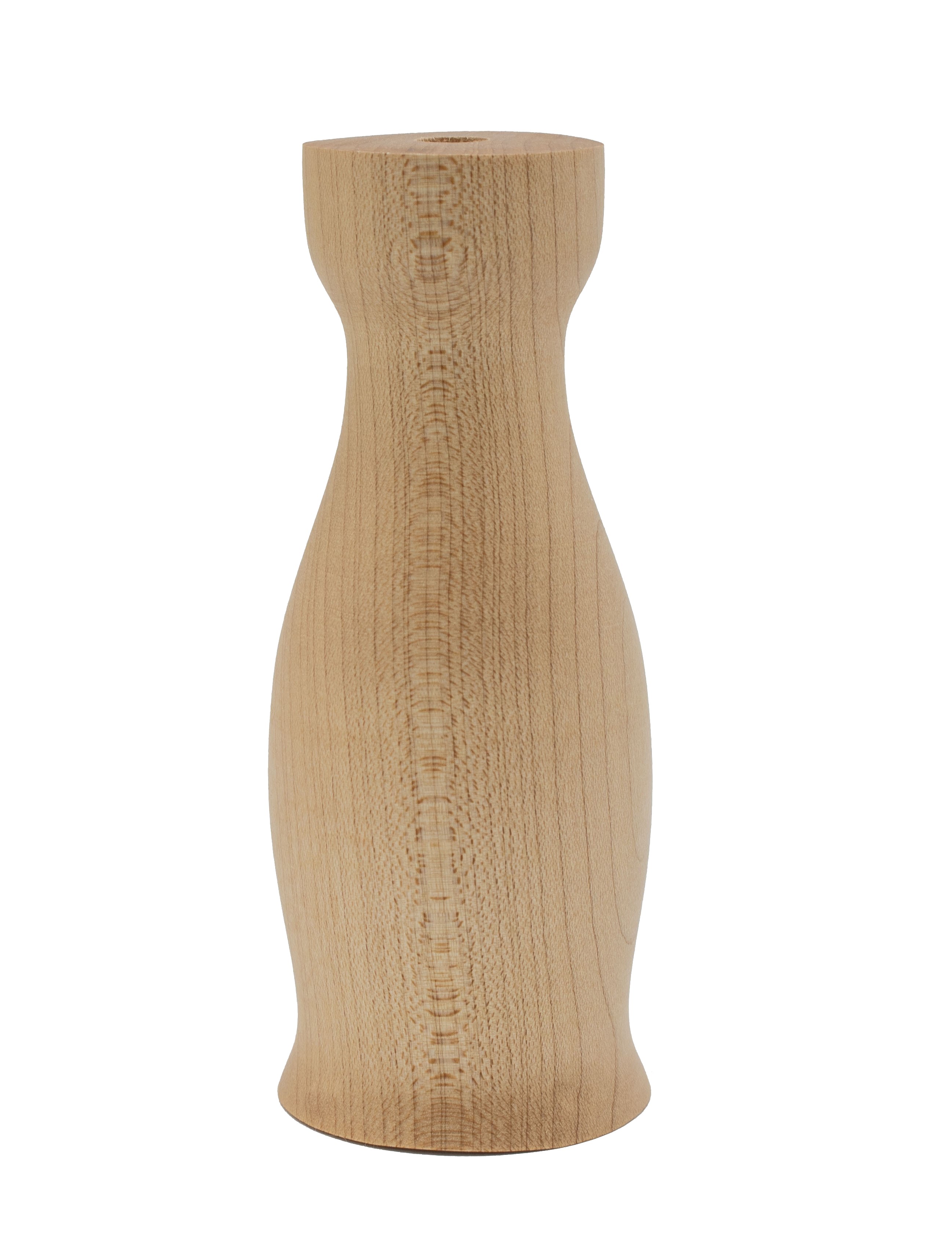
D4: Hard Maple
Acer Saccharinum. Also called Sugar Maple, Sugar Tree. Slightly harder than generic soft maple. Great
turning wood. All of the same qualities as D 3 apply except sands more easily. Can
also have more expensive variations--curly, birds-eye, quilted, or burl. Readily available
locally. Would work with this species again.
Larger view 1
Larger view 2
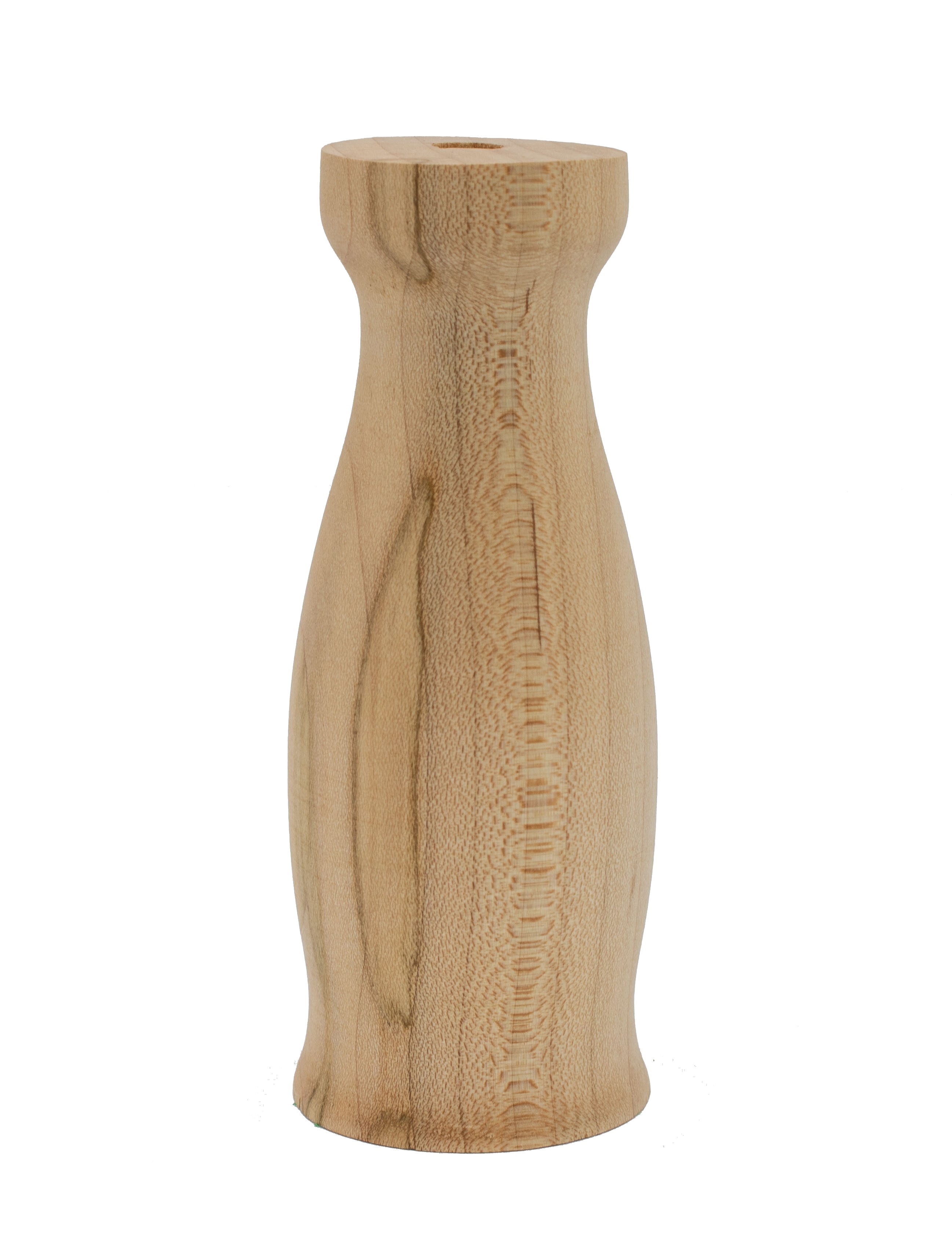
D5: Mineralized Maple
Acer spp. Usually from soft maple. Same cause as Mineralized Cherry, D 2 above. Same qualities
as D 3. Would work with this species again.
Larger view 1
Larger view 2
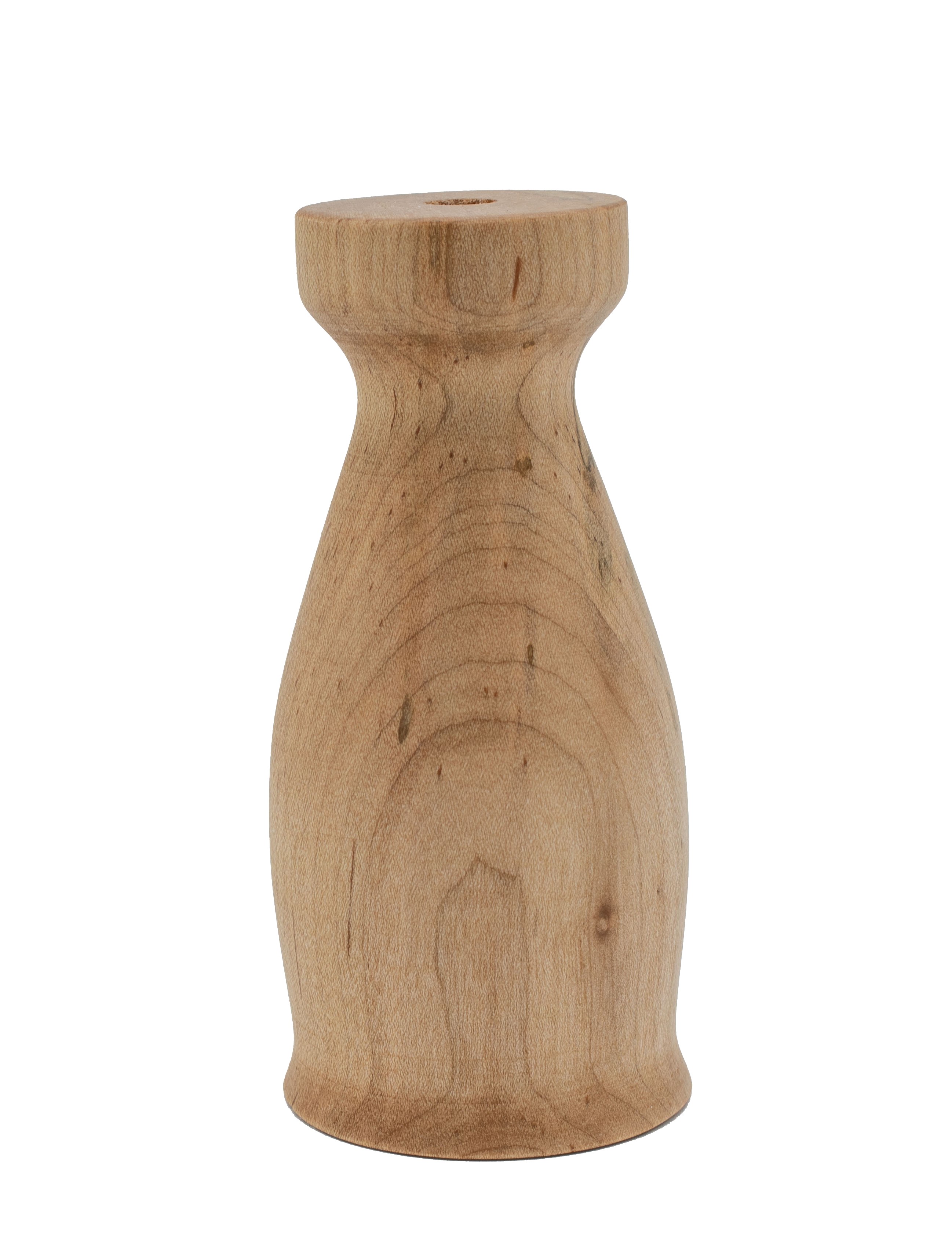
D6: Ambrosia Maple
Acer spp. Usually from soft maple. Colored streaks caused by infestation by ambrosia beetle.
Highly sought after by turners and quite pricey online. Same qualities as D 3. Would
work with this species again.
Larger view 1
Larger view 2
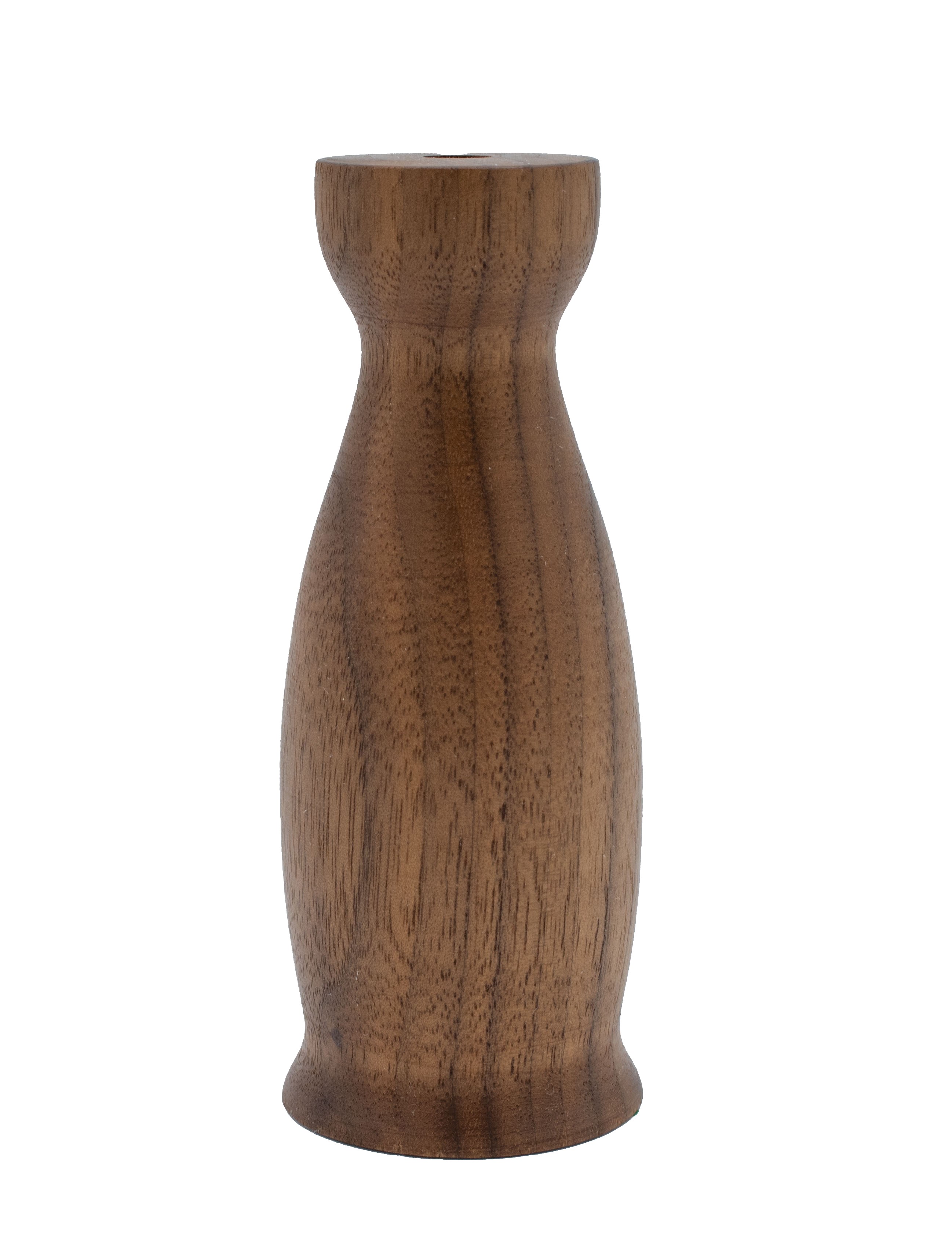
D7: Black Walnut
Juglans Nigra. From wild walnut trees. Other versions of walnut are from domesticated nut trees.
Similar hardness to Hard Maple. Easy to work, but has an odor. Mildly open and porous.
Forgiving to sand and finish. Readily available locally, but much pricier than soft
maple or cherry. Can be figured, which makes very showy pieces, but figured stock
is extremely expensive. Walnut husks are used for a natural dye. Sample from Elwood
Sellars. Would work with this species again.
Larger view 1
Larger view 2
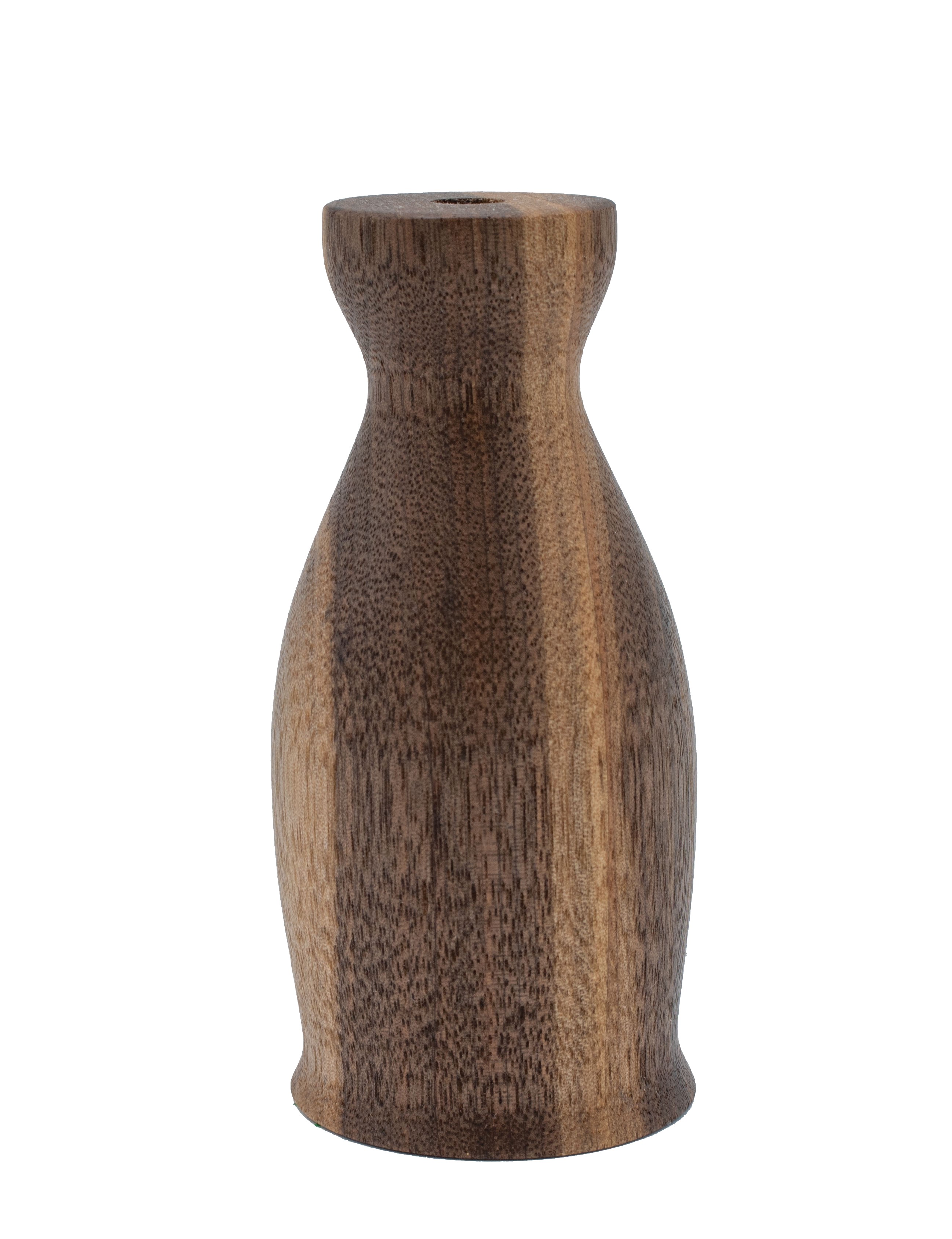
D8: Black Walnut w/ Sapwood
Juglans nigra. Same qualities as D 7, but not always available locally. Sapwood is grayish-white.
Would work with this species again.
Larger view 1
Larger view 2
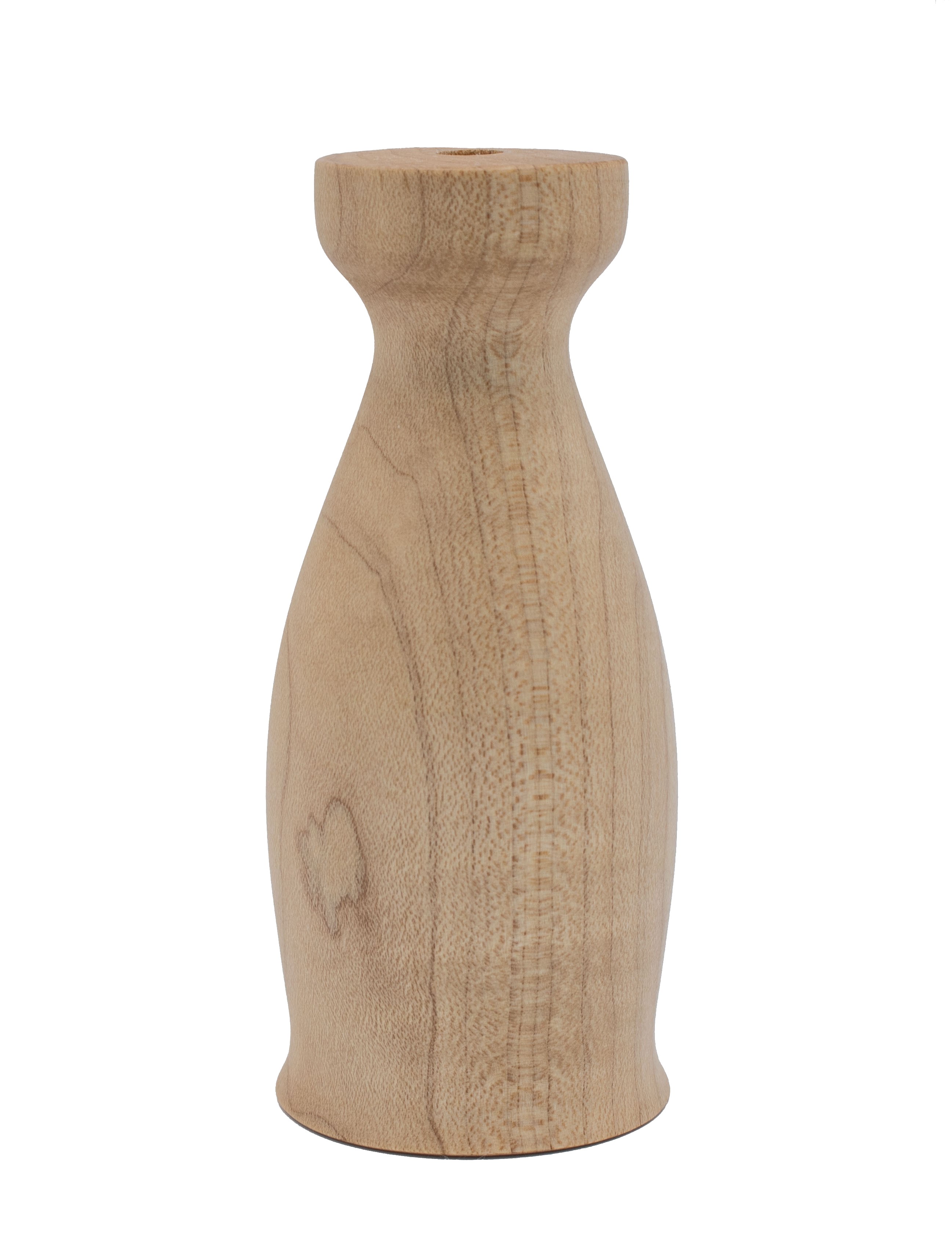
D9: Beech
Fagus Grandifolia. Easy to work, sand, drill, and finish. Tiny dark flecks in wood. Can be light and
dark streaks in same blank. Not expensive. A plentiful versatile hardwood that is
widely used commercially. A good alternative to hard maple. Sample from Phil Sparks.
Would work with this species again.
Larger view 1
Larger view 2
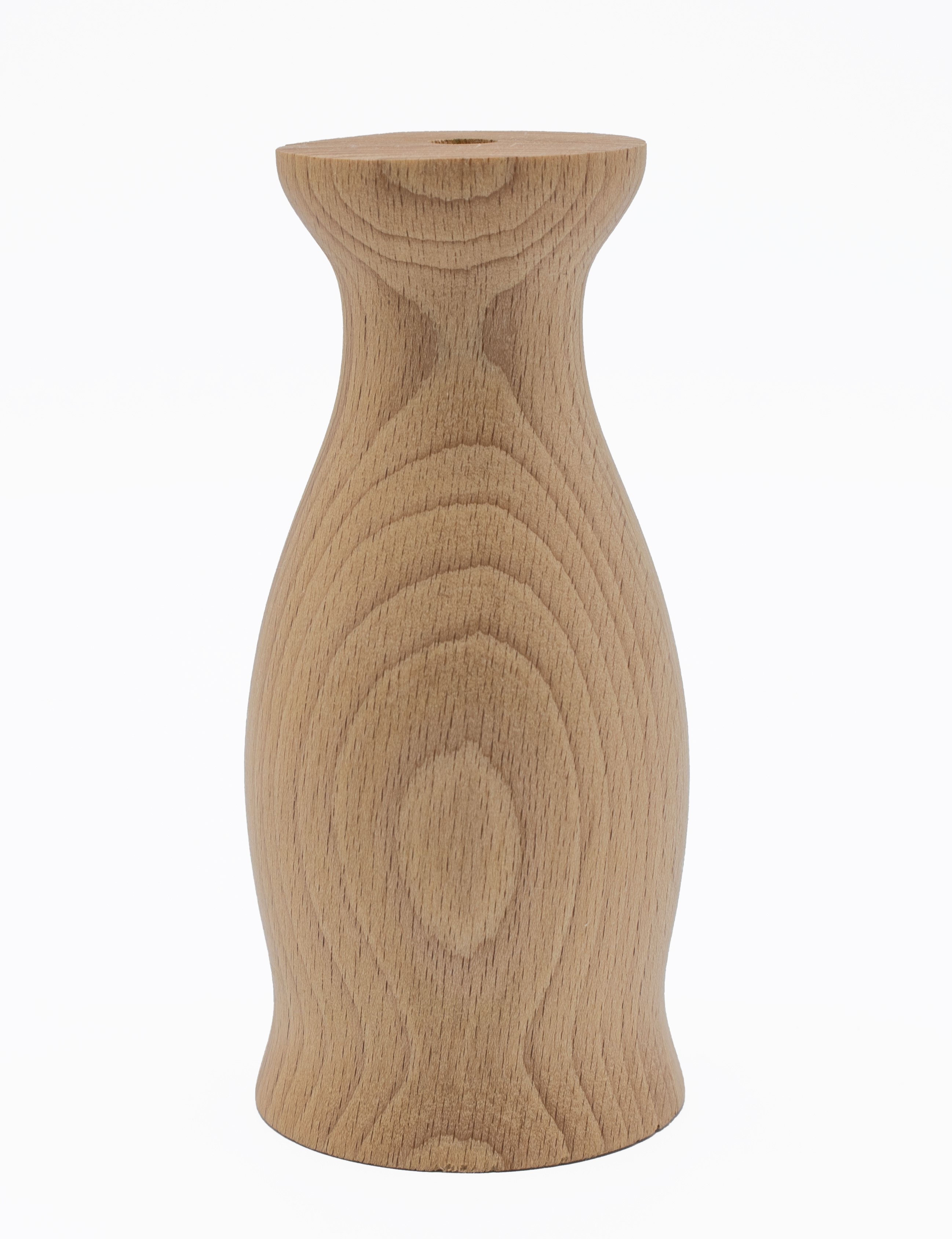
D10: Sycamore
Platanus Occidentalis. Also called American Plane, Planetree, Buttonwood. Wonderful turning wood, although
lightweight. Easy to work, sand, and finish. When quartersawn, marketed as American
Lacewood for fairly high prices. Sample from Paul Sellars. Would work with this species
again.
Larger view 1
Larger view 2
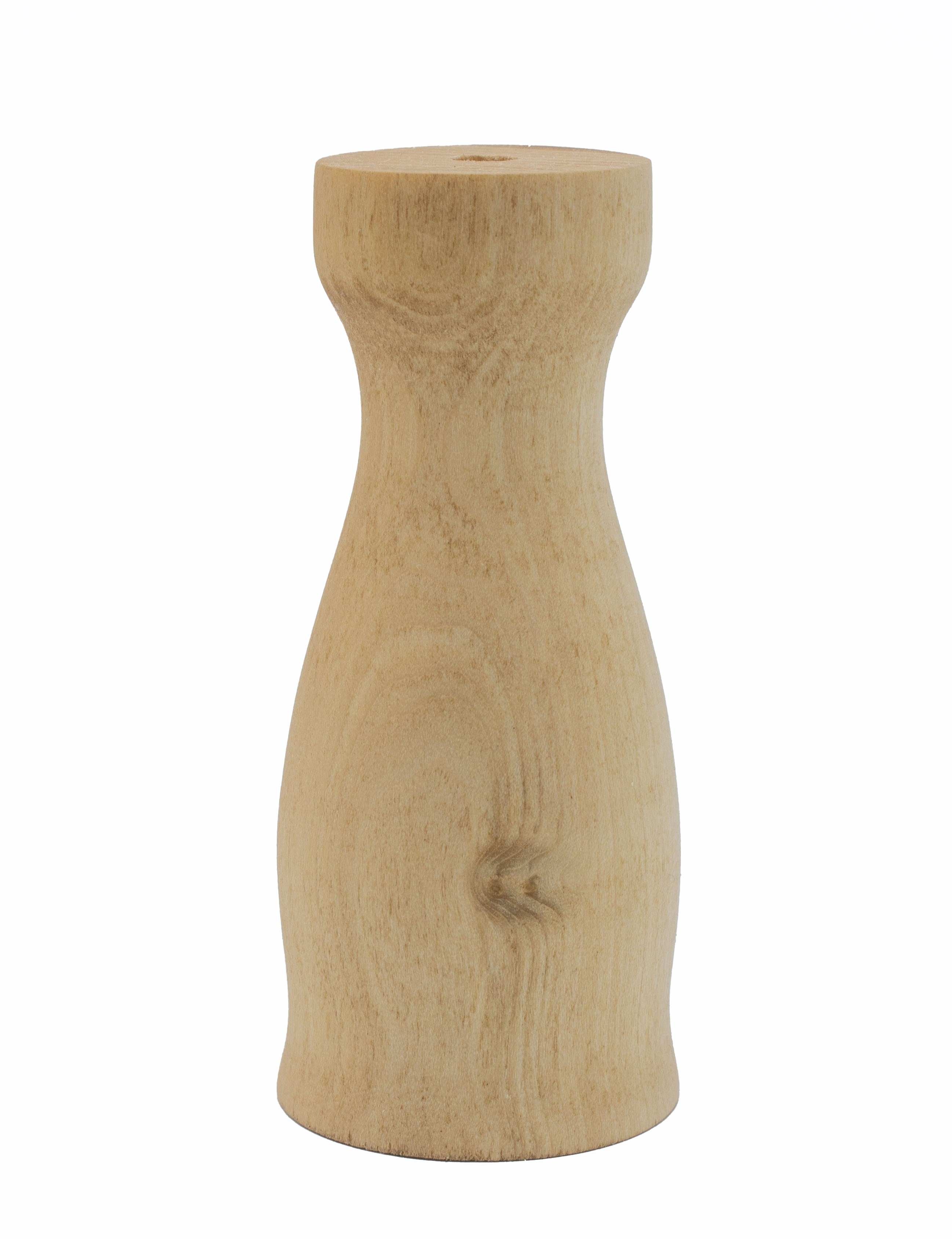
D11: Tulip Poplar
Liroidendron Tulipifera. Not a true poplar species. Very difficult to work due to softness, similar to white
pine. Easy to sand and finish. Handsome green shades at times, but they fade to light
brown over time as the wood oxidizes. Sample from Gunnar Barnes. Readily available
locally. Would avoid working with this species.
Larger view 1
Larger view 2

D12: Osage Orange
Maclura Pomifera. Also called Bodock, Bois d’Arc, Hedge Apple, and Horse Apple. Extremely hard but works
well. Natural wax in wood causes it to heat up rapidly when worked. Burns easily when
sanded. Extremely colorful with prominent yellow grain and patches of orange and green,
but over time oxidizes out to an even brown. However, the grain is still prominent.
Excellent wood for fence posts and archery bows. Early American settlers were said
to have used shavings to dye wool orange. Sample from Phil Sparks. Would work with
this species again.
Larger view 1
Larger view 2
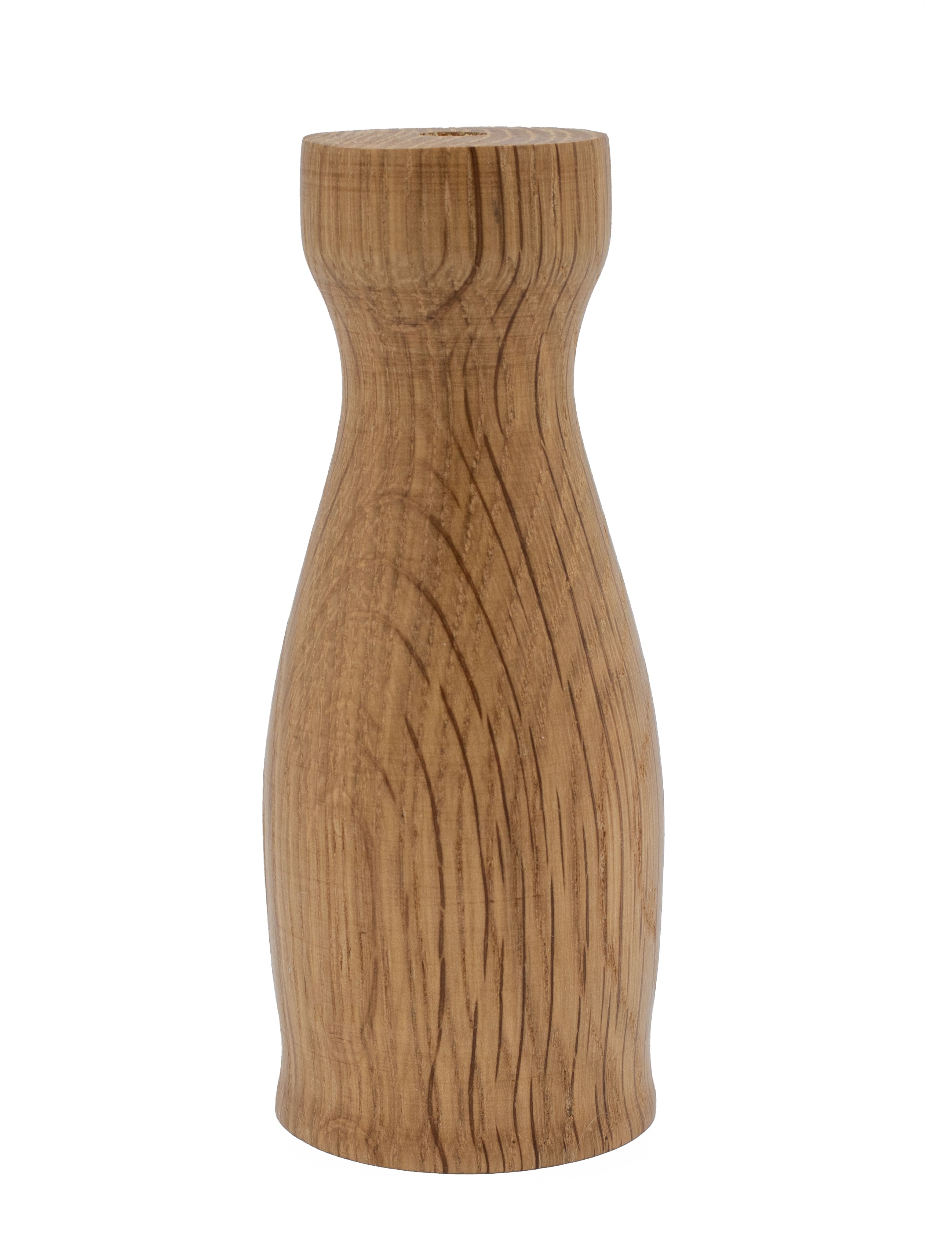
D13: White Oak
Quercus Alba. Marketed in a group of White Oaks, some almost indistinguishable but all with similar
qualities. Extremely hard to work. Very open and porous. Coarse prominent grain. Hard
to sand and finish. Needs sanding sealer. Overall very poor turning wood. More rot-resistant
than the Red Oaks, so heavily used in cooperage and boatbuilding. In earlier times,
used for treenails. Readily available locally. Would avoid working with this species.
Larger view 1
Larger view 2
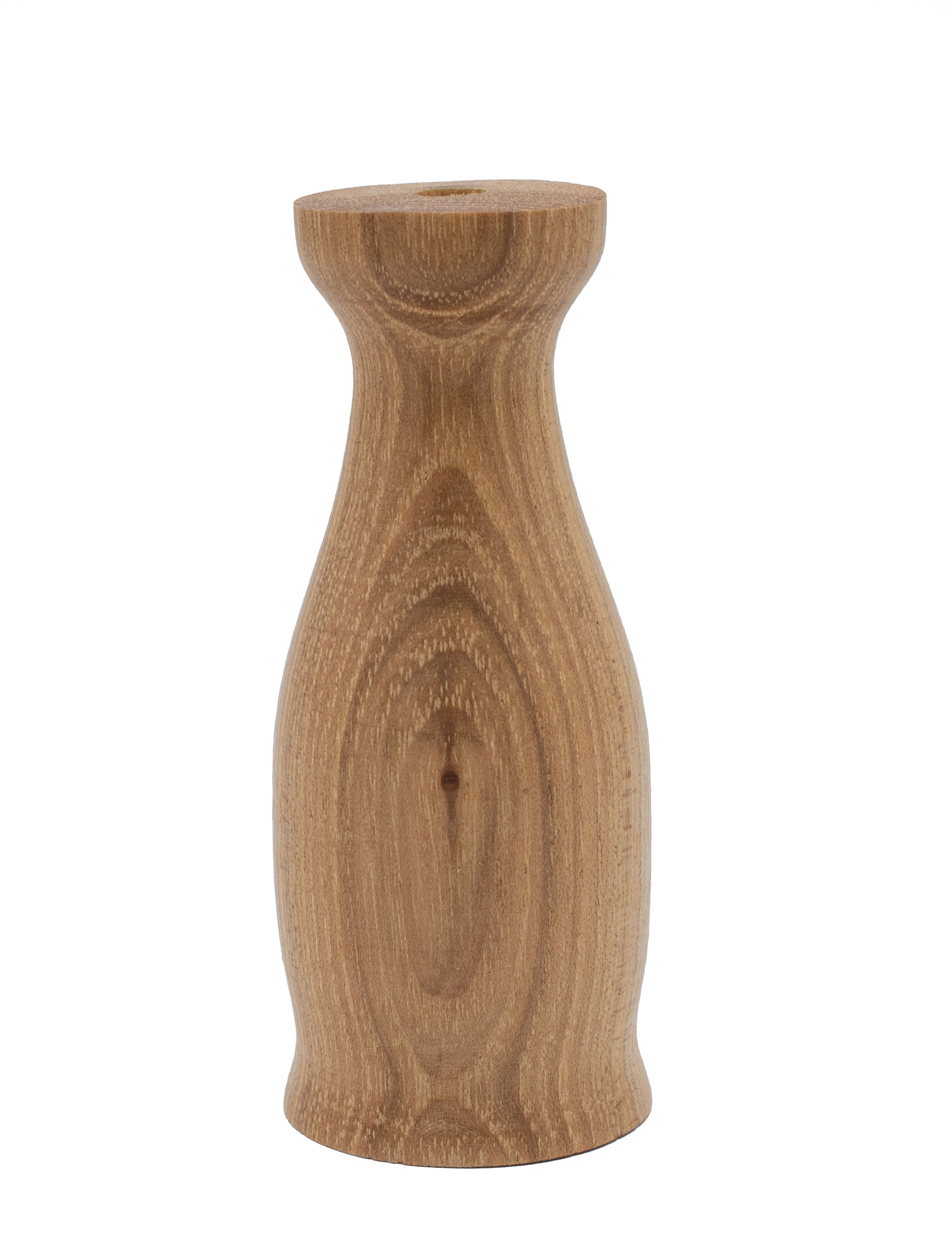
D14: Hickory
Extremely hard to work. Slightly porous, but more like walnut than oak. Interesting
grain patterns and random dark spots. Patches of very light pink and purple at times.
Can show light and dark streaks in same blank. Several species of hickory usually
combined for marketing, along with pecan, which is in the same family. Sample from
Gunnar Barnes. Readily available locally. In spite of its difficulty, would work with
this species again.
Larger view 1
Larger view 2
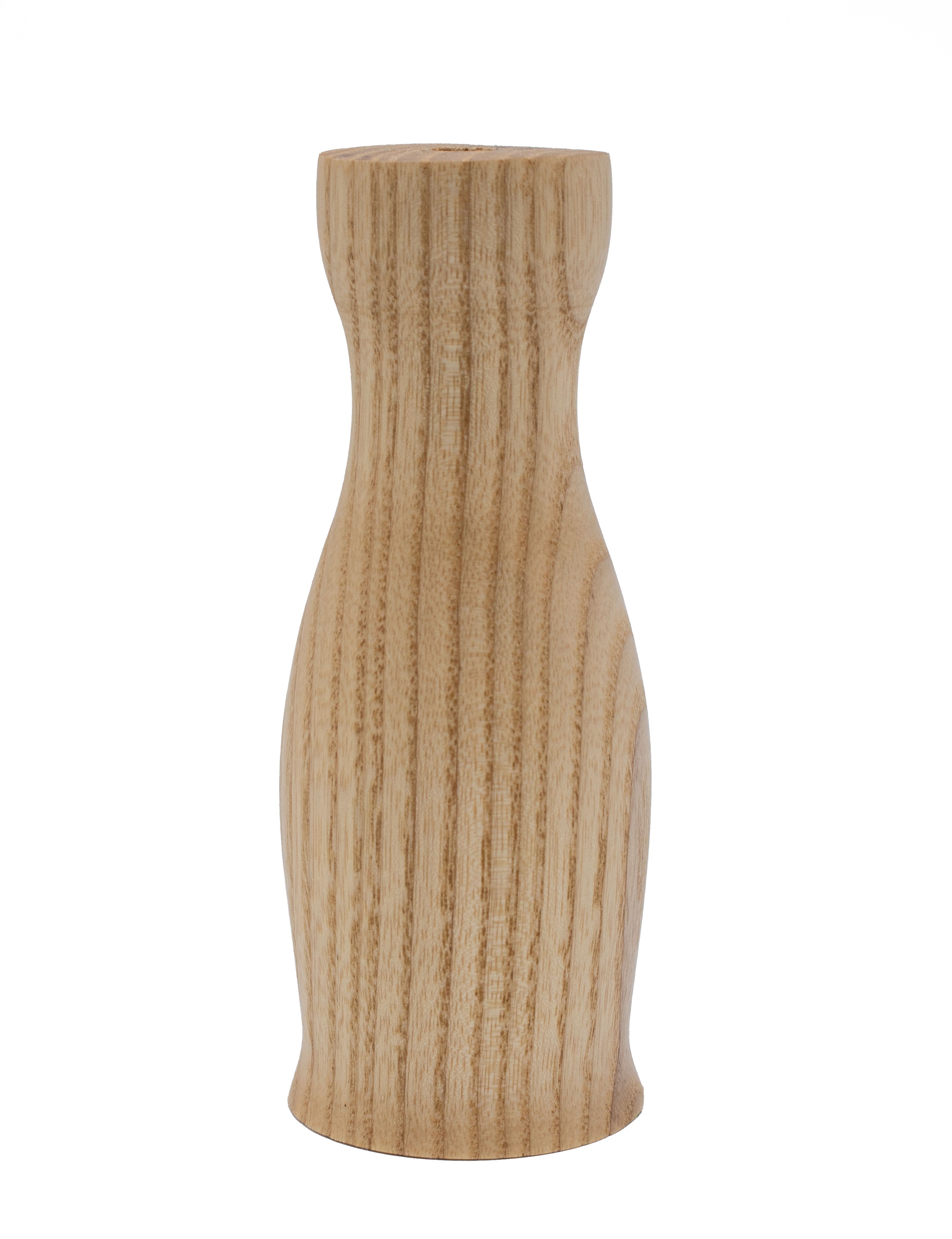
D15: White Ash
Fraxinus Americana. Looks very similar to white oak, but not quite as hard and not nearly as porous. Works
well, sands well, finishes well. An excellent moderately priced domestic alternative
to oak. Heavily used in Europe. In same family as olive and lilac. Readily available
locally. Would work with this species again.
Larger view 1
Larger view 2
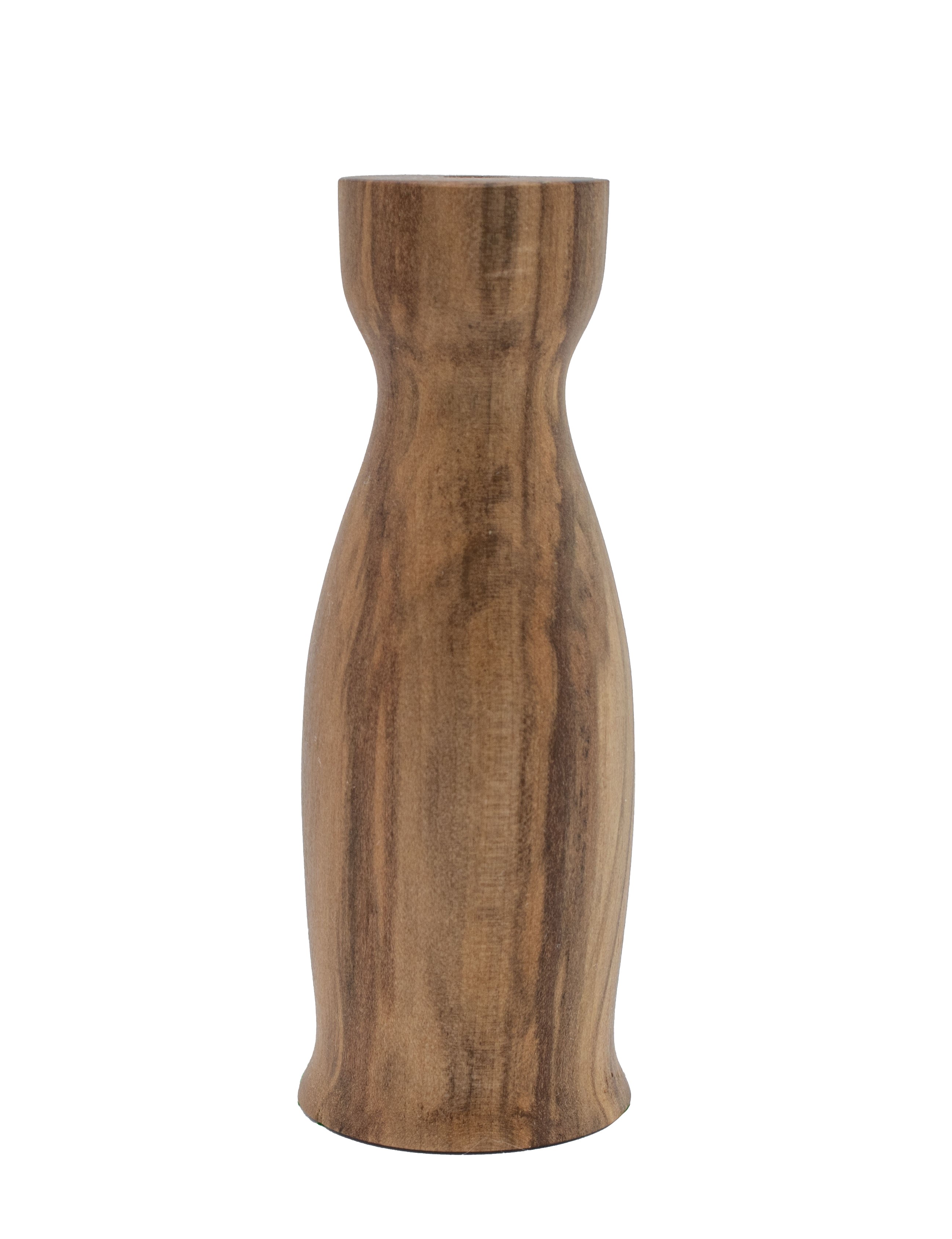
D16: Sweet Gum
Liquidambar Styraciflua. Also called Red Gum for less common heartwood. Not to be confused with expensive Australian
red gum, a member of eucalyptus family. Very colorful wood with lots of light and
dark streaks. Works easily but not too soft. Sands and drills well. Finishes to luster
rather than high polish. Lots available with green in the log locally. Would work
with this species again.
Larger view 1
Larger view 2
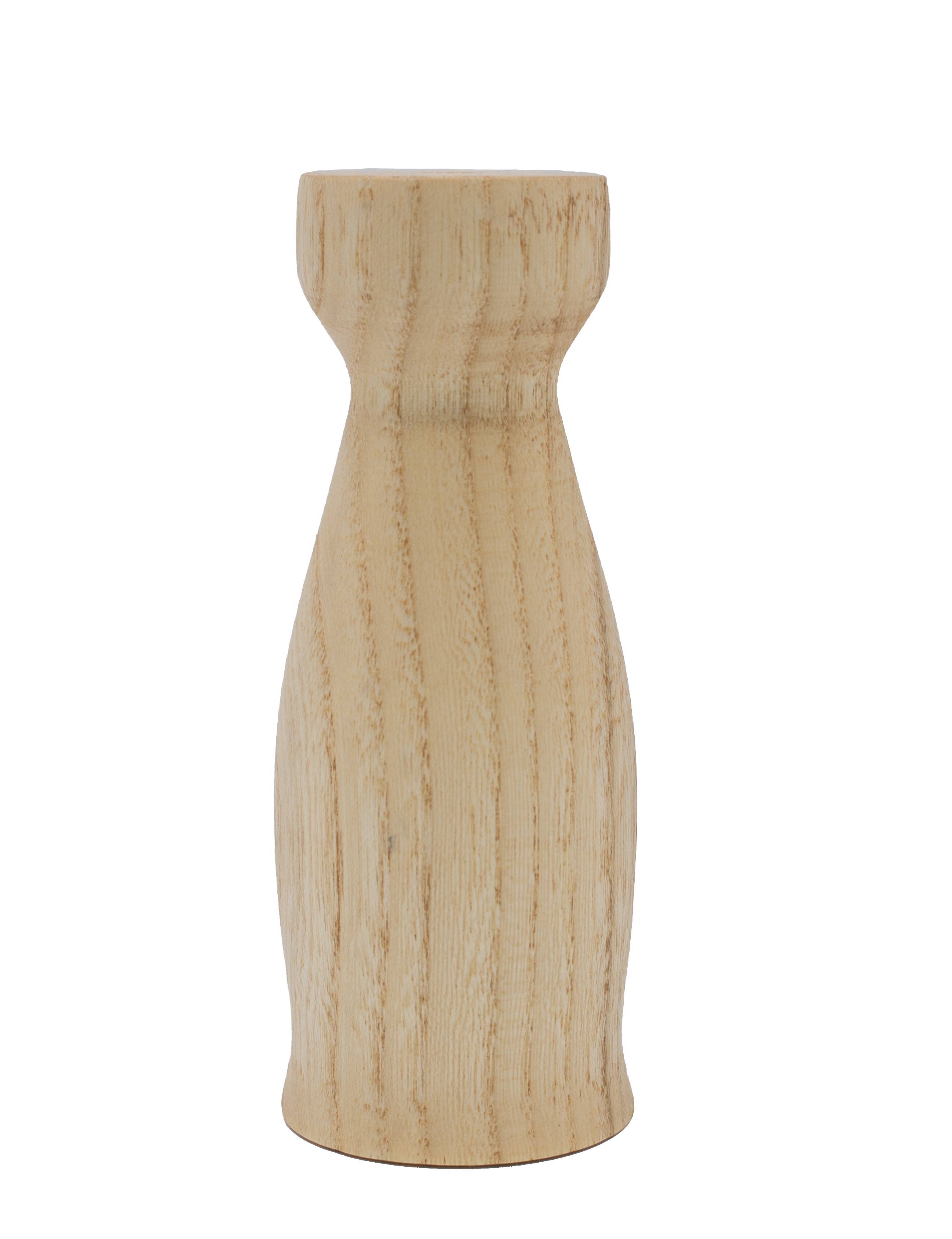
D17: Hackberry
Celtis Occidentalis. Light creamy color similar to maple or ash but with some light gold streaks and occasional
purple. Grain is wide and prominent and has a handsome secondary grain similar to
red elm. Softer than soft maple and beech, but not as soft as poplar. Takes a light
touch with the lathe tools, especially on end grain, but works easily overall. Sands
very easily but only to a luster, much like poplar. An inexpensive but acceptable
turning wood. Lots available with green in the log locally. Would work with this species
again.
Larger view 1
Larger view 2
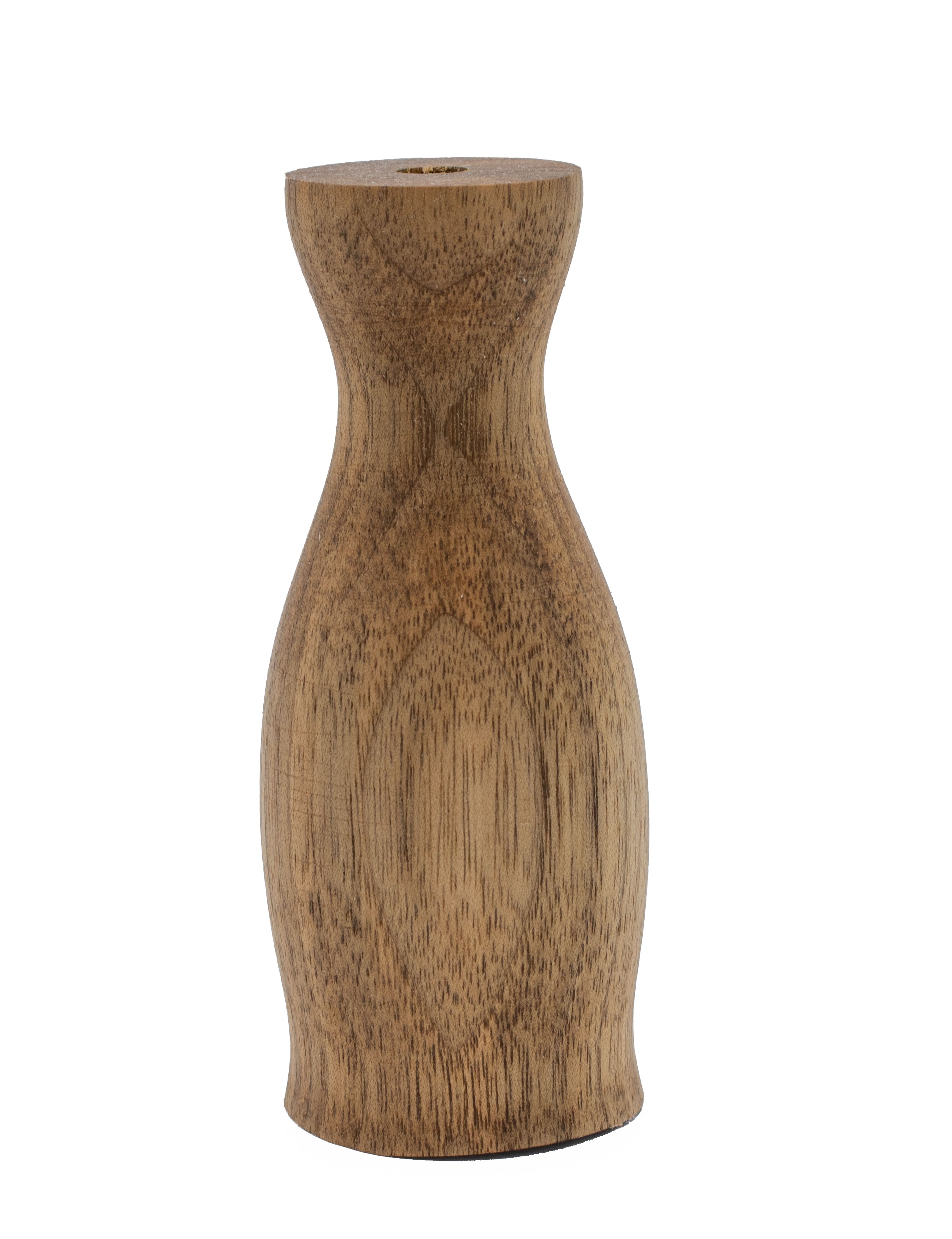
D18: Butternut
Juglans Cinerea. Related to black walnut but overall lighter in weight and color with streaks of milk
chocolate and dark chocolate colors. Works easily and somewhat porous like walnut
but much softer. Bad about tearouts. Sands easily, but can burn quickly with power
sanding. See D 8. Butternut husks have been used to dye cloth since colonial America.
Butternut brown is a standard color for artists. Would work with this species again.
Larger view 1
Larger view 2

D19: Dogwood
Cornus Florida. Also called Flowering Dogwood. Heavy dense wood with fine texture. Creamy white with
rosy pink tones. Turns, sands, and finishes similar to Osage Orange or Persimmon,
but drills hot. An excellent turning wood overall, but difficult to find except in
small dimensions. One of the hardest N. American woods with exceptional shock resistance.
Used for gold club heads, loom shuttles, mallets, and pulleys. An extremely slow growing
native tree often used as an ornamental. Sample from Cassie Smith. Would work with
this species again.
Larger view 1
Larger view 2

D20: Red Cedar
Juniperus Virginiana. Also called Eastern Red Cedar, Aromatic Cedar, but actually a species of juniper.
Extremely light weight and somewhat brittle but not difficult to turn with a light
touch and sharp tools. Reddish-purple heartwood that darkens with age and streaks
of amber sapwood. Knots and irregularities work just fine and give interest. Sands
easily but only gets a soft sheen rather than a high shine. Widely used by local craftsmen
to make rustic furniture and used in closets to repel insects that damage clothing.
Used in many ways as exterior wood since it is rot-resistant, but turns silver outdoors.
Readily available locally. Would hesitate to work with this species.
Larger view 1
Larger view 2
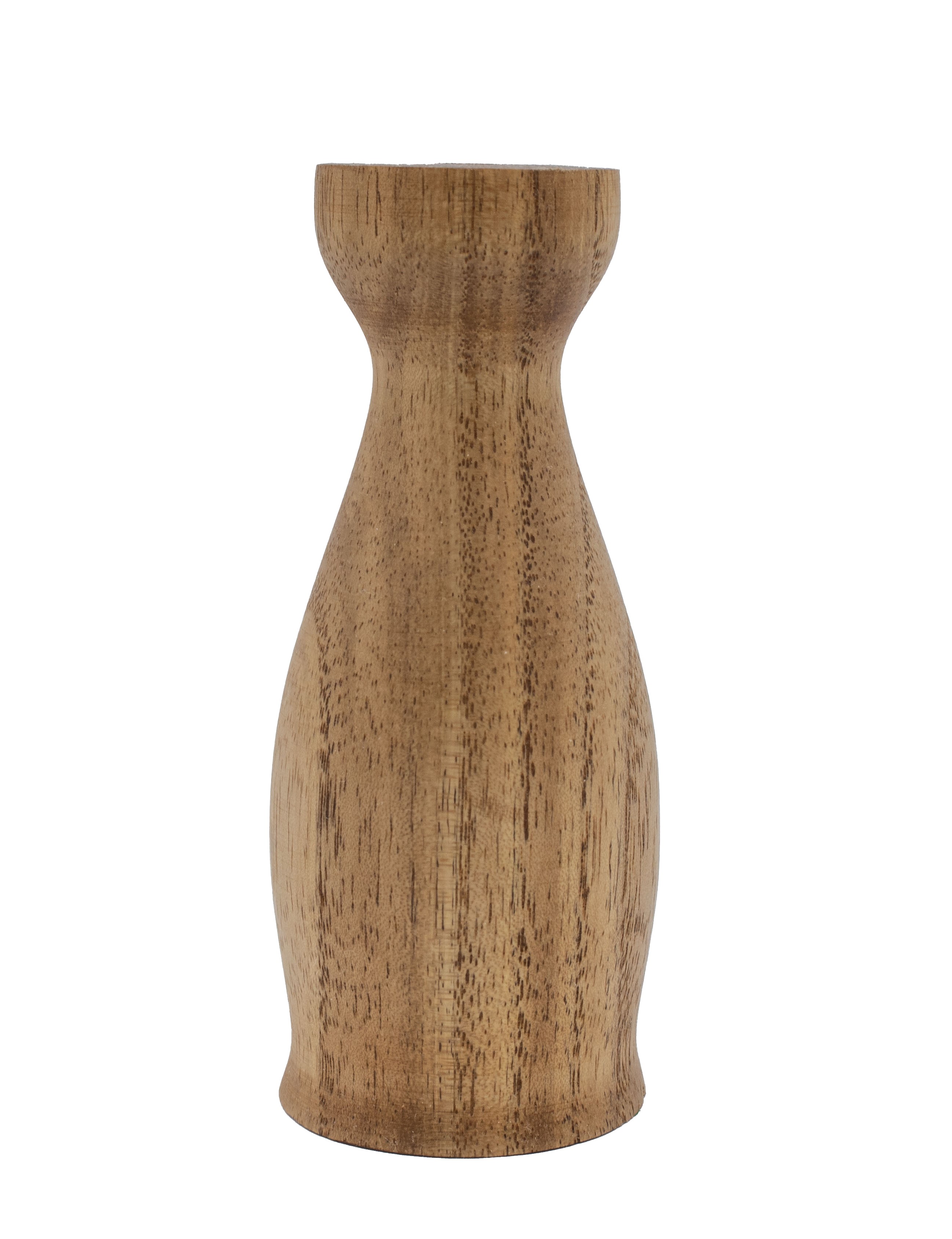
D21: Mimosa
Albizia Julibrissin. Also called Silktree, Pink Siris. An escaped exotic that has become invasive throughout
Eastern U.S. Relatively soft for a hardwood with large pores and open grain. Very
handsome when finished. Looks and works much like native butternut but not related
at all. Light brown wood with tan highlights and dark brown grain and dark brown flecks
throughout. Nice contrasts w/in the wood. Requires sharp tools and a light touch to
work without tearouts. Seldom available in planks due to small size of the trees,
but readily available as small green logs from nuisance trees being removed. Sample
from Randy Greenwell. Would work with this species again.
Larger view 1
Larger view 2

D22: Figured Beech
Fagus Grandifloria. Same working characteristics as D 9 but with dark spalting. Sample from Phil Sparks.
Would work with this species again.
Larger view 1
Larger view 2

D23: Hornbeam
Carpinus Caroliniana. Also called Ironwood, Blue Beech, and Muscle Beech (due to slick bark that looks to
have muscles rippling right below the surface). Not to be confused with Hophornbeam,
a related species. An excellent turning wood. Easy to work, sand, and finish. Streaks
of bluish-gray in the wood. An uncommon wood not usually available commercially. Very
strong and hard. Used for wooden wheels, tool handles, shafts, and other small wooden
parts. Sometimes dyed black as a substitute for ebony. Sample from Phil Sparks. Would
work with this species again.
Larger view 1
Larger view 2
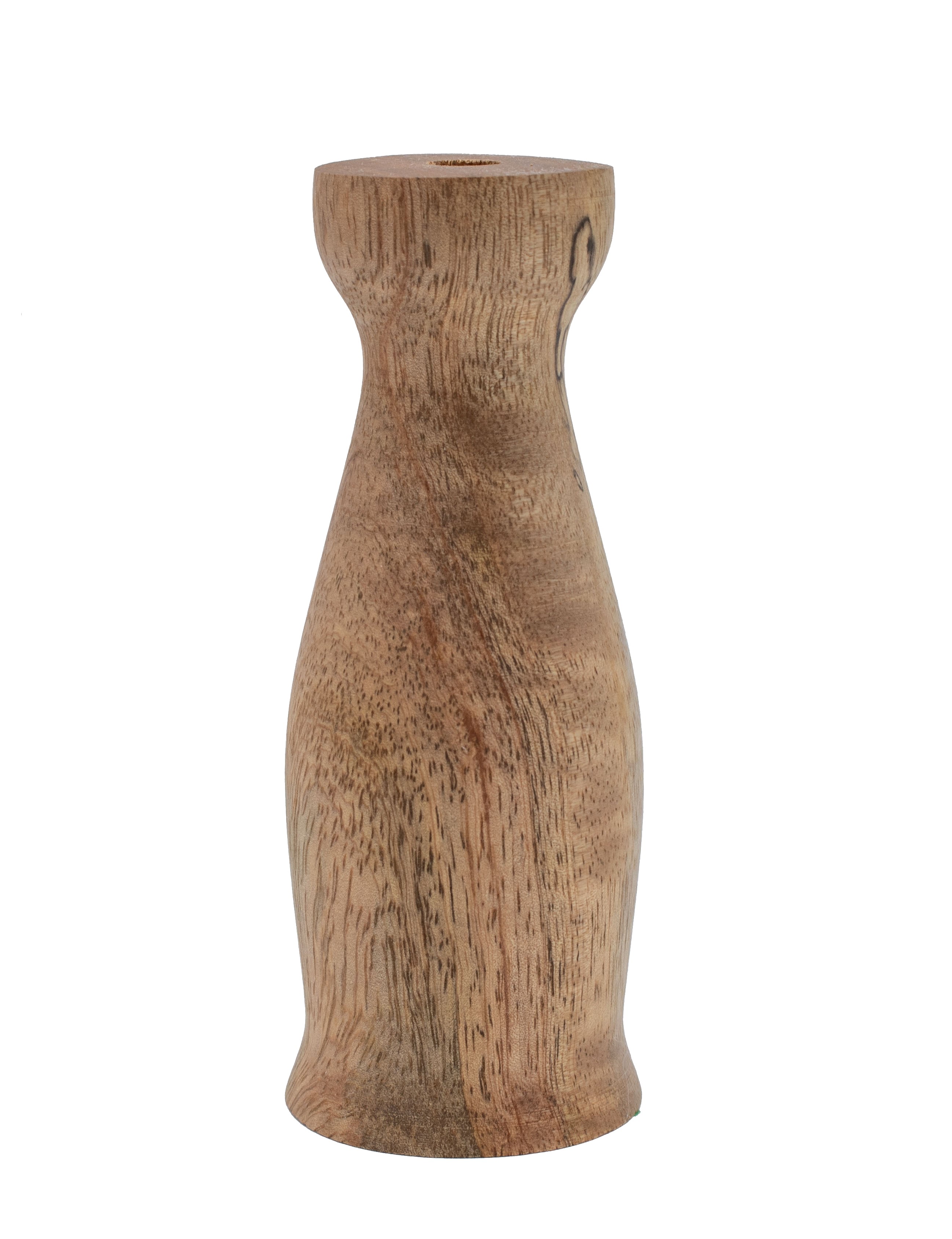
D24: Mango
Manifera Indica. Endangered/Vulnerable. From Hawaii. Very lightweight and seems porous when turning,
but sands easily to tight, colorful grain. Similar to soft maple in hardness. Dark
flecks throughout, as well as some flame similar to curly maple. Reddish and bluish
streaks through the grain. Very unusual wood, unlike anything else I’ve turned so
far. Used to make ukuleles. Now an imported plantation species from Asia, S. America,
and Australia, so readily available. Would work with this species again.
Larger view 1
Larger view 2
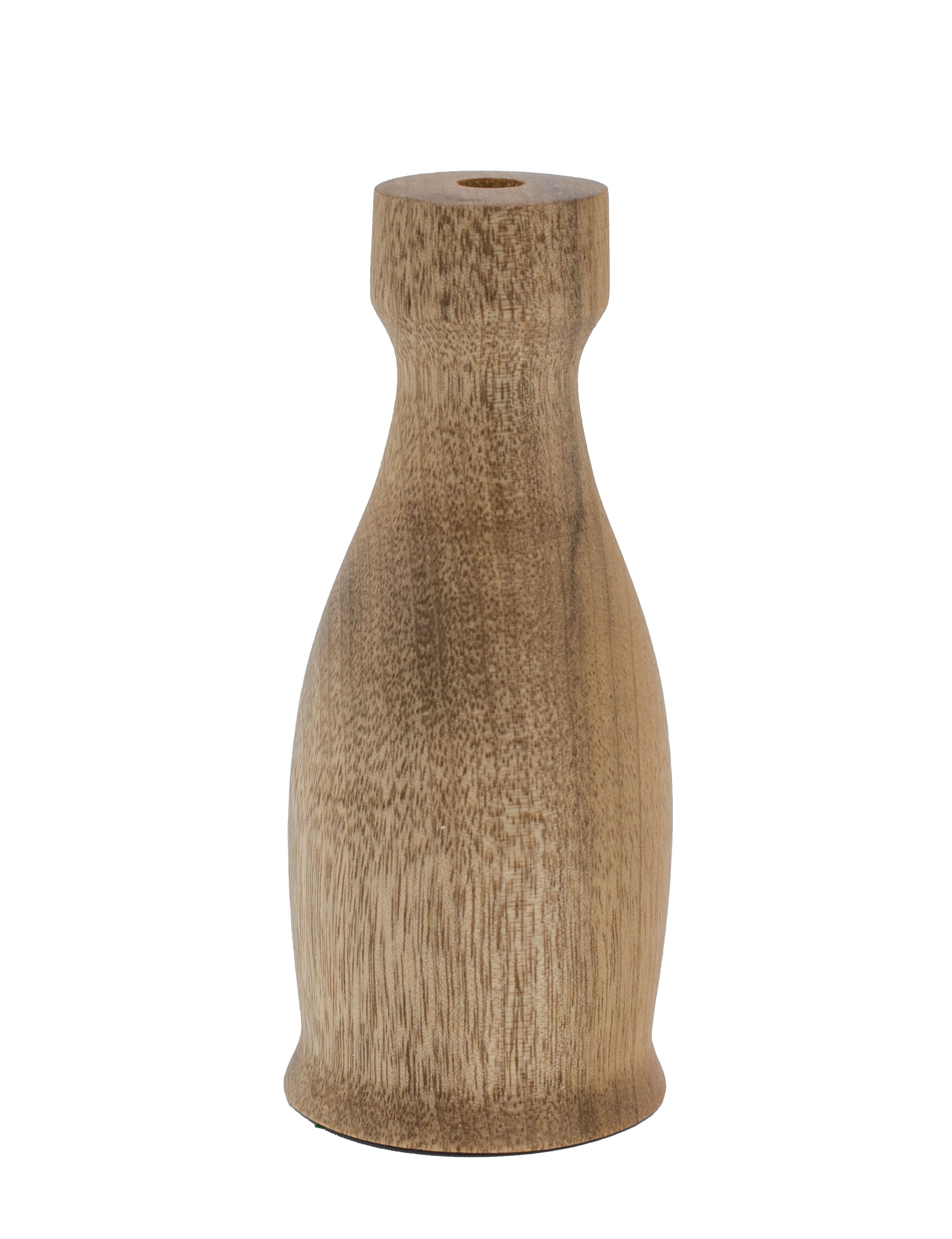
D25: Myrtlewood
Umbrellularia Californica. From Oregon and California. Also called California Laurel, California Bay Laurel,
Pepperwood. Not related to ornamental crepe myrtle. A grayish tan with dark brown
streaks. Relatively soft for a hardwood. Turns easily, but drills hot and is prone
to burning when sanded. Polishes very well. Still is considered a premium domestic
wood used for veneer, fine furniture, musical instruments, gunstocks, and turning.
Would work with this species again.
Larger view 1
Larger view 2
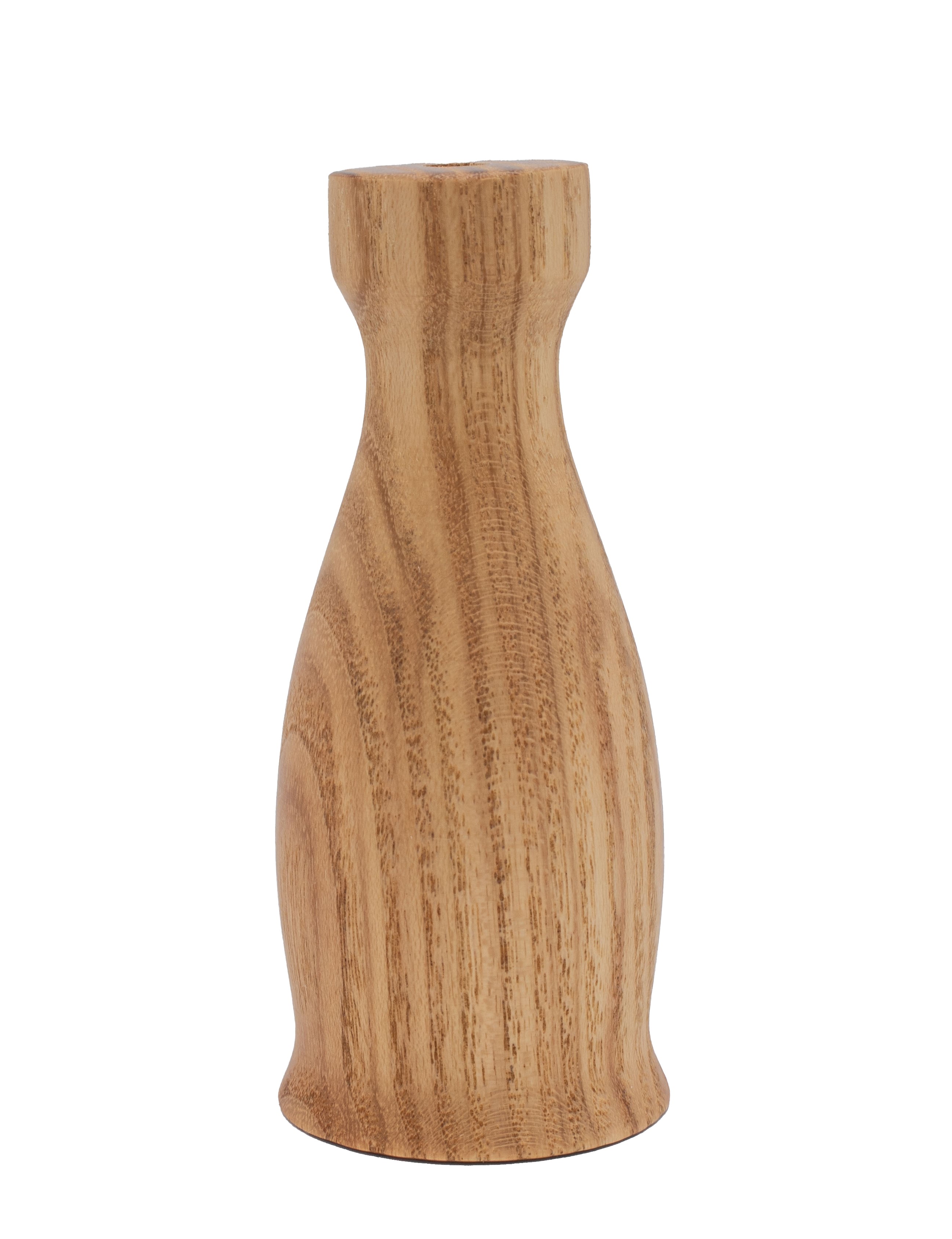
D26: Honey Locust
Gledistsia Triacanthos. Also called Thorny Locust, Hedge Iron, Jesus Tree. The fearsome “thorn tree” of my
W. Kentucky childhood with long dark, branched thorns growing out of the trunk. Inaccurately
believed by some to be the source of the Crown of Thorns worn by Jesus. Native to
North America. Wood is extremely hard and rot-resistant, so cultivated and prized
by farmers for fence posts. In preindustrial America, the thorns themselves were used
as nails, and the wood was used for wooden pegs (treenails) in shipbuilding. While
it has an interesting history, it is a poor turning wood. It is very coarse with large
open pores, and it drills hot. However, it sands easily and finishes to look much
like oak. Would hesitate to work with this species again.
Larger view 1
Larger view 2
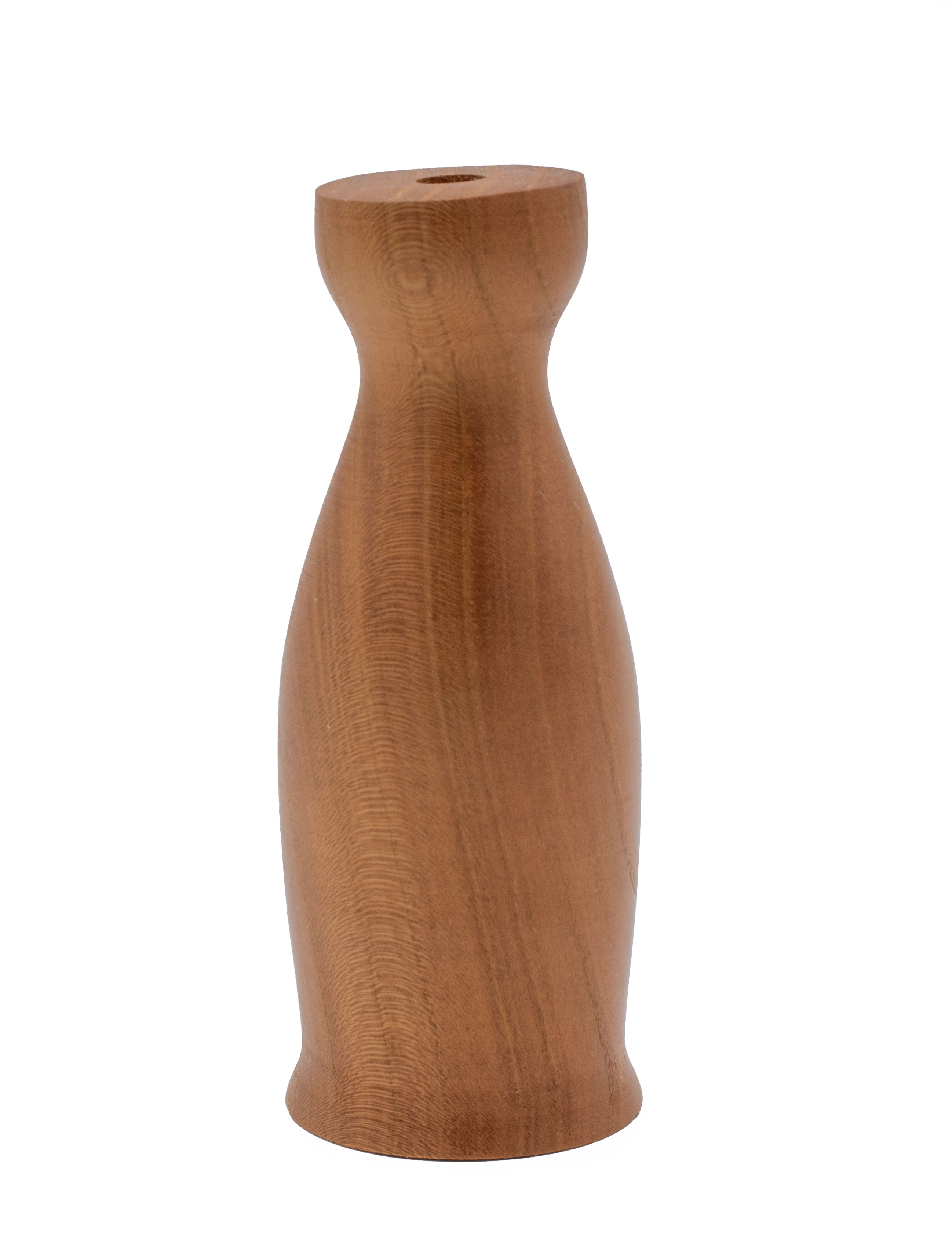
D27: Apricot
Prunus Armeniaca. Related to cherry, but harder and heavier. Absolutely wonderful turning wood and very
handsome when finished. Works much like hard maple. Dense strong wood with tight grain.
Works, sands, and drills easily. Beautiful yellow-orange wood with light brown grain.
Pricey and hard to find, but would work with this species again.
Larger view 1
Larger view 2
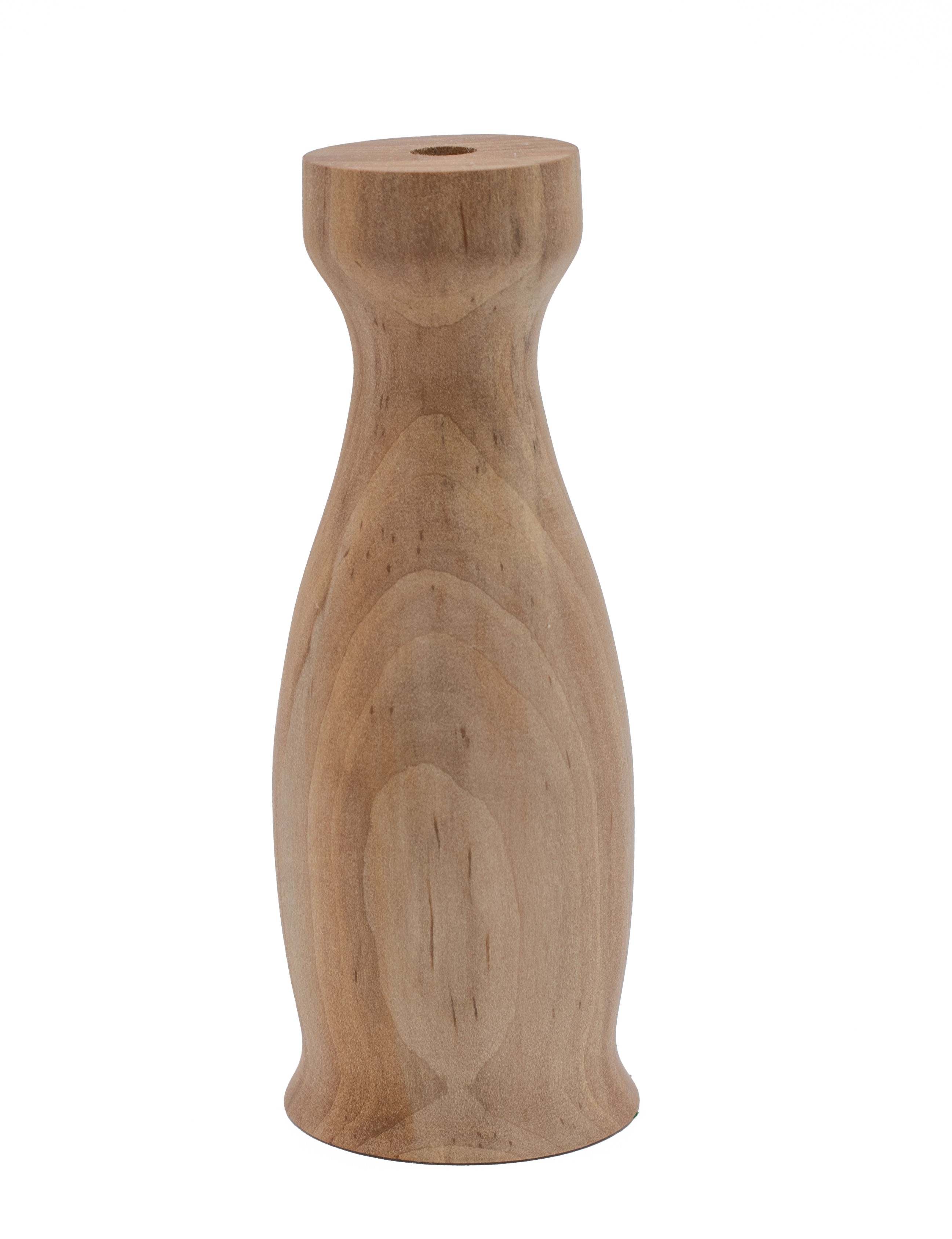
D28: Apple
Malus spp. Includes all domestic and wild versions, including crabapple. An excellent turning
wood. Handsome golden brown with subtle streaks in its tight grain. Very easy to work
and sand and drill. Works much like cherry. Would work with this species again.
Larger view 1
Larger view 2

D29: Mulberry
Morus spp. Includes all varieties and colors. Similar characteristics to Osage Orange. Bright
yellow with prominent grain, similar to ash, but pores not as open. However, like
Osage Orange, it loses those vibrant colors with time and ages to an even light brown.
Moderately hard but works and sands easily. Slightly waxy so drills hot. Works much
like walnut. An uncommon hard wood that works well. Would work with this species again.
Larger view 1
Larger view 2

D30: Staghorn Sumac
Also called Red Sumac, Shoemake. Not poisonous like white sumac. As lightweight as
poplar but stronger with tighter grain. Turns and sands very easily. Light olive color
with very dark and prominent grain and some orange streaks. Would work with this species
again.
Larger view 1
Larger view 2
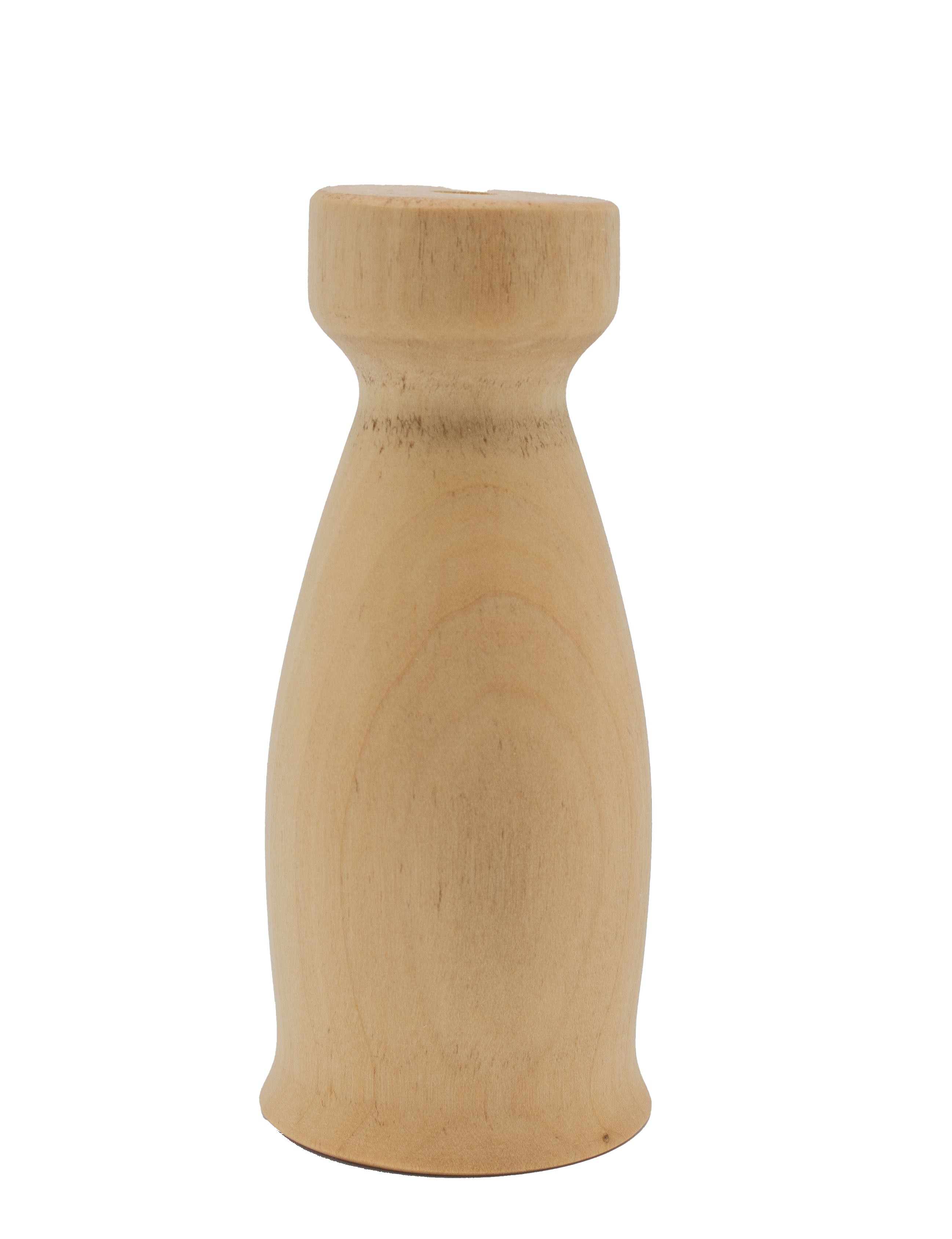
D31: Privet
Ligustrum Vulgare. Excellent turning wood. Pale ivory to peach color. Lightweight and soft and requires
a light touch, but fine-grained. Sands, drills, and finishes easily. Very common as
shrubbery but rarely available commercially due to small size of trunks. Sample from
Mickey Luck. Would work with this species again.
Larger view 1
Larger view 2
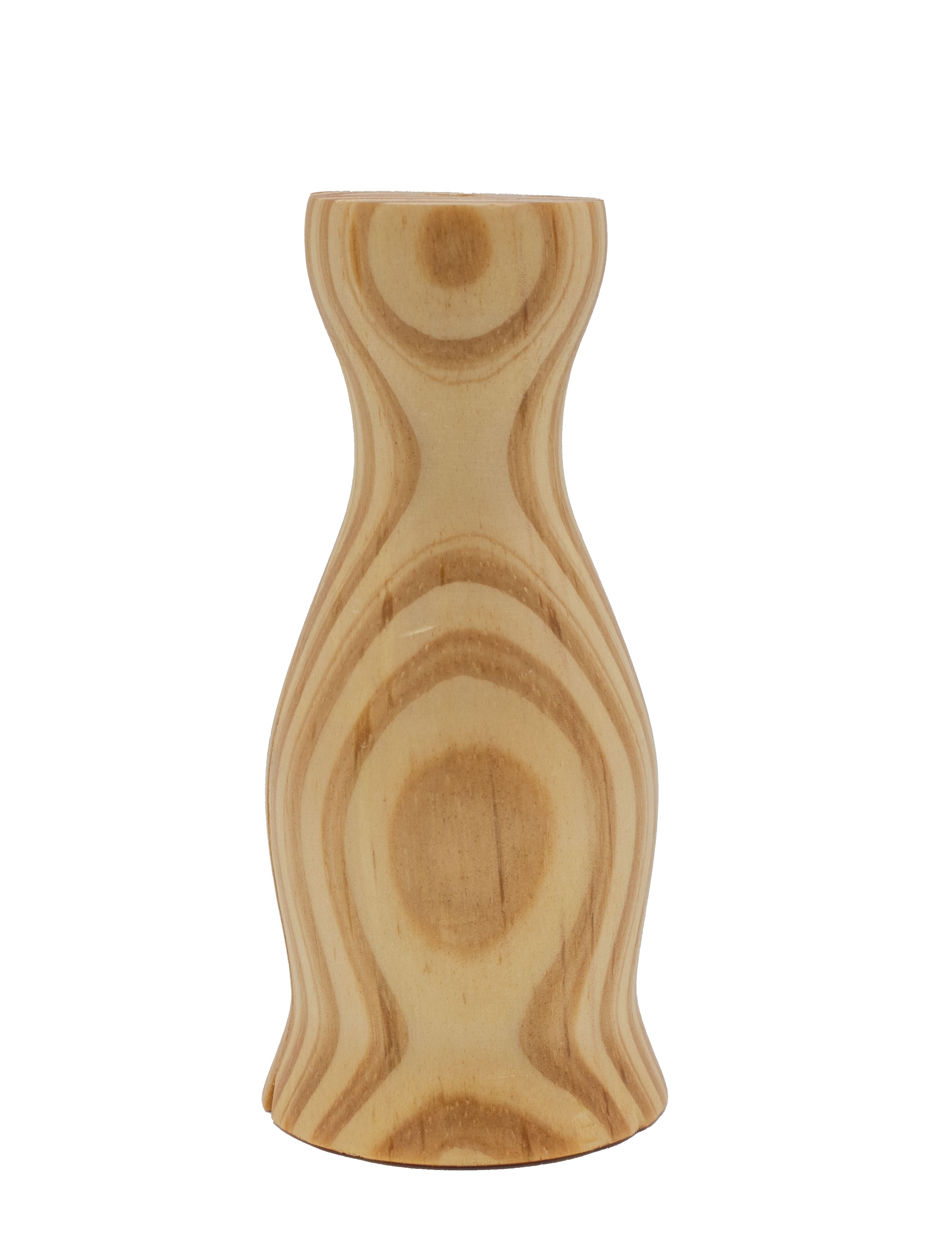
D32: Southern Yellow Pine
Southern Yellow Pine--Pinus spp. Marketing name for a group of at least 10 Southern Hard Pines sold together and virtually
indistinguishable as lumber. Turns surprisingly well with sharp tools and a light
touch. Works a little like poplar but heavier. May even be stronger than poplar. Much
harder and heavier than White Pine and the other Soft Pines. Grain is much harder
than rest of the wood. Sands easily and finishes well. Readily available locally.
Would avoid working with this species.
Larger view 1
Larger view 2
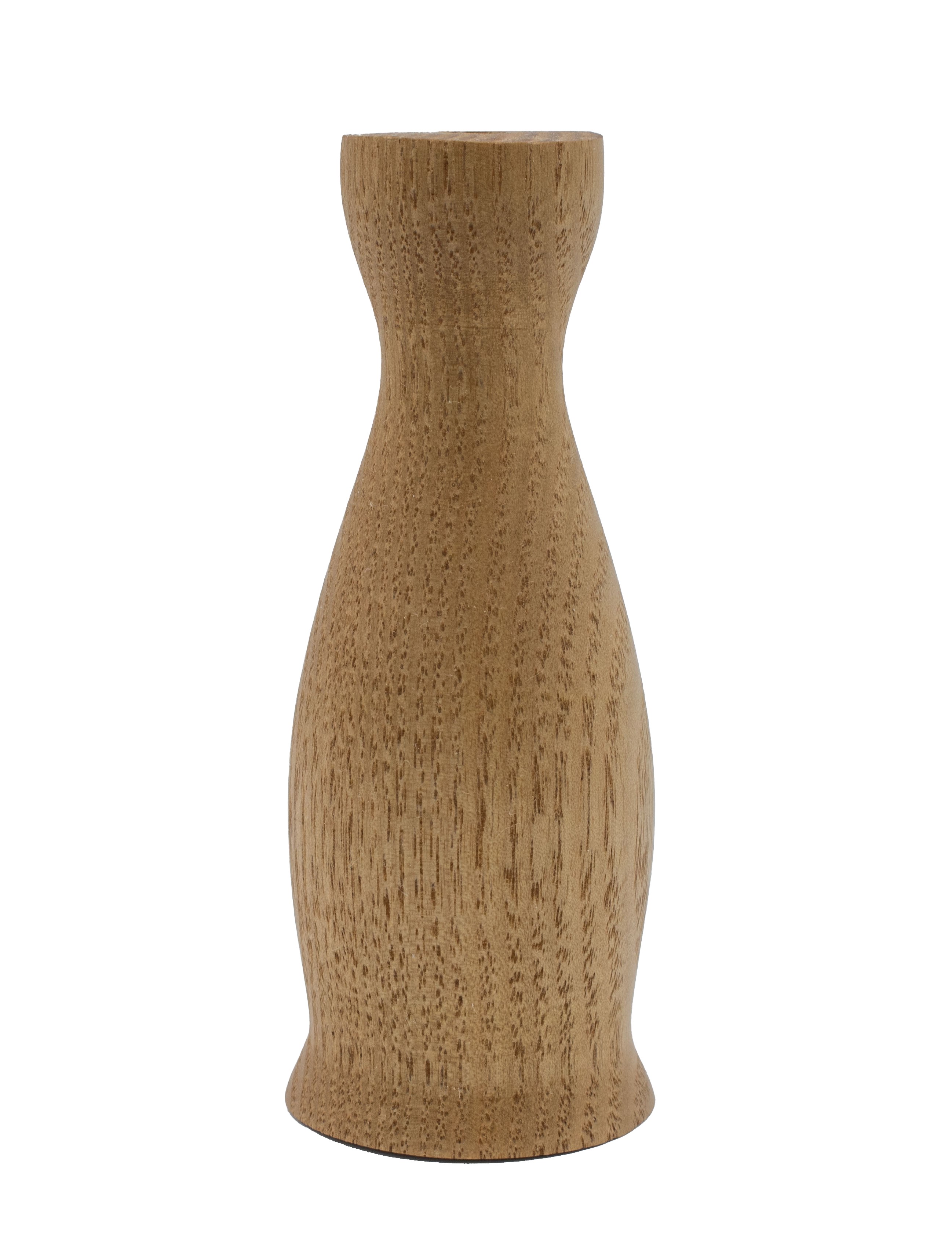
D33: Sassafras
Sassafras Albidum. Pretty porous and requires a lot of sanding. Not as porous as oak but about like butternut
or ash, although softer than either. Resembles ash when finished but doesn’t polish
as well. I would probably just use locally available ash instead of this. While being
worked, its odor is the same as sassafras tea. Would avoid working with this species.
Larger view 1
Larger view 2
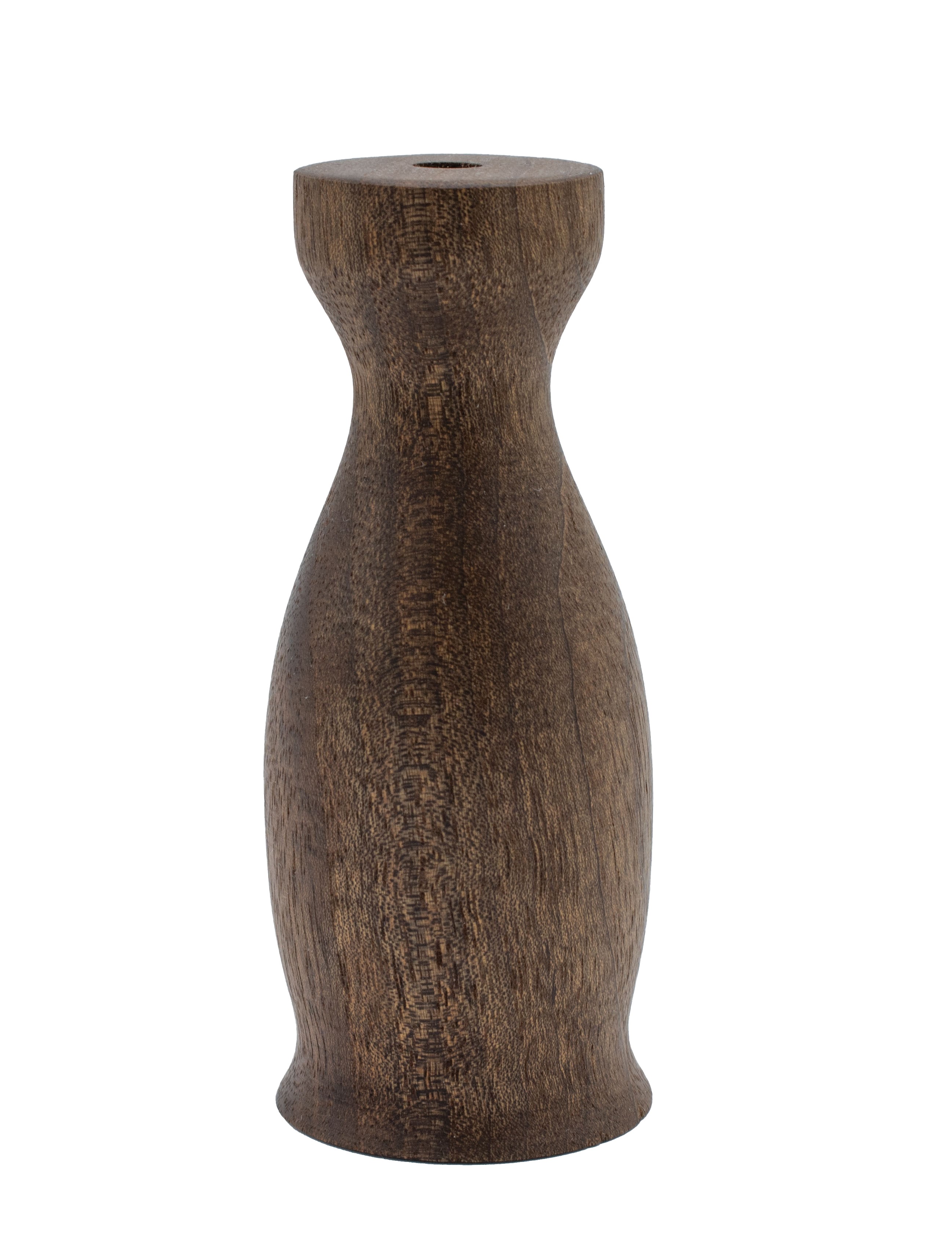
D34: Claro Walnut
Juglans hindsii. Endangered/Vulnerable. Works the same as Black Walnut (see D7). More silvery brown
then black walnut, and grain is blacker and more prominent. From West Coast and often
grafted onto black walnut root stock. Highly prized for expensive gunstocks and musical
instruments. Would work with this species again.
Larger view 1
Larger view 2
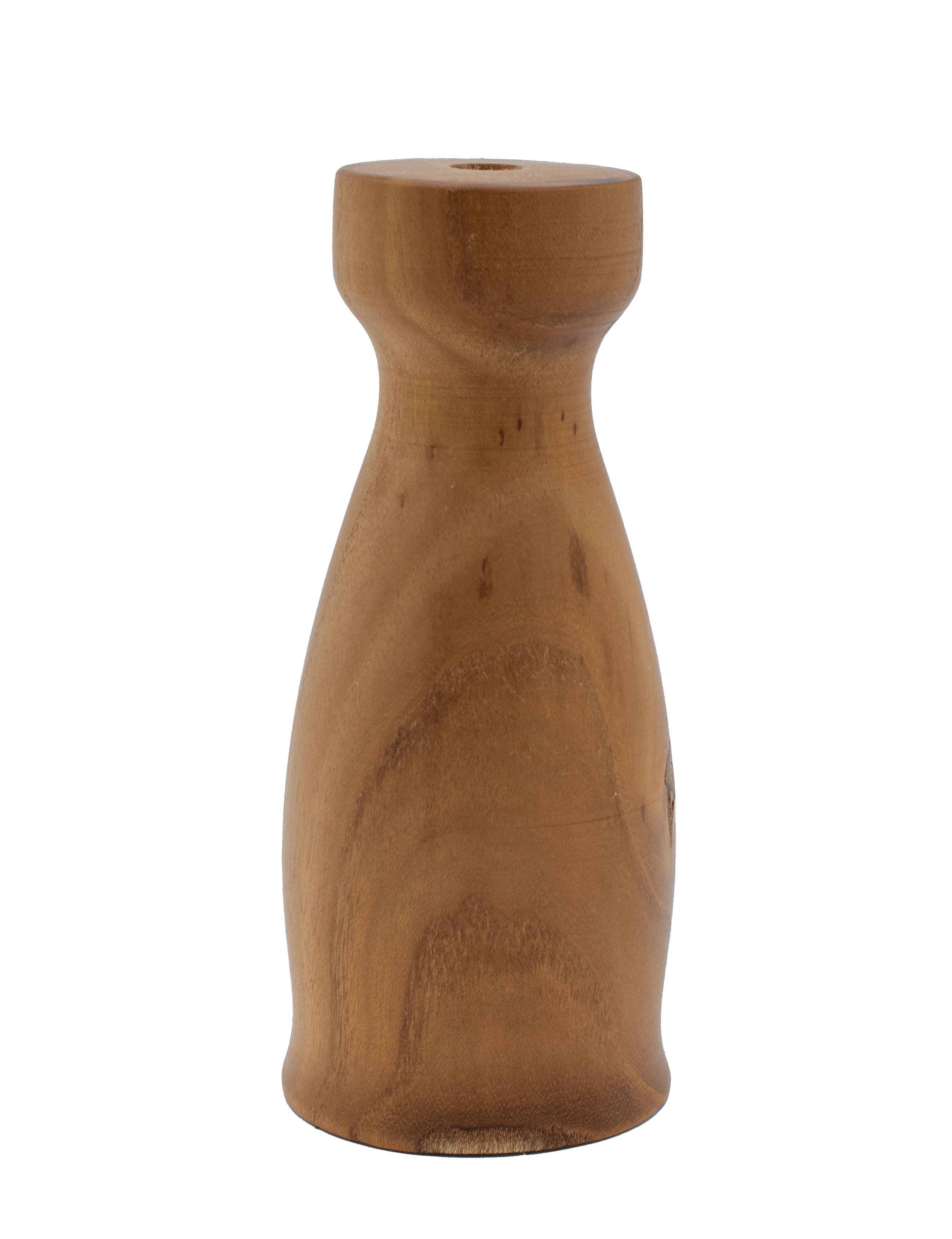
D35: Redbud
Cercis Canadensis. Also called Eastern Redbud, Spicewood. Beautiful golden wood with dark brown contrasting grain. Can have some curl in the
grain, similar to beech. Somewhat coarse-grained and brittle, so requires a light
touch. Sands okay, but burns easily on belt sander. A small native tree often planted
as an ornamental, but seldom grows large enough to yield substantial lumber. Sample
from Gunnar Barnes. In spite of its difficulties, would work with this species again.
Larger view 1
Larger view 2
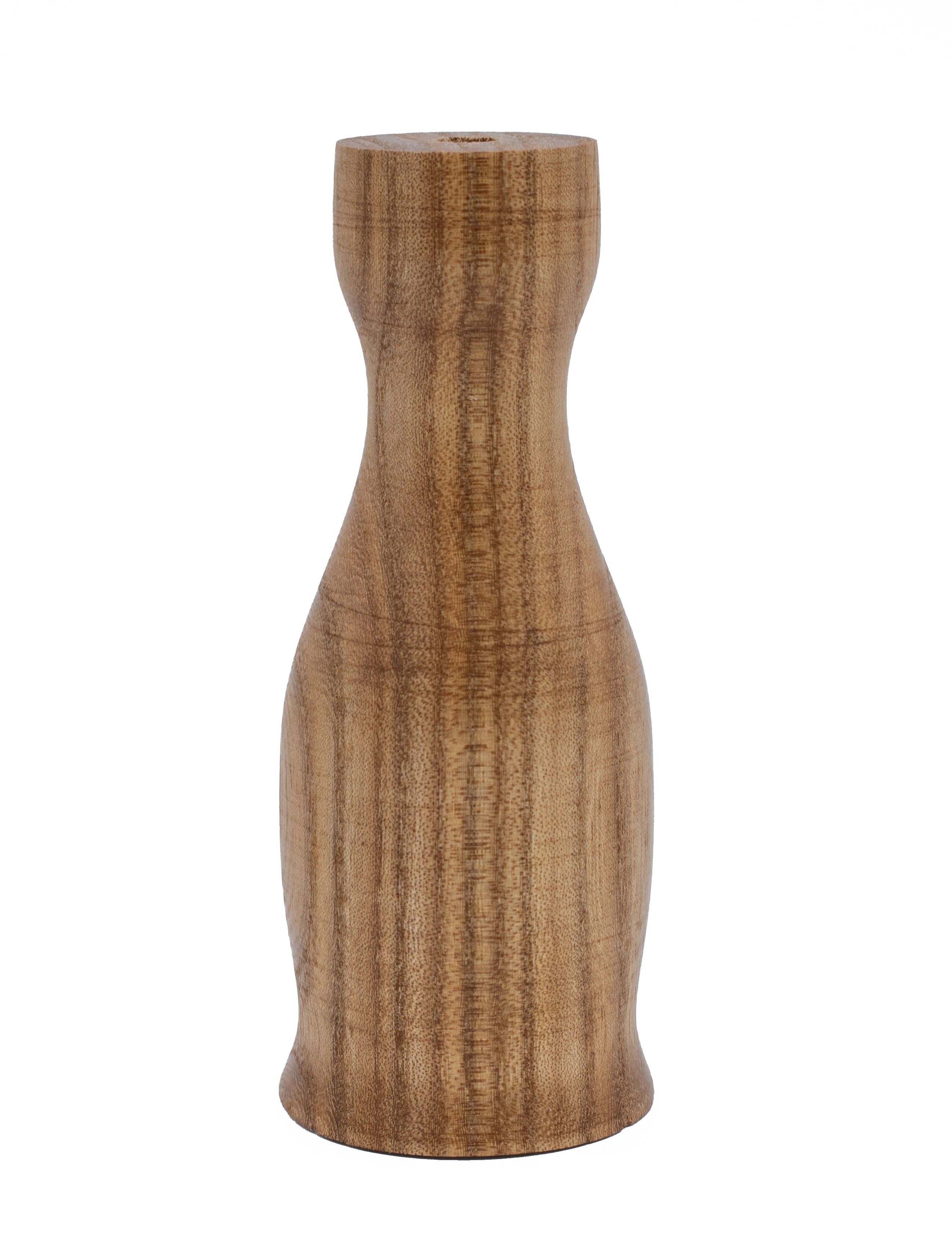
D36: Red Elm
Ulmus rubra. Also known as Slippery Elm and one of the soft elms. Similar to white ash when finished
but with tighter grain. Silvery tan with brown grain, halfway between white ash and
butternut. Contrast is subtle and not as pronounced as imported zebrawood, but quite
handsome. Has an attractive feathery secondary grain. Very tough wood that is somewhat
difficult to work due to interlocking fibers that also make it extremely difficult
to split. So tough that it was used for the hubs of wagon wheels and the rollers on
pulleys. Also, the yoke on the Liberty Bell is slippery elm. Sanding is difficult
for the same reason, and it will heat up rapidly and can burn easily with power sanding.
Has a strong unpleasant odor when green, but little when fully dried, and none when
finished. However, excellent handsome final product makes it worth the extra work.
Would work with this species again.
Larger view 1
Larger view 2
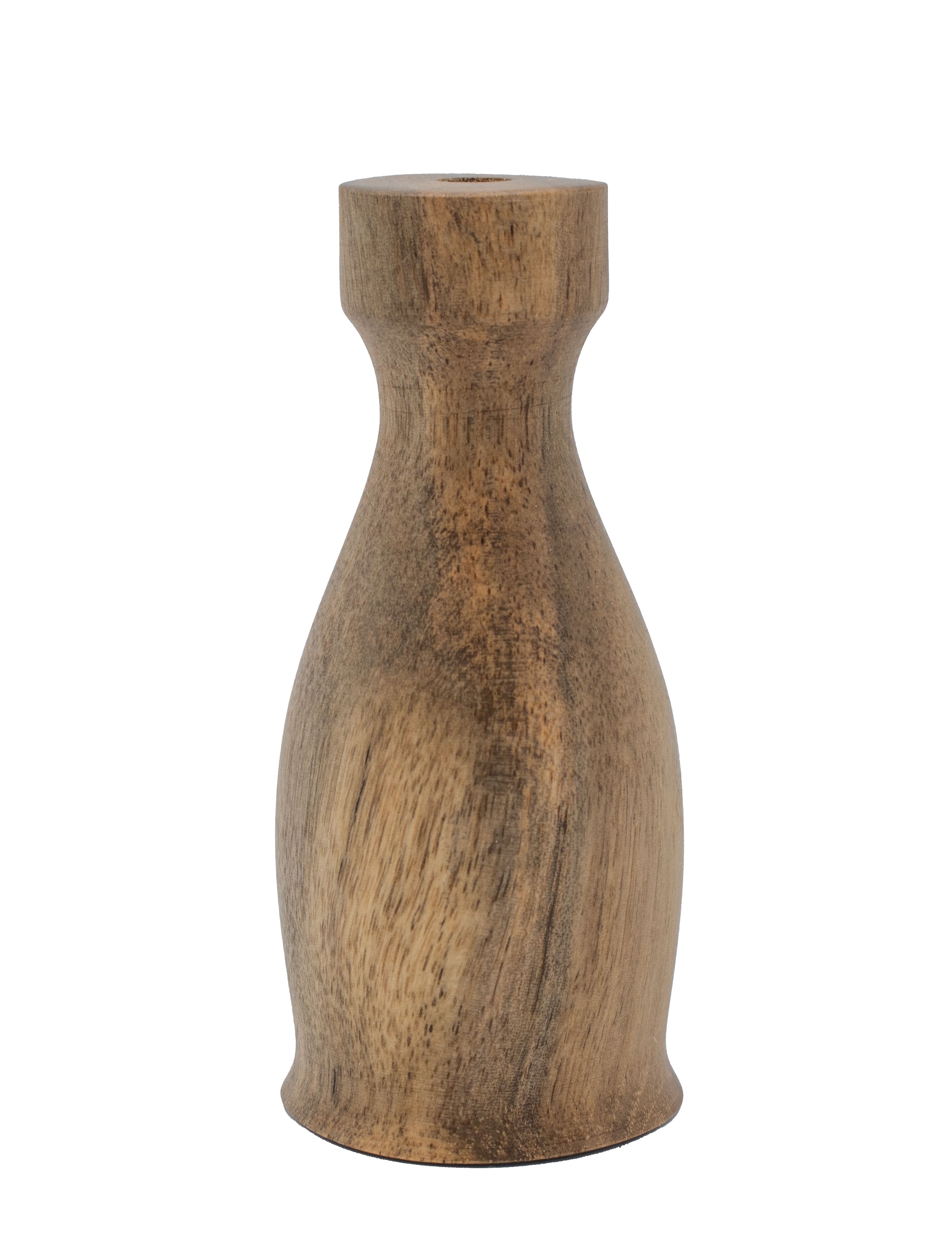
D37: Persimmon
Diospyros Virginiana. A true ebony. Also called White Ebony and American Ebony. Mottled tan and grayish
brown and whitish streaks. Looks somewhat like hackberry but not related. While very
hard, it turns easily and sands and polishes very well. Drills very hot. Used for
turning, golf club heads, and veneer. Sample from Phil Sparks. Would work with this
species again.
Larger view 1
Larger view 2

D38: Pear
Pyrus spp. Includes all varieties of pear, including European species such as Swiss Pear and
Asian species such as Bradford Pear and its many variations. An excellent turning
wood with fine close grain and shades of tan, gold, light brown. Light curl possible.
Turns, sands, drills, and finishes well. Unusually tight bark can be turned as here.
Bradford pears are widely used in the U.S. as an ornamental suburban tree but are
short-lived and prone to storm damage. Bradford pears and related varieties are becoming
invasive in many states. Pear wood is exported from U.S. to Europe where it is popular
as a premium wood used much like we use cherry for veneers, furniture, musical instruments,
turnings, etc. Would work with this species again.
Larger view 1
Larger view 2
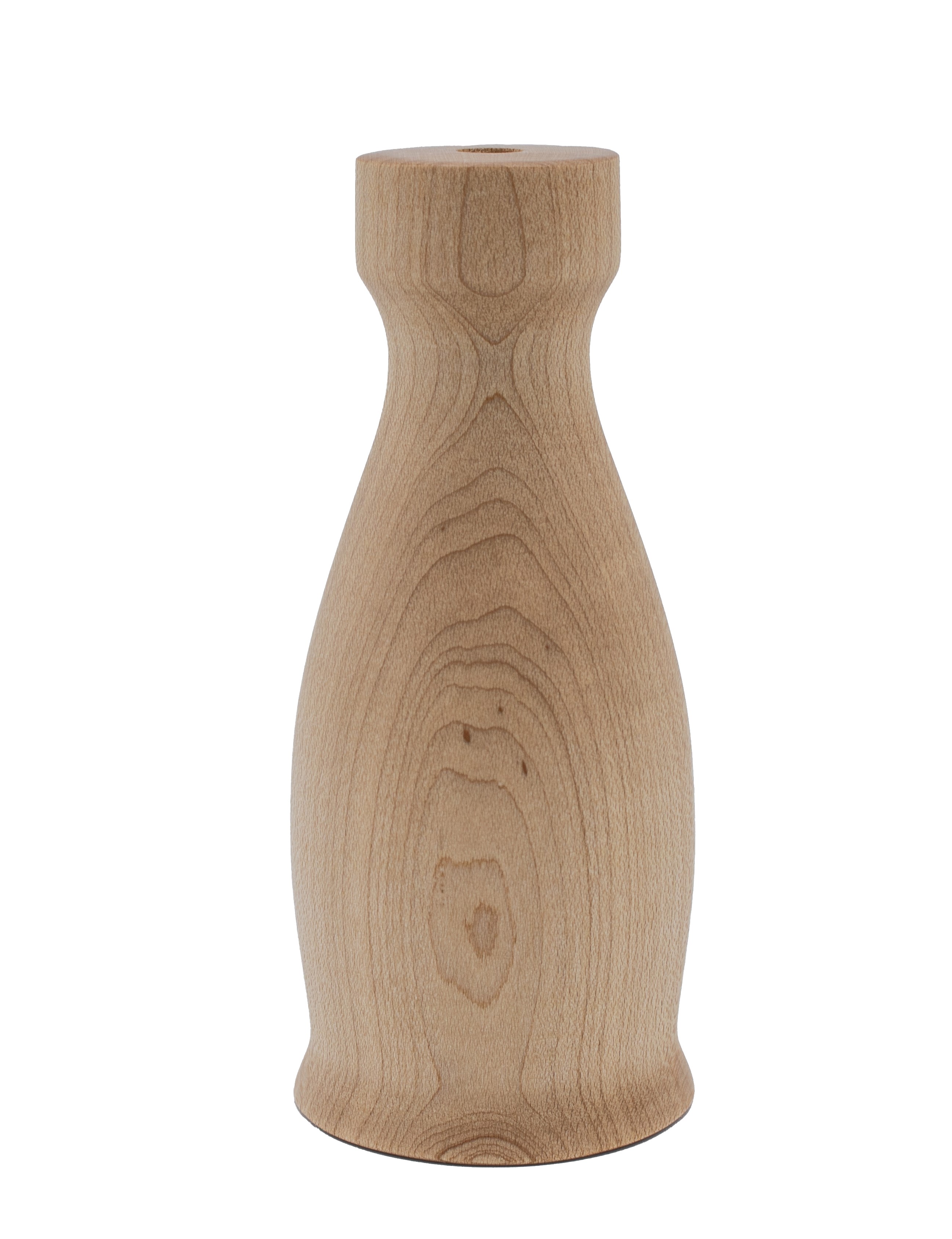
D39: Birch
Betula spp. From Northeastern North America and across northern Europe. Turns, sands, and finishes
much like soft maple, but drills hot. Light tan with close grain. Some figuring possible.
Excellent turning wood. Extremely common. Used as a utility hardwood and widely used
for veneers for doors, furniture, and paneling. Would work with this species again.
Larger view 1
Larger view 2
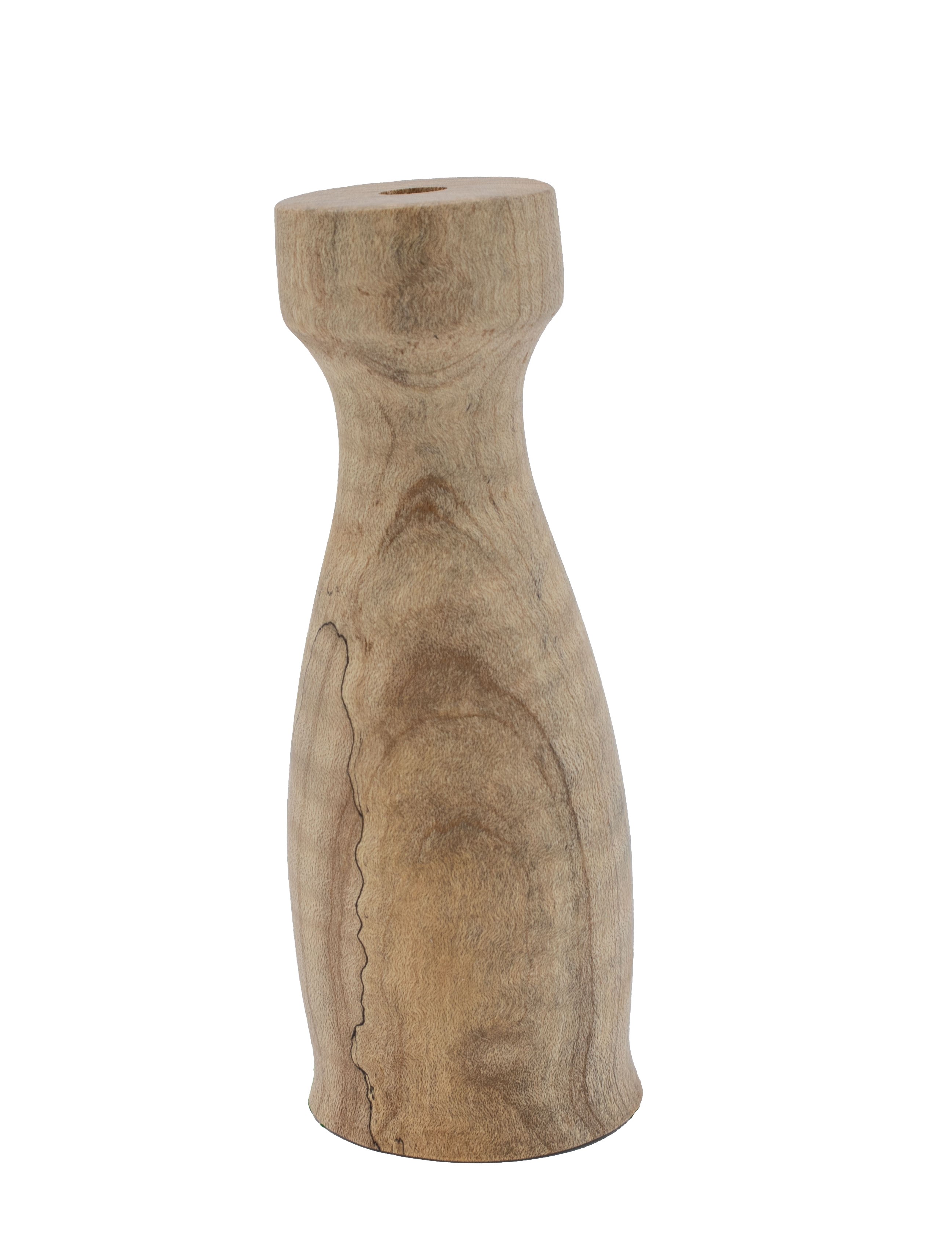
D40: Spalted Curly Hard Maple
Acer Saccharinum. Highly prized version of Hard Maple, D 4 above. Same working characteristics. Very
distinctive and attractive grain. Pricey and much prized by woodworkers and luthiers.
Sample from Phil Sparks. Would work with this species again.
Larger view 1
Larger view 2
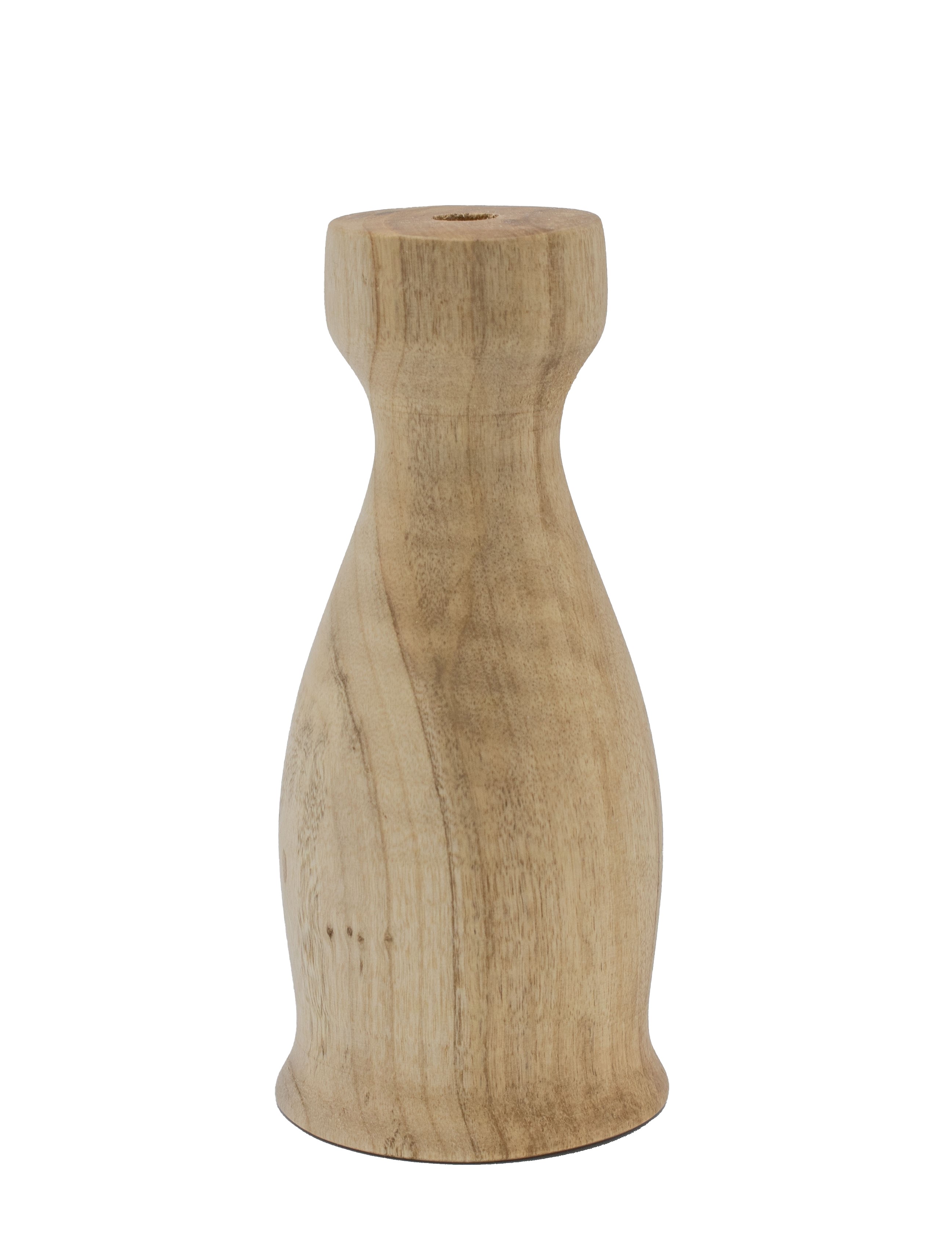
D41: Crepe Myrtle
Lagerstroemina spp. Also called Pyinma and Asian Satinwood. Native to S.E. Asia, but widely planted in
American South as an ornamental shrub or small tree. Requires a light touch in turning,
but sands, drills, and finishes well. A beautiful mixture of tans and golds with darker
grain. Has prominent curl and resembles curly maple. Most of the imported stock shows
high degree of curly grain. Available as an import, but not a commercial domestic
species. Sample from Randy Rushing. Would work with this species again.
Larger view 1
Larger view 2
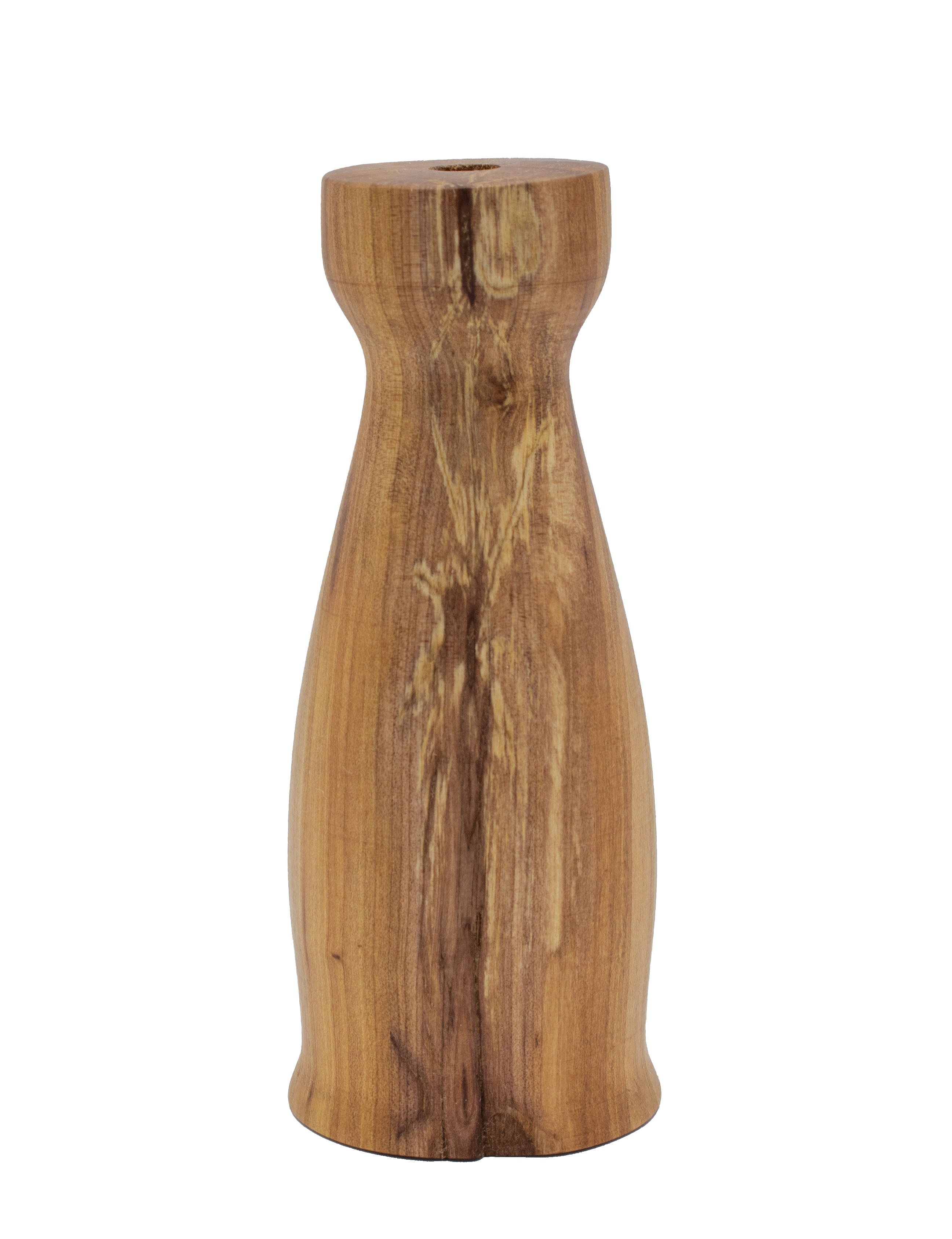
D42: Carolina Buckthorn
Rhamnus spp. An escaped and invasive exotic in N. America, widespread throughout Europe, Asia,
and Africa. Coarse grain that is somewhat brittle. Very handsome and similar in appearance
to sumac and canarywood with yellows, golds, browns, and faint green tones. Sample
from Mickey Luck. In spite of its difficulties, would work with this species again.
Larger view 1
Larger view 2
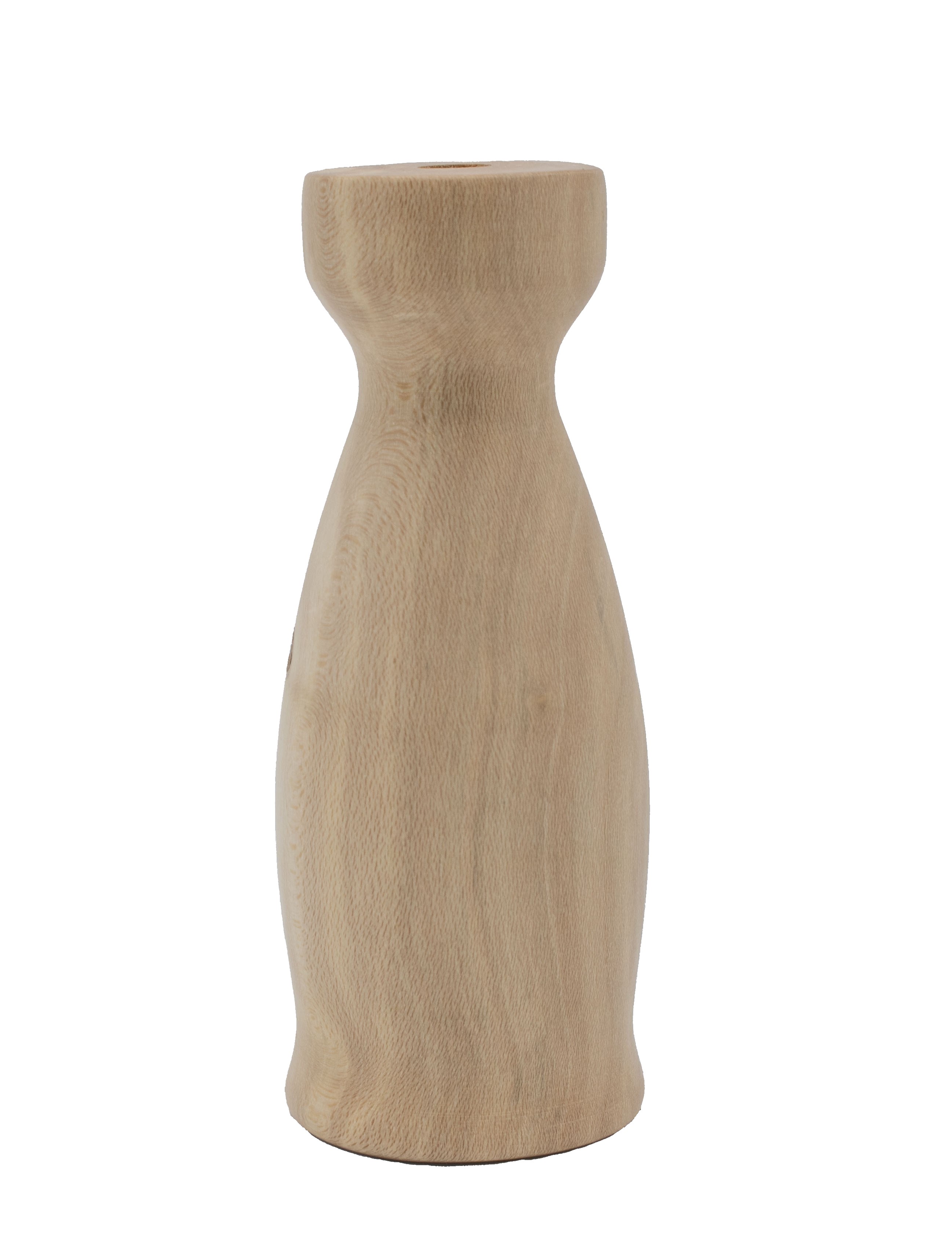
D43: Holly
Ilex opaca. One of the most expensive native woods. Highly prized as whitest American wood. Must be harvested and kiln-dried carefully
to preserve the white color. The bluish-gray and pink on this sample are due to fungal
staining as a result of improper harvesting and drying. Regardless of color, a wonderful
turning wood. Very tight consistent grain with some curl resembling beech. Turns,
sands, drills, and finishes easily. Looks and feels like an ebony. Sample from Leslie
Angel. Would work with this species again.
Larger view 1
Larger view 2
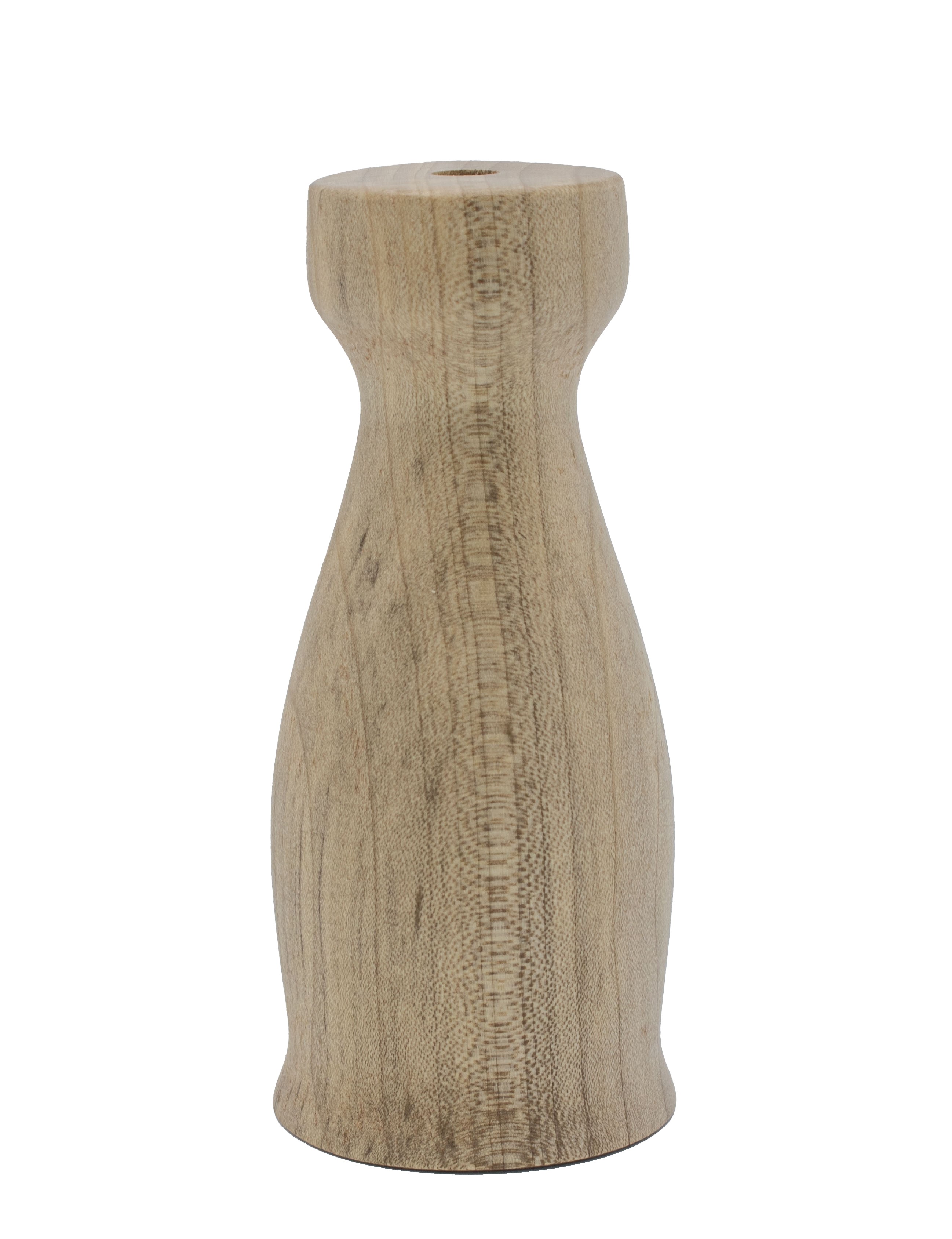
D44: Southern Magnolia
Magnolia grandiflora. Seldom available commercially, but an excellent turning wood. Medium texture and hardness
similar to cherry. Drills, sands, and finishes well. Wide creamy to grayish sapwood
with narrow dark brown heartwood. Looks somewhat like imported limba with less prominent
grain. Widely grown as an ornamental throughout the South. Used for veneers, plywood,
and general utility wood. Sample from Jose Garcia. Would work with this species again.
Larger view 1
Larger view 2
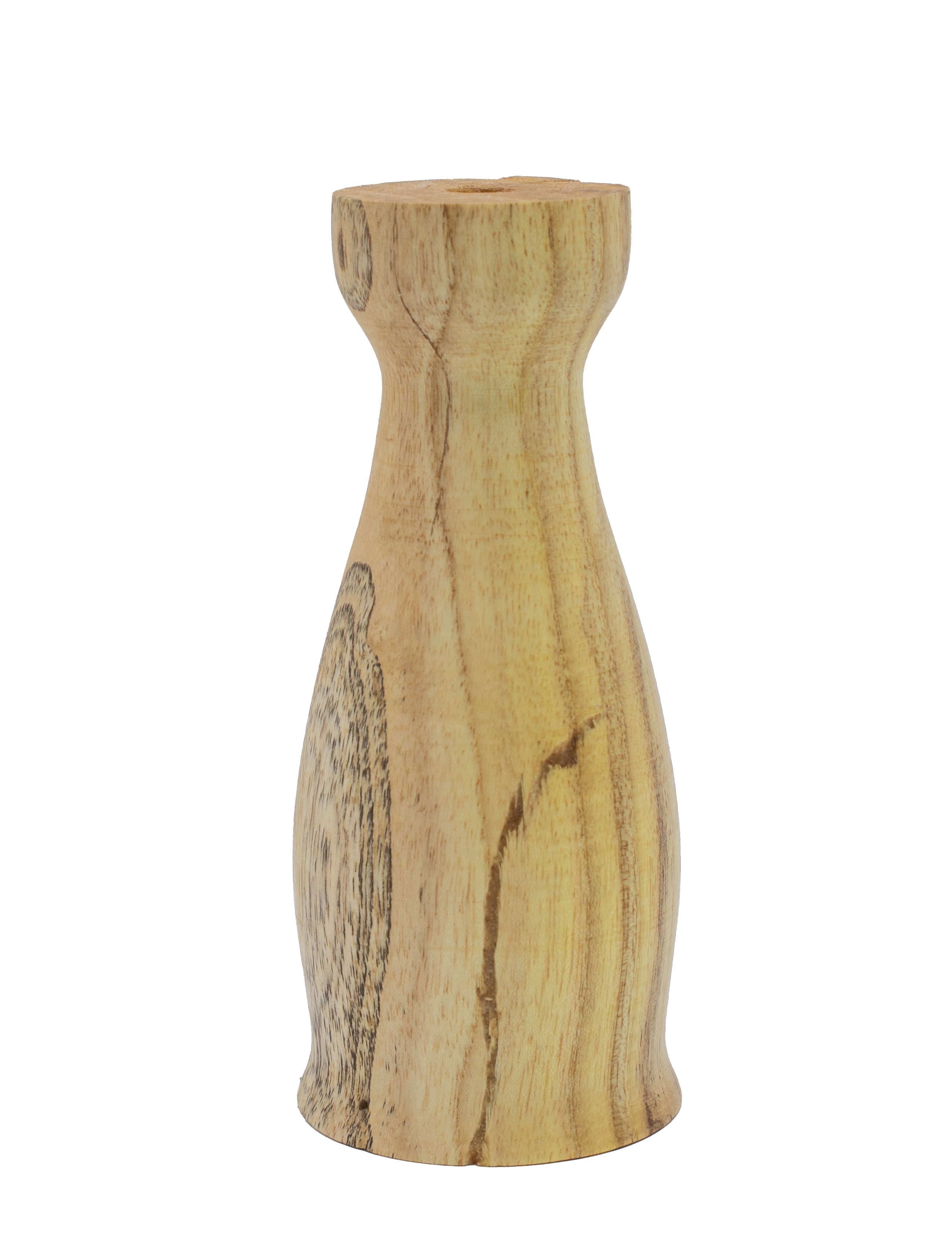
D45: Kentucky Yellowwood
Cladrastis Kentukea. Also called Yellowtree and Virgilia. One of the rarest trees in the wild in the Eastern
U.S. but now grown as an ornamental. Bright yellow sapwood that darkens little with
age. Brown streaks that run through the wood and heartwood is medium brown. Similar
in hardness to soft maple but very bad about splitting. Drills, sands, and finishes
okay. Due to improper drying, this sample is badly damaged, with numerous cracks and
splits and parts glued back together. Ends could not be properly sanded and finished
due to these flaws. Sample from Randy Greenwell. Would work with this species again
only if properly dried.
Larger view 1
Larger view 2
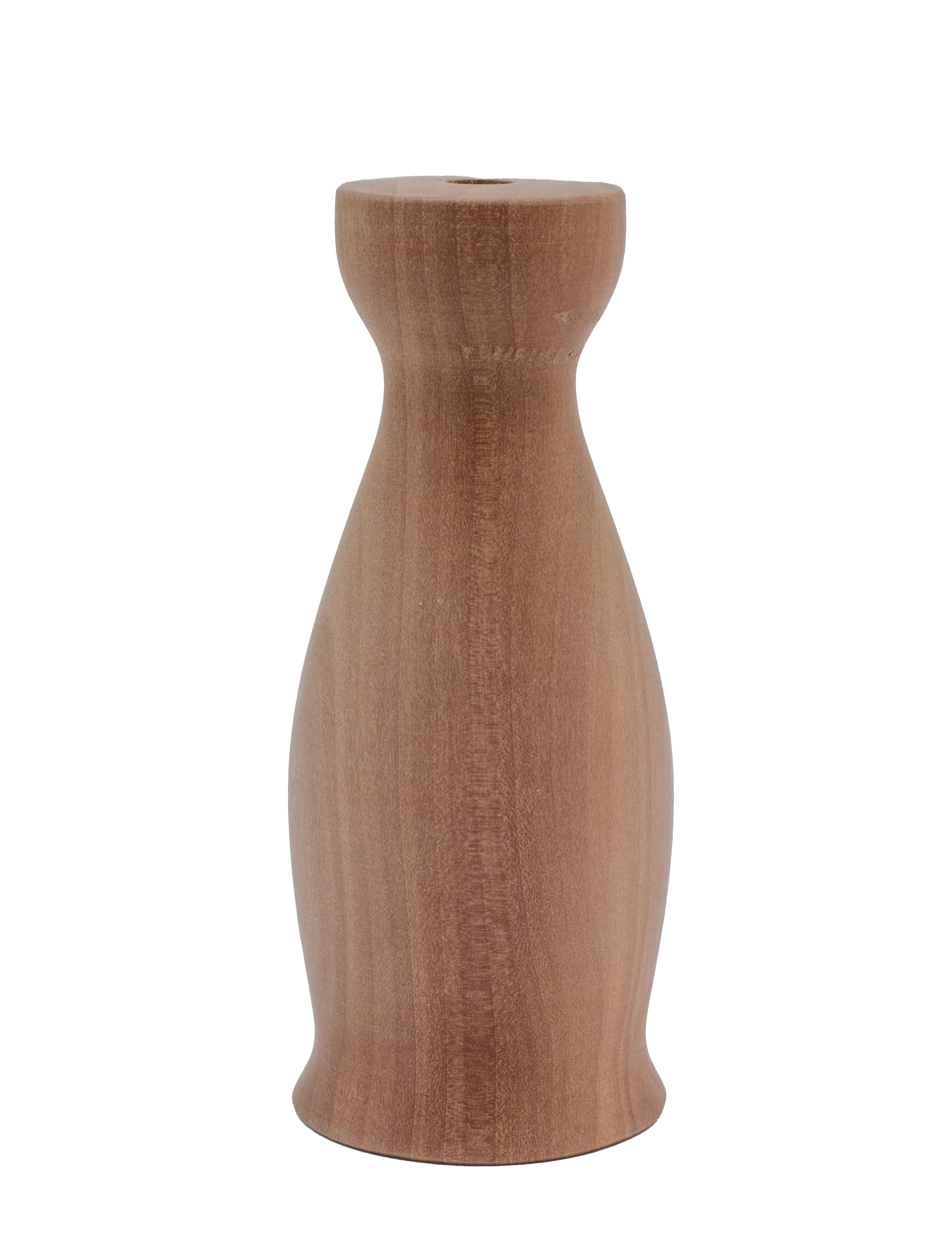
D46: Bald Cypress
Taxodium distichum. Technically a softwood, but works, sands, drills, and finishes much like soft maple.
An excellent turning species, easy to work with overall. A handsome wood mostly tan
but with pink and peach tones, similar in places to fresh cherry. Fine textured with
subtle grain. Sample from Randy Greenwell. Would work with this species again.
Larger view 1
Larger view 2
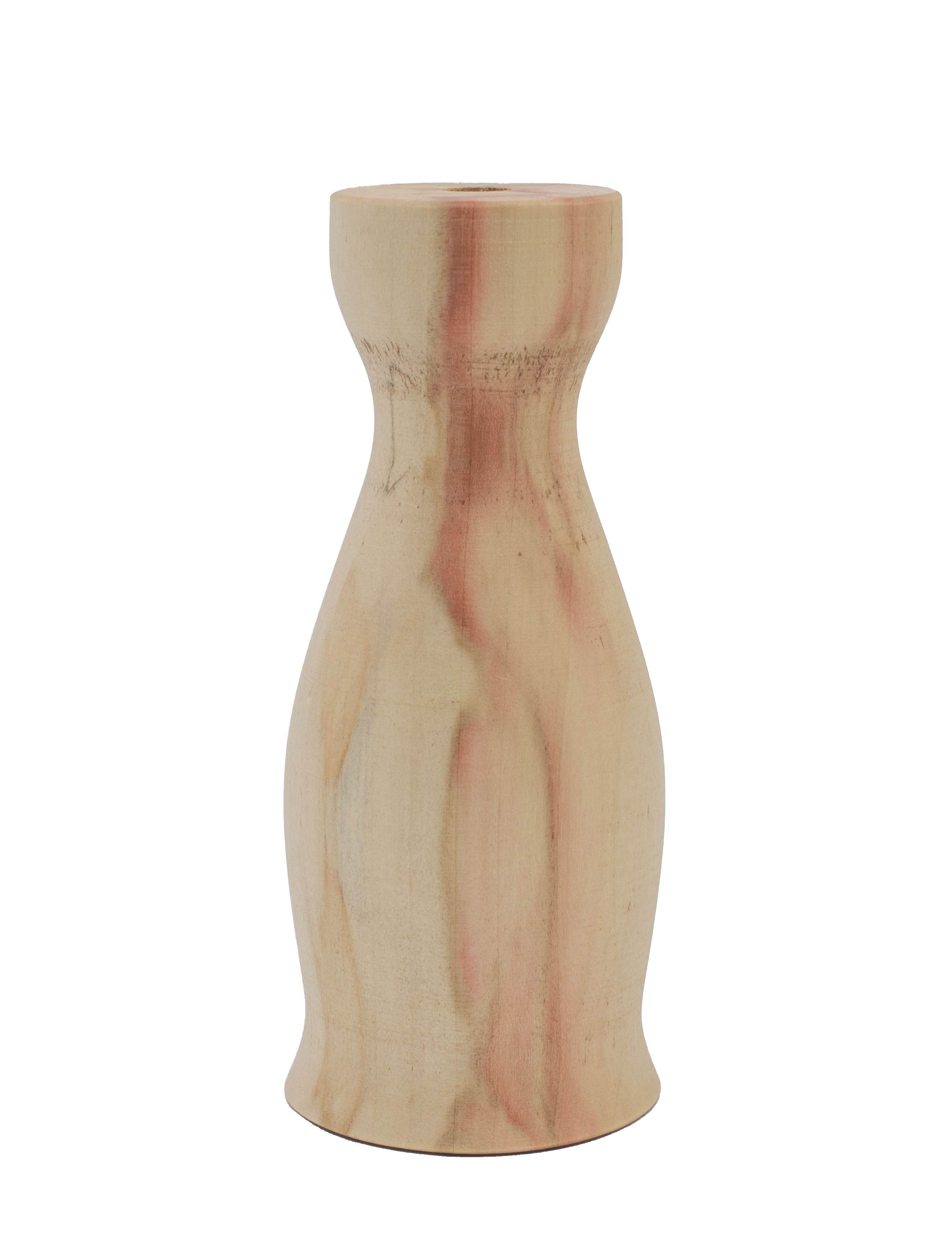
D47: Box Elder
Acer negundo. Also called Manitoba Maple and Ash-leaved Maple. Throughout N. America, but mainly
in central and Eastern U.S. Wood is softer and lighter in weight than most maples.
Very easy to turn and sand, but sharp tools needed. Drills hot but not waxy. Highly
desirable reddish coloring (called flame) is produced when tree is wounded. Can cause
skin irritation and mild respiratory effects. Seldom used in lumber form but prized
by hobbyists. Sample from Randy Greenwell. Would work with this species again.
Larger view 1
Larger view 2
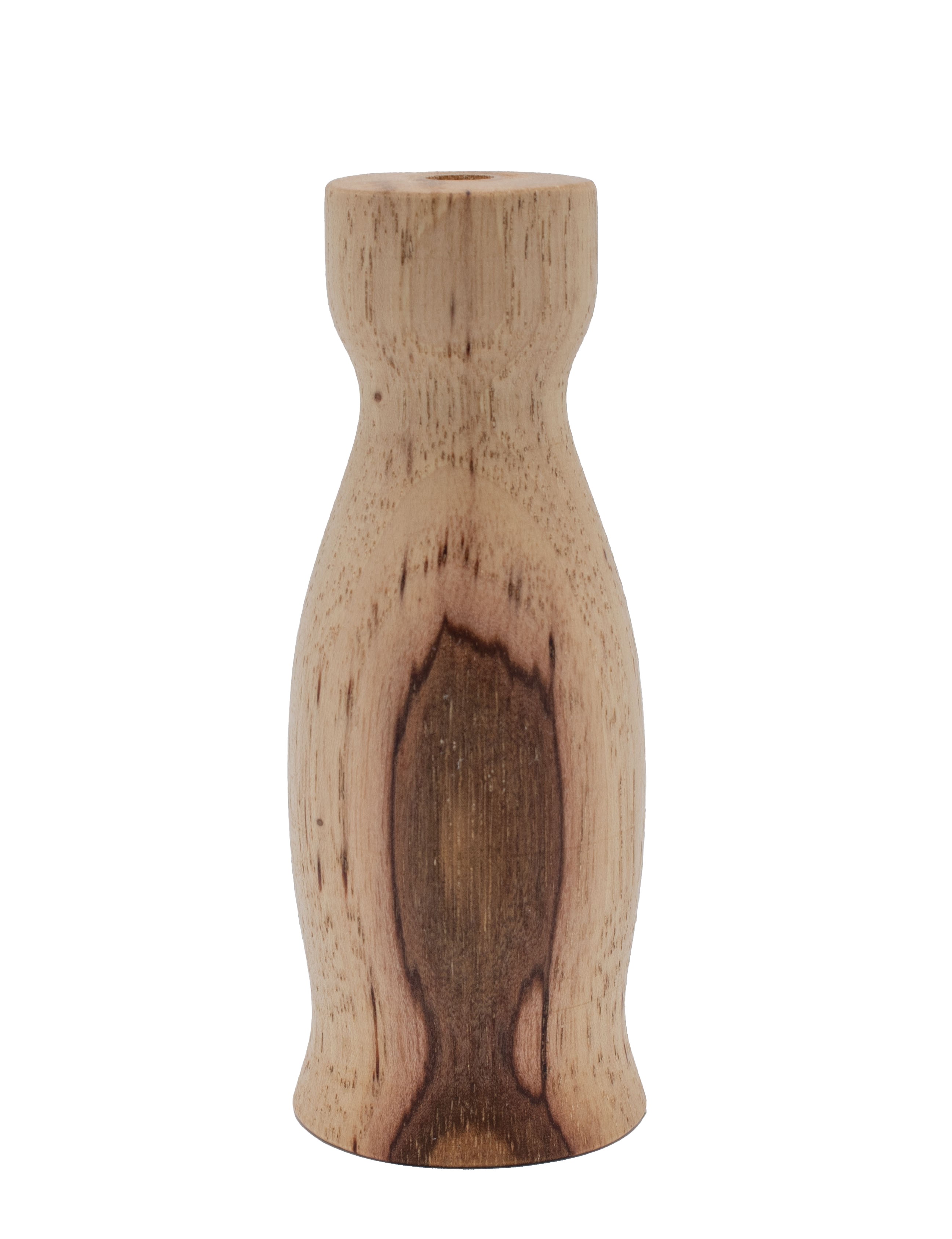
D48: Pecan
Carya illinoinensis. From South-Central U.S. and Mexico. Typically mixed with other
hickories and all marketed as hickory. Very colorful--cream colored with lots of brown
and red flecks and streaks. Works like hickory in all ways. Hard but sands well. Drills
hot but not waxy. Among the hardest and strongest native woods. Used where strength
and shock resistance are needed, such as tool handles, ladder rungs, wheel spokes,
and flooring. Also used for charcoal for grilling meat. Would work with this species
again.
Larger view 1
Larger view 2

D49: Pawpaw
Asimina triloba. From Eastern U.S. Also called Custard Apple, Pawpaw Apple, Indian Banana. Common
small native tree sometimes grown for its large soft fruit that tastes like bananas.
Narrow trunk that yields little usable wood (hence small size of sample), so not harvested
commercially. Wood is light, relatively soft, coarse-grained, and generally weak.
Unusual light greenish-gray color with dark brown grain. Works somewhat like poplar.
Sample from Gunnar Barnes. Would not work with this species again.
Larger view 1
Larger view 2
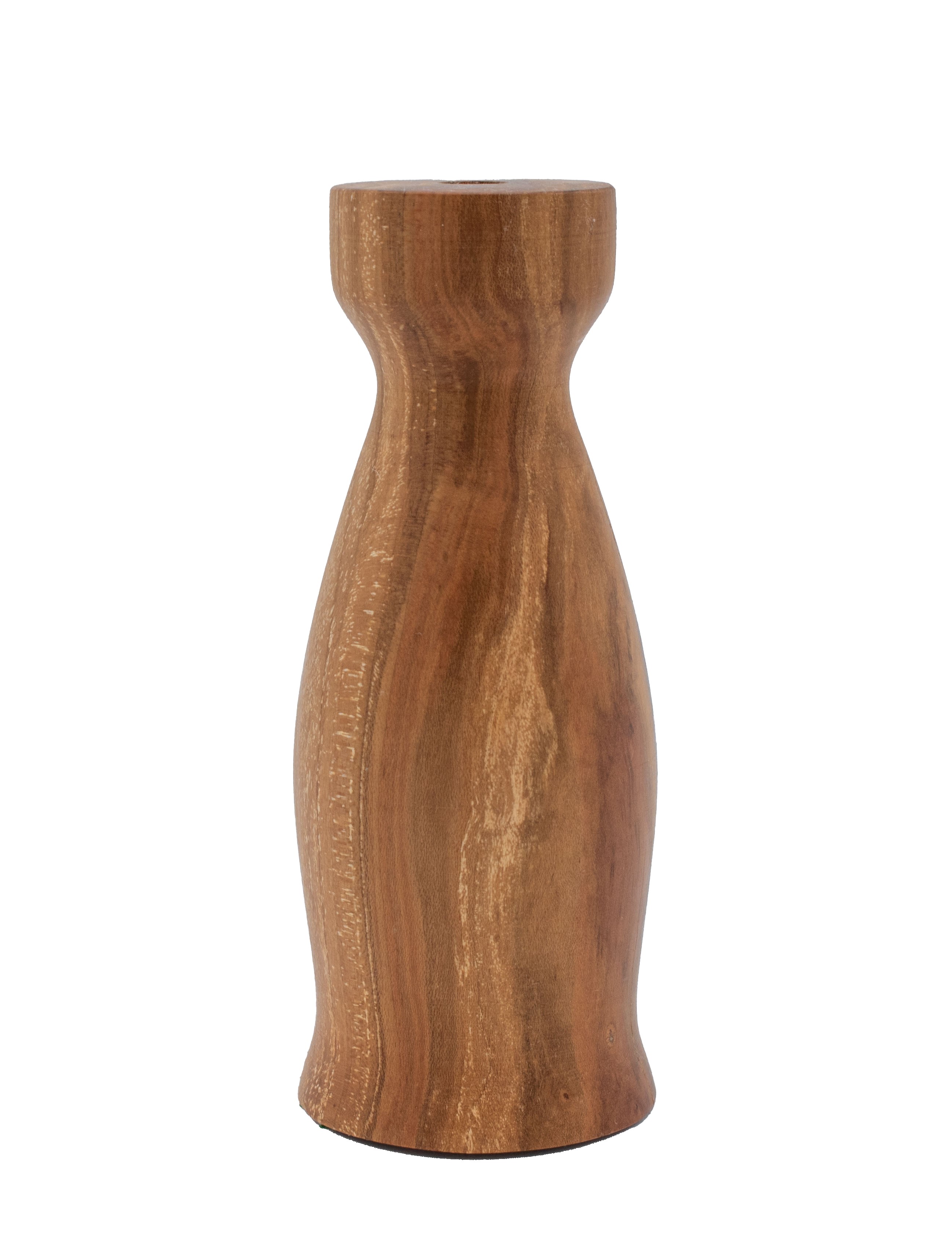
D50: Plum
Prunus domestica. Cultivated worldwide in temperate areas. Related to cherry but heavier and harder.
Wood very colorful with fine texture and close grain. Turns and sands well, but drills
very hot and waxy. Sample is badly damaged and starting to decay, but the pink, red,
and purple tones are typical. Used for musical instruments, inlay, and knife handles.
Sample from Gunnar Barnes. Would work with this species again.
Larger view 1
Larger view 2
The samples of species imported into the U.S. are marked with E. The order of the samples reflects only the order in which the samples were completed.
There are probably over 100 species of wood imported into the U.S. from all around the globe, and I spent many hours online researching the species to include in this project. The exotic woods chosen are ones that are readily available from several online vendors and are moderate in price. While small samples of some rare species can cost hundreds of dollars, most of the small samples used in this project cost less than $10 plus shipping. More importantly, each of the exotics chosen has some desirable characteristic (color, grain, texture, etc.) that could be used to complement and enhance an object made primarily from native wood. Of course, woods known to pose significant health problems were excluded from this project.
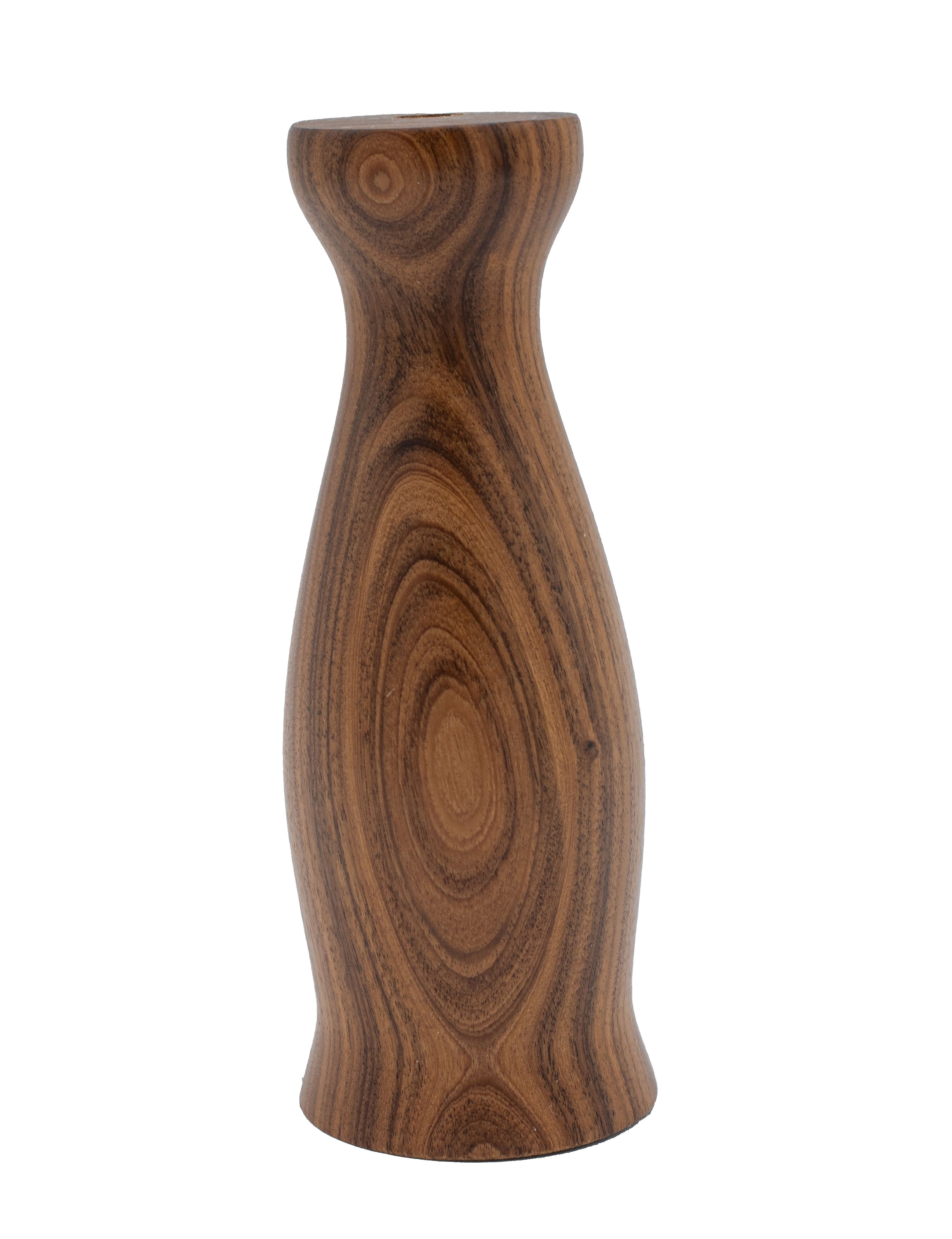
E1: Morado
Machaerium Scleroxylon. Endangered/Vulnerable. From S. America. Also called Pau Ferro, Santos Rosewood, Bolivian
Rosewood. Extremely heavy, hard, brittle. Requires sharp tools. Prone to chipping.
Works like hickory but sands well. Slightly more porous than maple but heavier. Beautiful
combination of light and dark brown, similar to milk chocolate with dark chocolate
streaks. Would work with this species again.
Larger view 1
Larger view 2
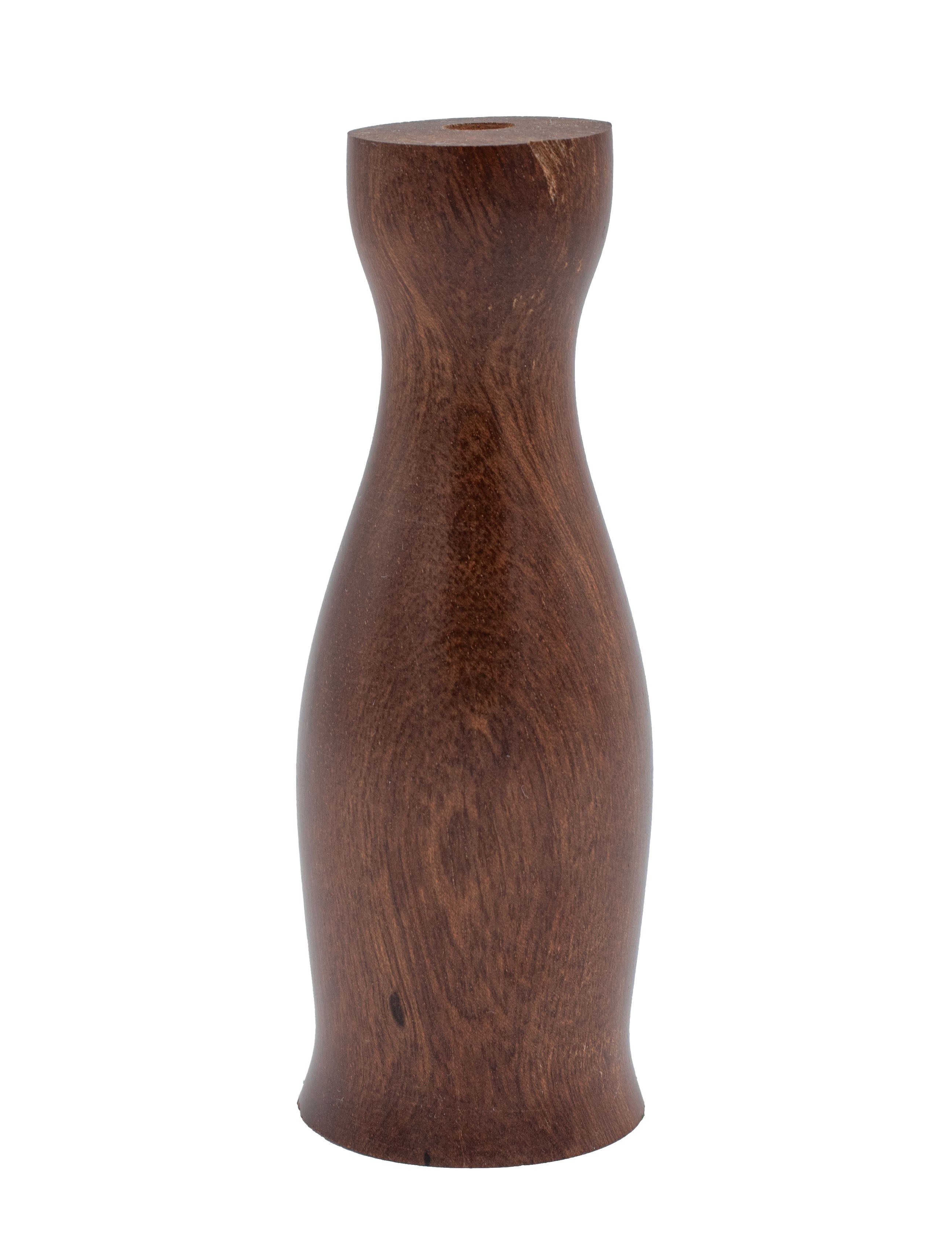
E2: Bloodwood
Brosimum Rubescens. From S. America. Also called Cardinal Wood, Satine. An Australian version is rare
and expensive. Extremely hard, heavy wood that needs sharp tools. Fairly fine-grained
but so hard that sanding is difficult. Waxy and drills hot. Beautiful dark red wood
with darker streaks, but less prominent than in padauk. Sample was purchased green
and cracked while drying, but turned anyway. Despite the excellent outcome, would
be hesitant to work with this wood again.
Larger view 1
Larger view 2
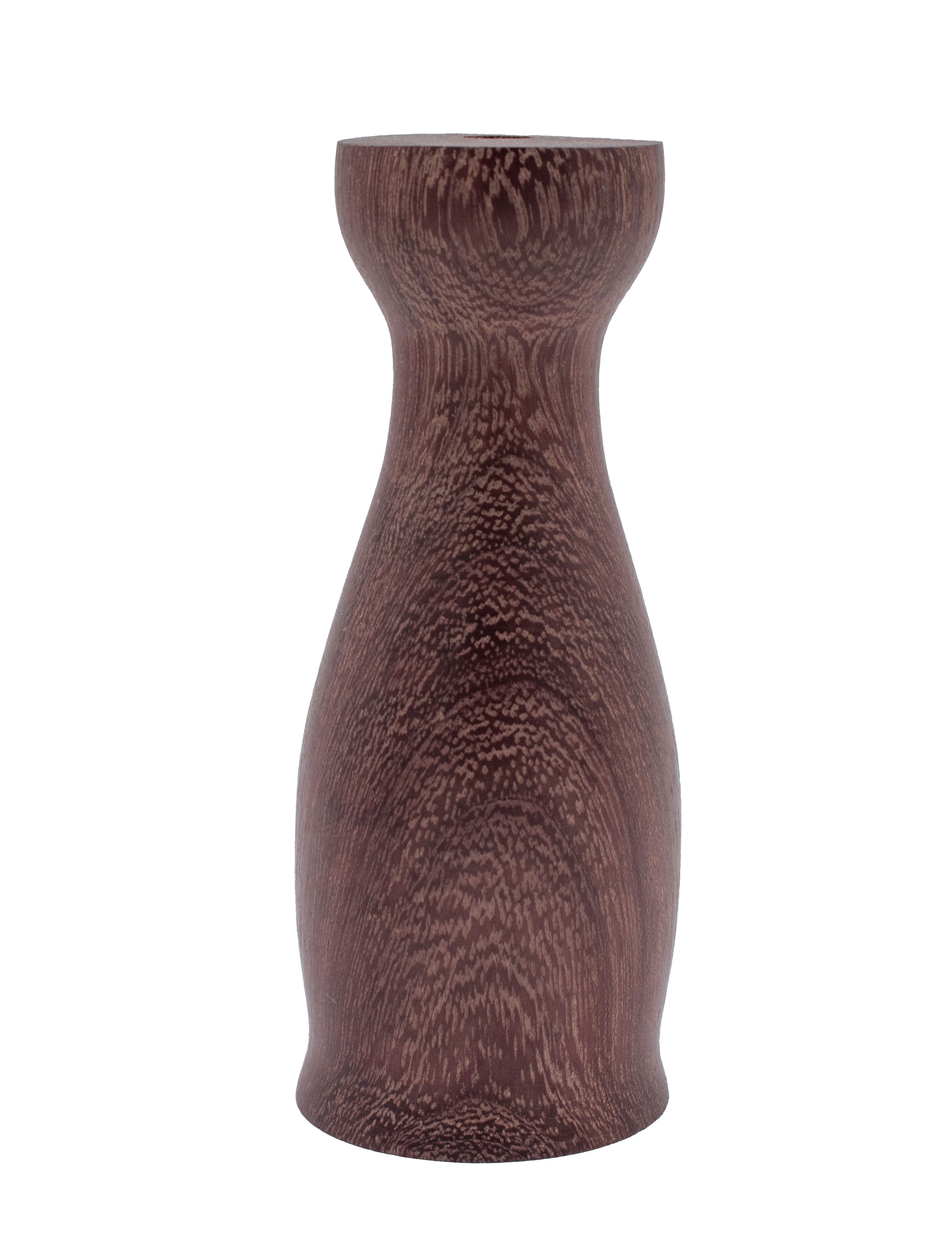
E3: Purpleheart
Peltogyne spp. Endangered/Vulnerable. From Central America. Also called Amaranthe. Extremely hard
and moderately porous but turns well with sharp tools. Difficult to sand, but polishes
well. The bright purple of the raw wood finishes out much darker. Looks great as an
accent wood along with maple on a black walnut piece, but can develop brown tones
with age. Would work with this species again.
Larger view 1
Larger view 2
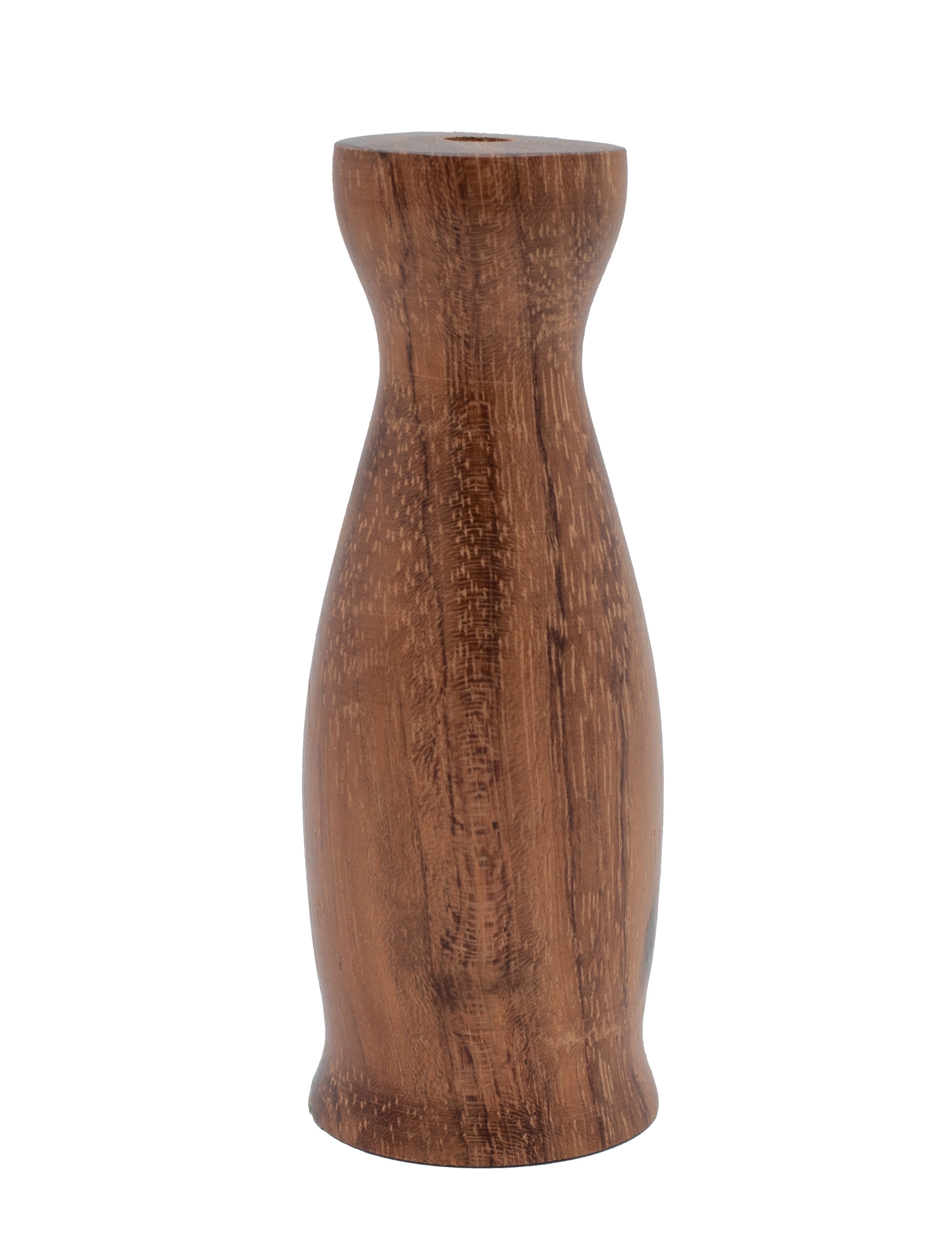
E4: Bubinga
Guibourtia spp. Endangered/Vulnerable. From Central America. Also called Kevazingo, Rhodesian Teak,
African Rosewood, Amazique. Extremely hard but still works well. It has a natural
wax in the wood, much like Osage orange, and it works similarly to Osage orange. Tools
must be sharp, and sanding is difficult. Because of the wax, it burns easily on a
belt sander. In spite of this, it is absolutely beautiful when it’s finished, and
it’s worth the effort. Dark red with darker contrasting grain and lighter flecks throughout.
Would work with this species again.
Larger view 1
Larger view 2
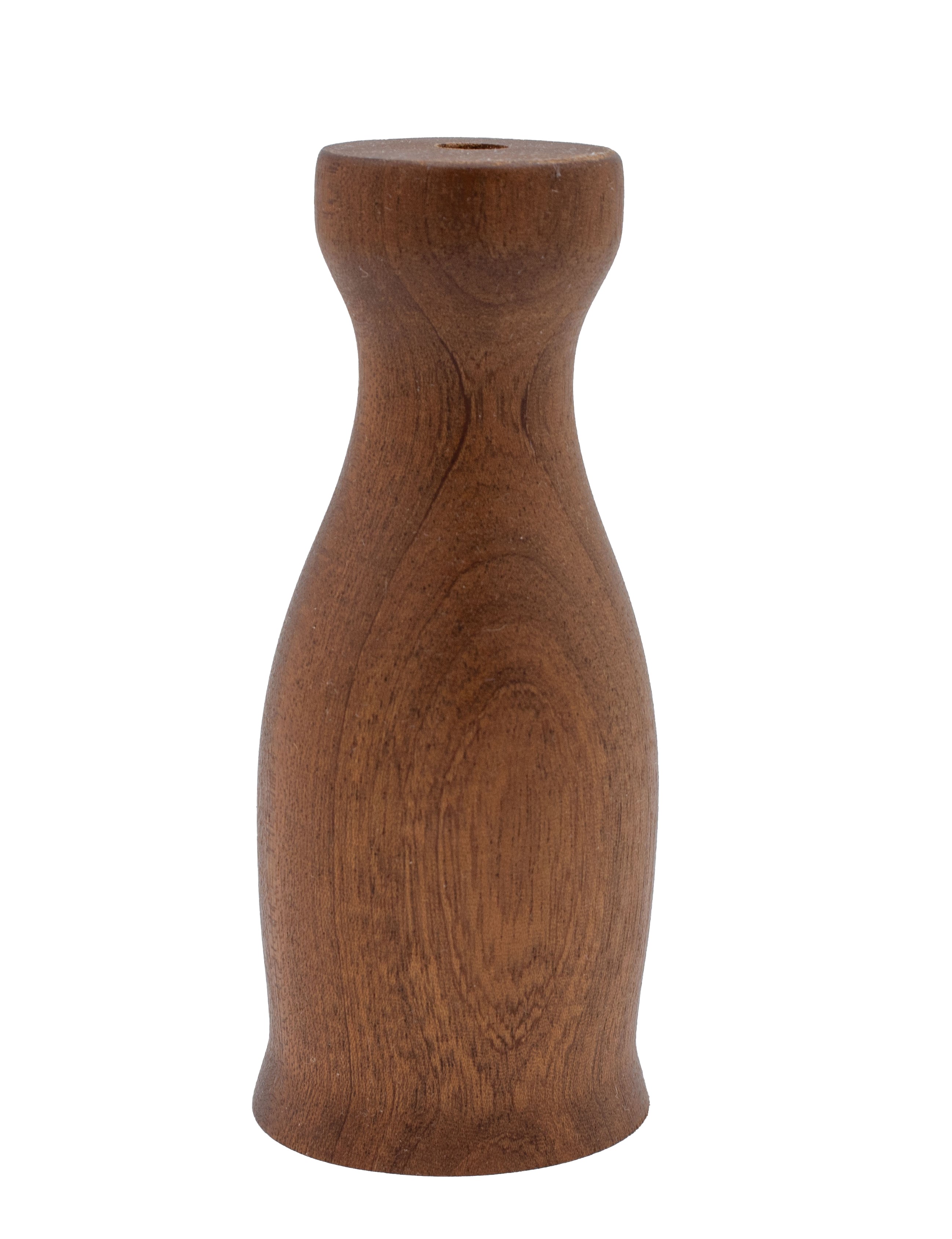
E5: Ribbon Sapele
Entandrophragma Cylindricum. Endangered/Vulnerable. From Africa. Also called Sapelli, Aboudikra, Assi, Muyovu.
Similar to Mahogany—easily worked, easily finished. Also reminds me of working maple.
In the right light you can see shimmering lines in the wood, hence the name. Quartersawn
to give ribbon effect. Available in the cheaper non-ribbon version (sometimes sold
as African Mahogany, which it is not) as well as in other expensive figured versions.
Used in making musical instruments. Would work with this species again.
Larger view 1
Larger view 2
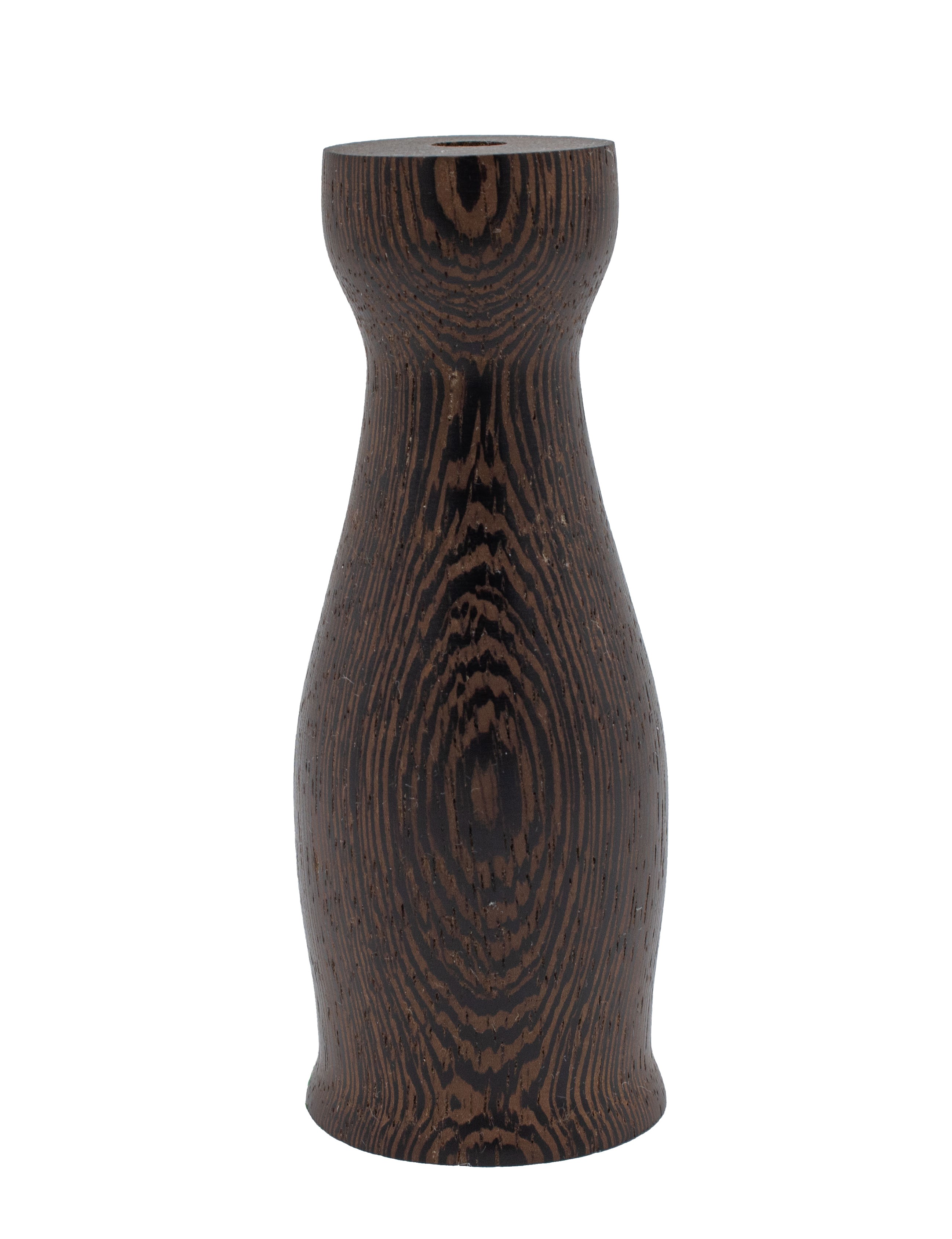
E6: Wenge
Millettia Laurentii. Endangered/Vulnerable. From Africa. Very hard dark wood but sands and finishes well.
Close but pronounced grain. Almost black. Probably best as an accent wood. Some mild
health risks, so wear a mask and use vacuum for the dust. Would work with this species
again.
Larger view 1
Larger view 2
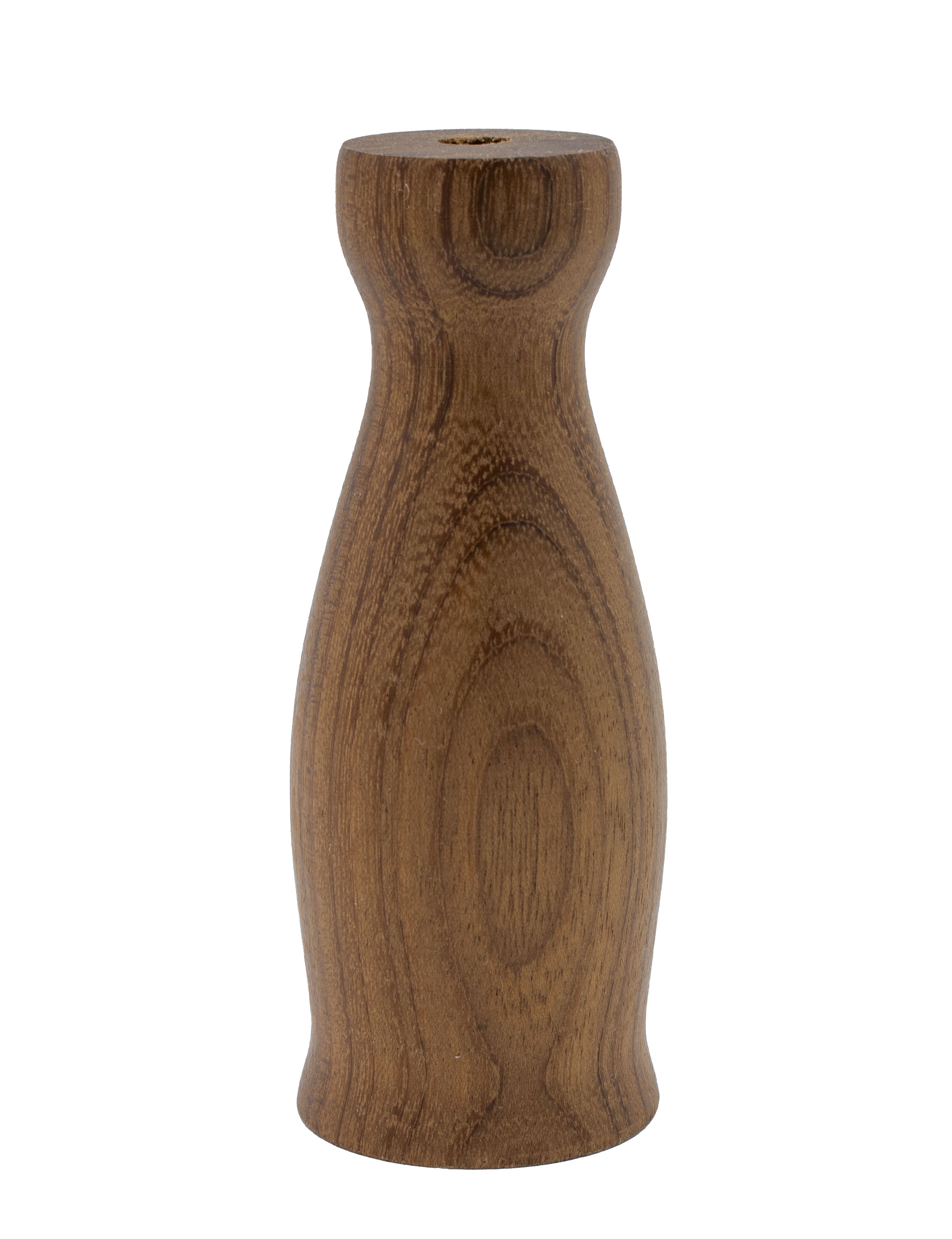
E7: Shedua
Guibourtia ehie. From West Africa. Also called Amazique, Amazoue, Mozambique, Ovangkol. Some respiratory
risks. Similar to native butternut (see D 18) in texture and color, but harder. Somewhat
porous but sands easily and finishes well. Very handsome wood that works well overall.
Milk chocolate color with fine darker grain as well as golden streaks. Would work
with this species again.
Larger view 1
Larger view 2
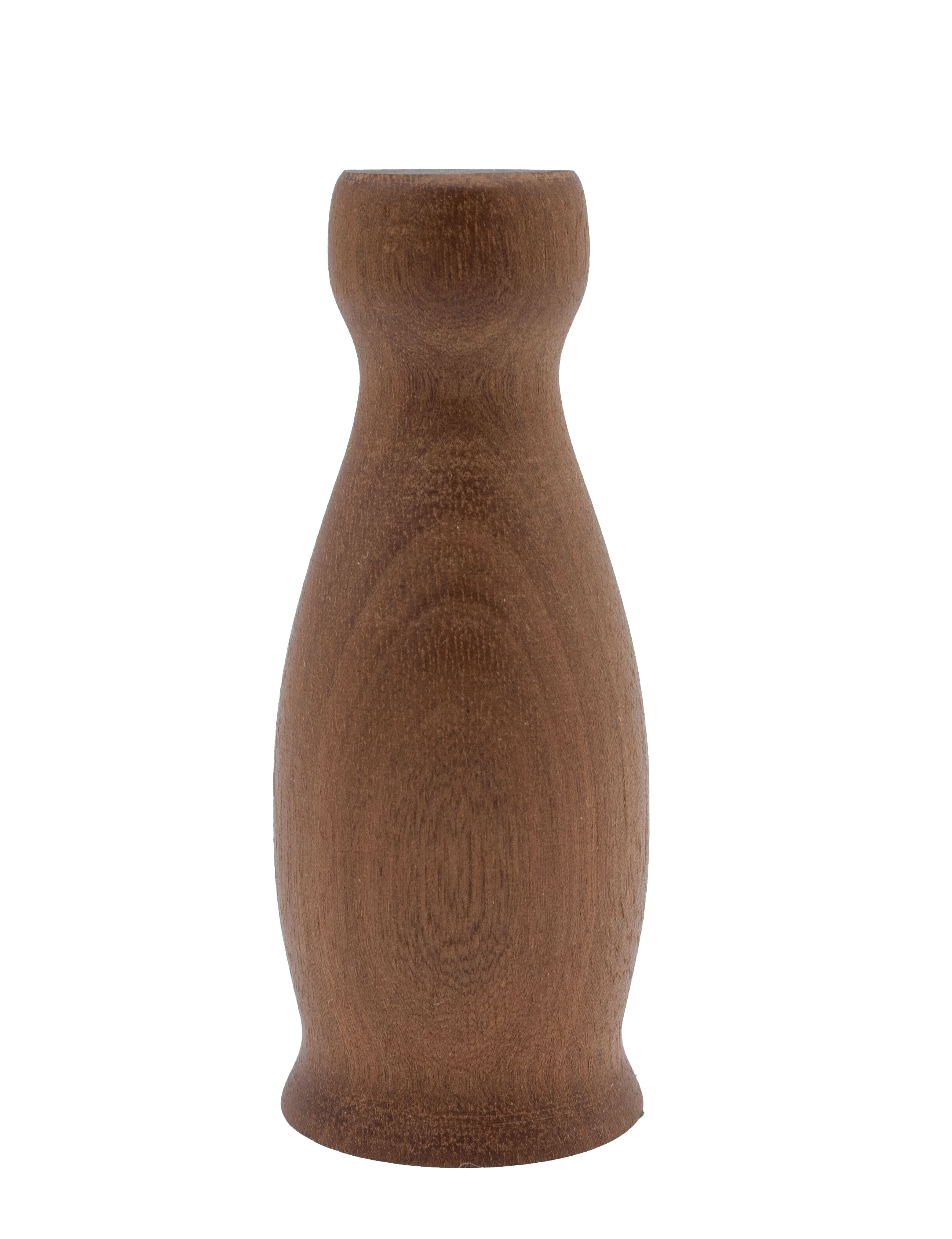
E8: Makore
Tieghelmalla Heckelii, T. Africana. Endangered/Vulnerable. From Africa. Also known as Cherry Mahogany but in a different
family from real mahoganies. Easy to work and sand. Takes finish well. Somewhat waxy.
Reddish color, texture, and general workability similar to native cherry. Somewhat
plain but some golden highlights. A minor health risk--can be a mild nasal and respiratory
irritant, so a mask should be worn. Blunting effect on tools due to high silica content.
Would hesitate to work with this species again.
Larger view 1
Larger view 2

E9: Afromosia
Pericopsis Elata. Endangered/Vulnerable. From Africa. Also called African Teak, Kokrodua, Assamela.
Open and porous, and works much like black walnut. Sands easily and takes finish well.
Medium brown with tan/gold streaks. Would work with this species again.
Larger view 1
Larger view 2

E10: African Mahogany
Khaya spp. Endangered/Vulnerable. From tropical Africa and Madagascar. Also called Khaya. Not
in same family as mahoganies from Central America. Very light and soft, but a challenge
to work. Requires sharp tools and a light touch, similar to poplar. Cut and carved
very easily and sanded very easily. When finished, a light reddish brown with some
tan tones. Grain not very apparent. Not particularly handsome. In its native countries,
used for dugout boats and residential framing since it is resistant to termites and
other boring insects. Also used in making musical instruments. Would work with this
species again.
Larger view 1
Larger view 2
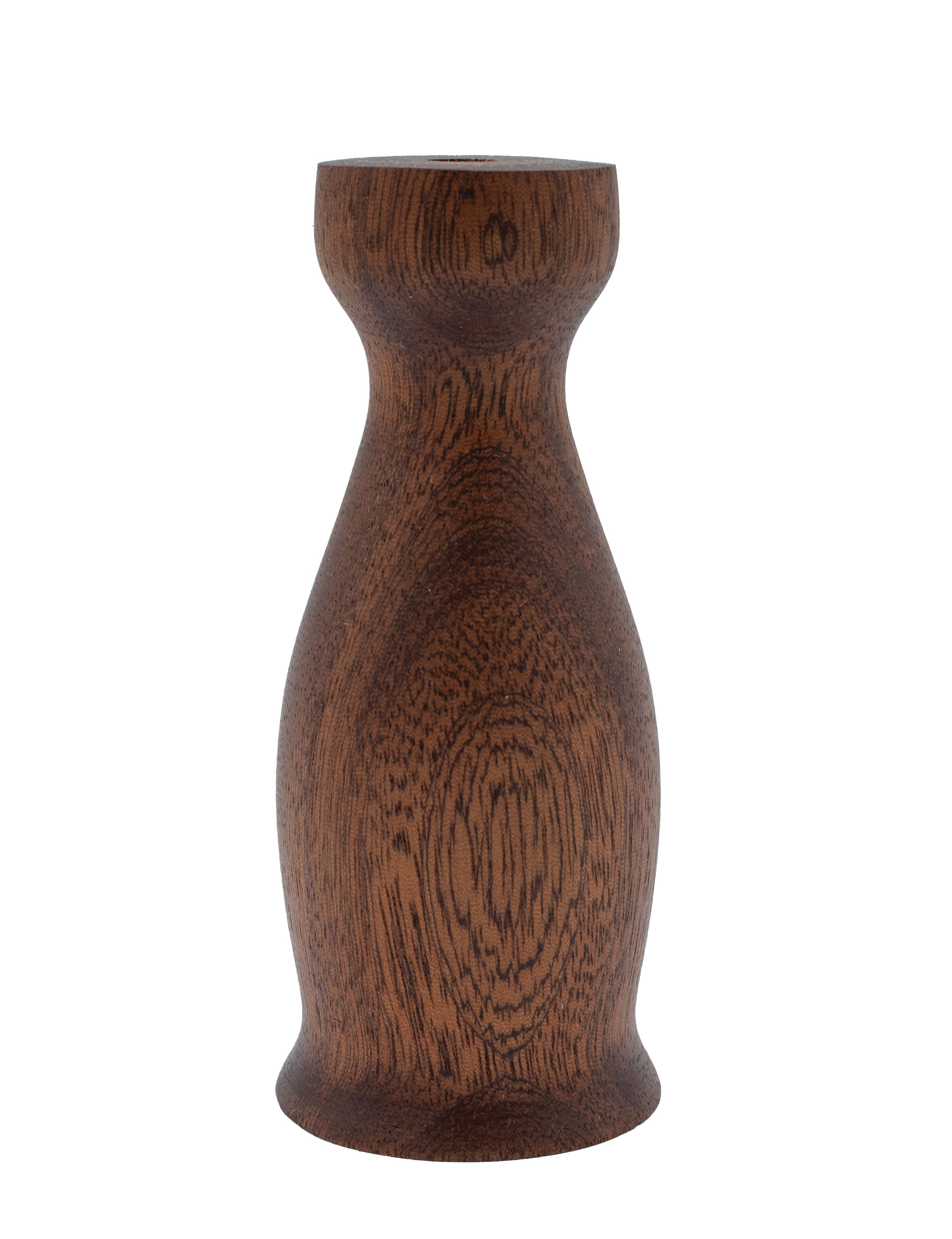
E11: Jatoba
Hymenaea Courbali. From Central and S. America. Also called Brazillian Cherry. A wonderful turning wood.
Works easily and is about medium weight, medium density, and medium hardness. It sands,
finishes, and polishes well. Slightly waxy when drilled but not enough to cause problems.
Coloration is more brown than red and has subtle golden streaks along the grain lines.
The grain is obvious but not prominent. Resembles ribbon sapele, but golden streaks
a bit brighter and not quite as red overall. Altogether a very handsome wood that
is easy to work. Would gladly work with this species again.
Larger view 1
Larger view 2
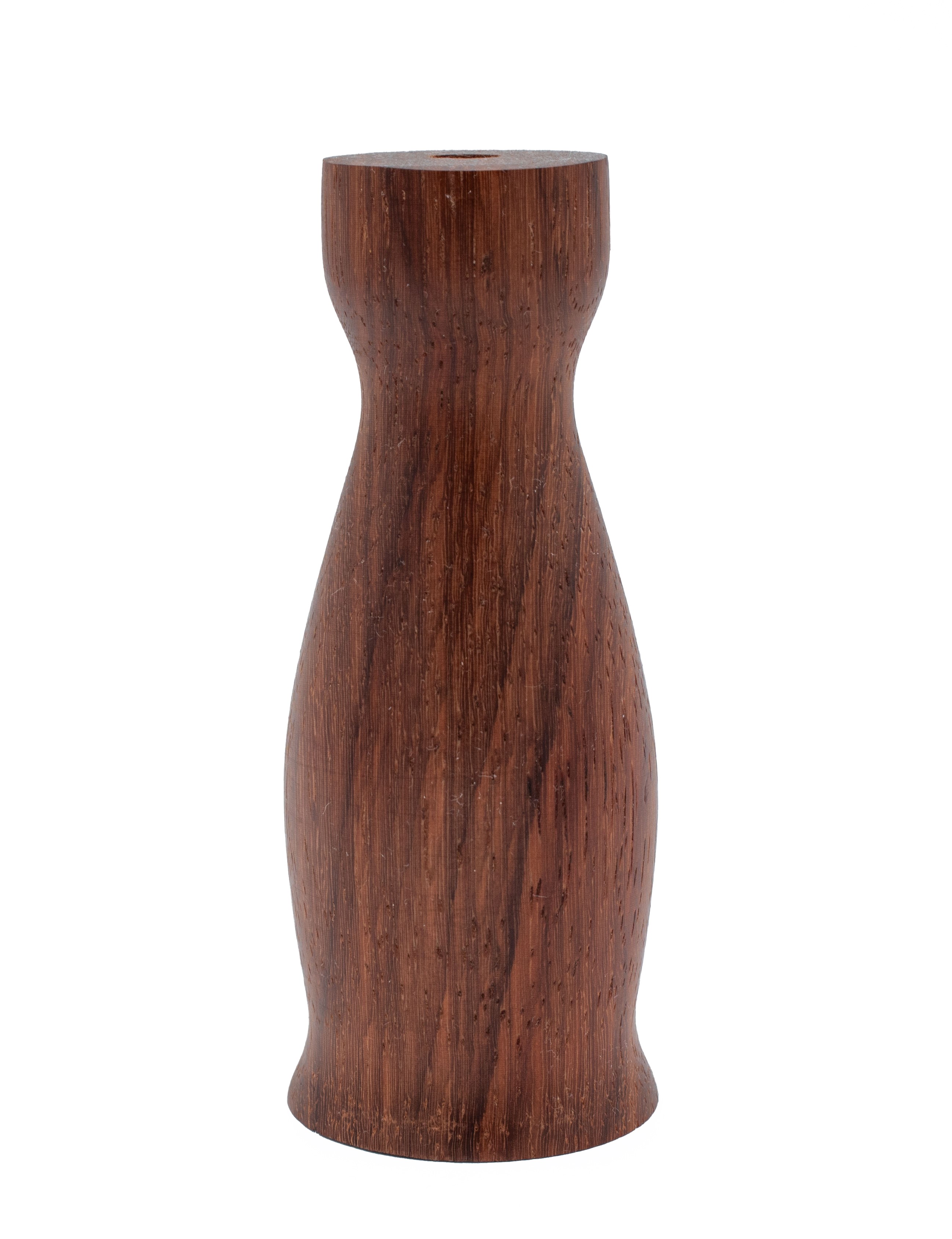
E12: Padauk
Pterocarpus Soyauxii. Endangered/Vulnerable. From Central and W. Africa. Also called Vermillion. Dark red
with lighter and darker streaks and black flecks but darkens further with age. Great
turning wood. Medium hardness. Slightly porous but sands and finishes well. Reasonably
priced for an exotic and readily available. Would work with this species again.
Larger view 1
Larger view 2
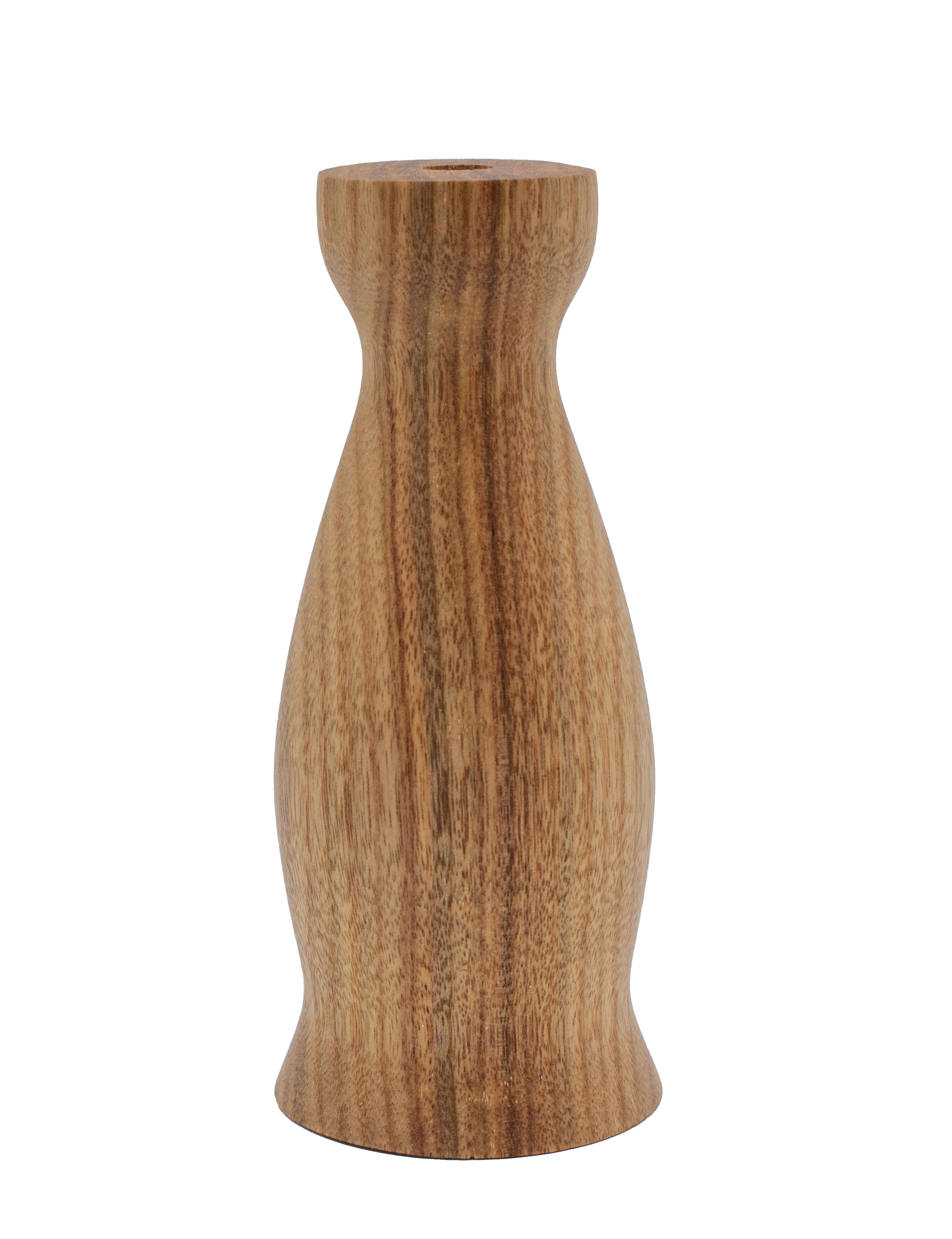
E13: Canarywood
Centrolobium spp. From S. America. Medium hardness. Easy to work and sand. Slightly waxy. Readily available
at a reasonable price for an exotic. One of the prettiest woods I’ve ever seen with
many colors emerging when finished--gold, tan, orange, blue-gray, and green. Would
work with this species again.
Larger view 1
Larger view 2
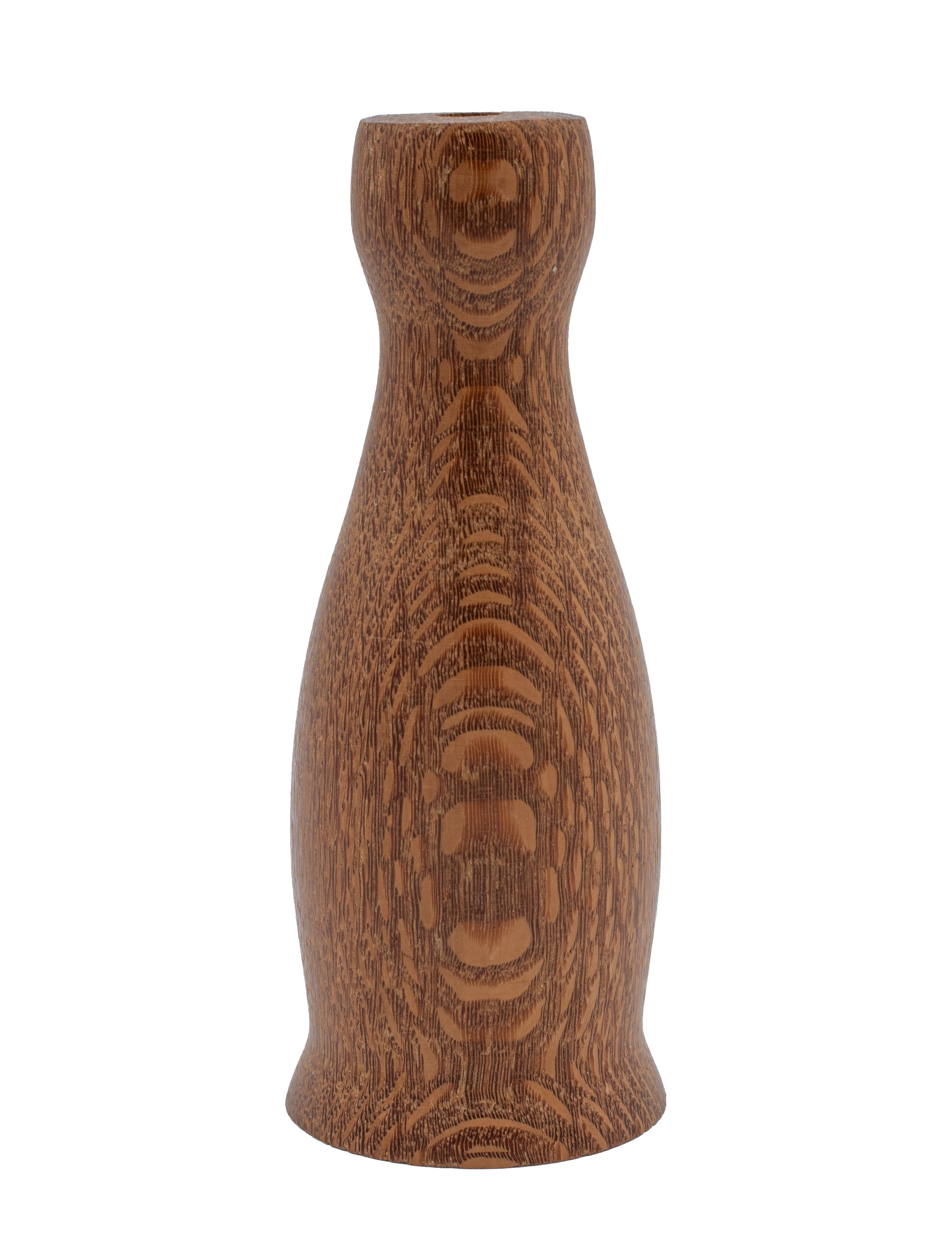
E14: Leopardwood
Roupala Montana. From Central and S. America. Similar to oak and hickory in hardness but not as porous--more
like walnut. Slow sanding. Used in veneers, fine furniture, musical instruments. Quartersawn
to give lace effect. Tan wood with light-colored flecks and prominent dark brown grain.
Would work with this species again.
Larger view 1
Larger view 2
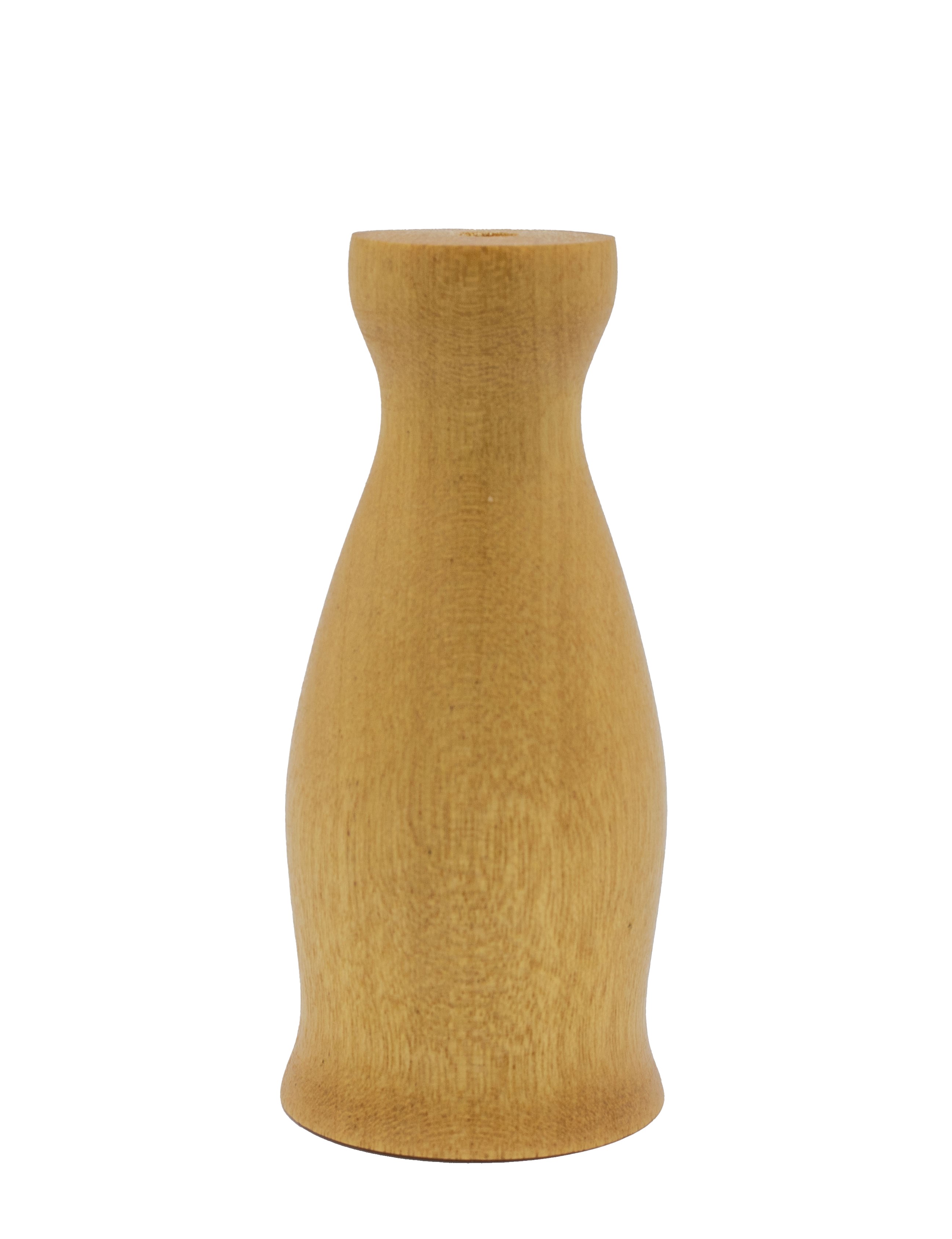
E15: Yellowheart
Euxylophora Paraensis. From S. America, primarily Brazil. Also called Pau Amarello and Brazillian Satinwood
(although it is not related to true satinwood). Works and sands easily, much like
maple. Even tight grain. Plain version with little grain showing, but can have orange
and pink streaks. See E 21 below. Would work with this species again.
Larger view 1
Larger view 2
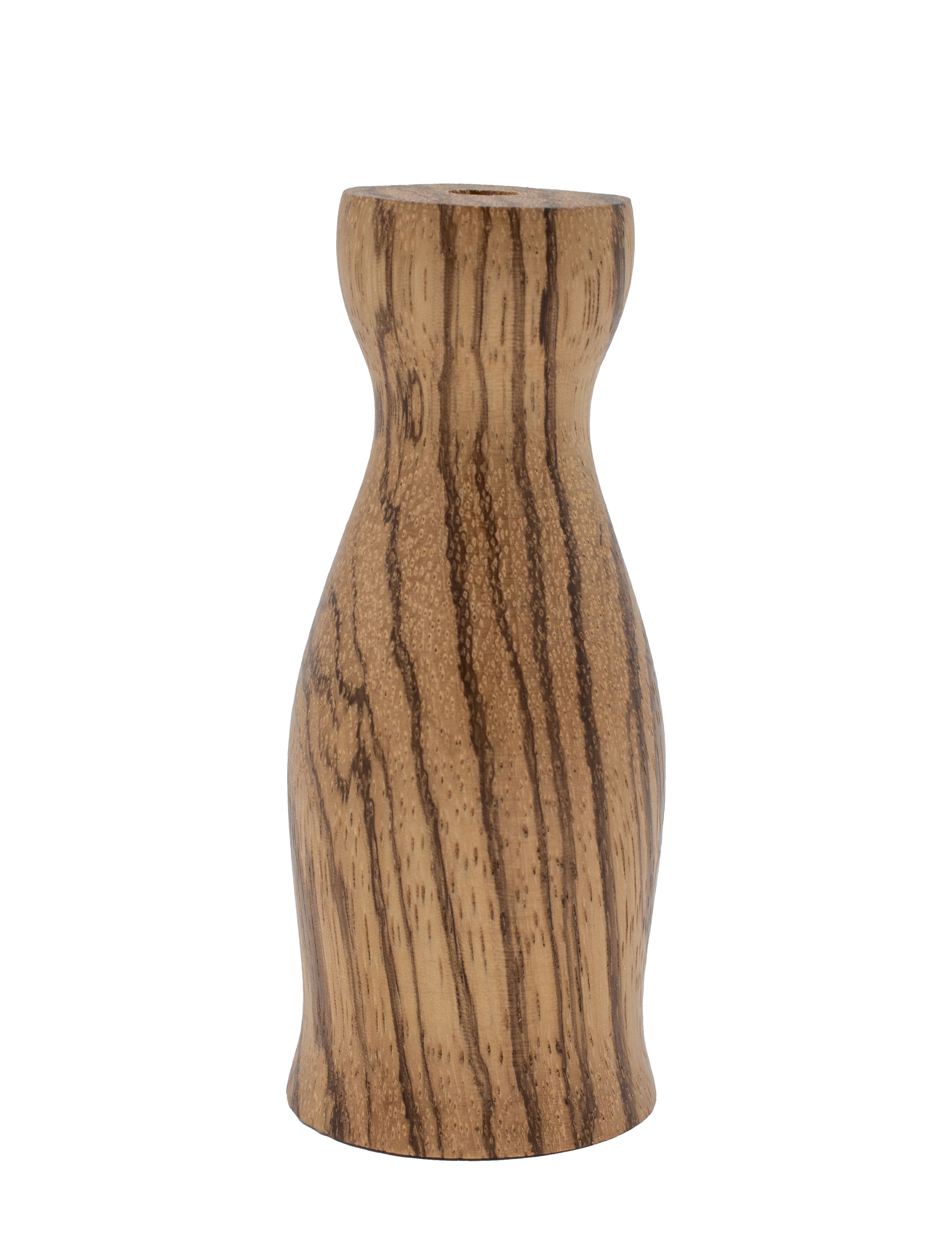
E16: Zebrawood
Microberlinia Brazzavillensis. Endangered/Vulnerable. From W. Africa. Also called Zebrano and Tigerwood. Medium hardness.
Somewhat porous, but not as much as oak. Often contains long black pitch pockets which
weaken a bowl blank. Easy to work and sand. Striking contrasts. With a non-yellowing
finish, would show the off-white and dark brown of a zebra. A red variety called Ebiara
or Red Zebrawood has same characteristics. In spite of its difficulties, would work
with this species again.
Larger view 1
Larger view 2
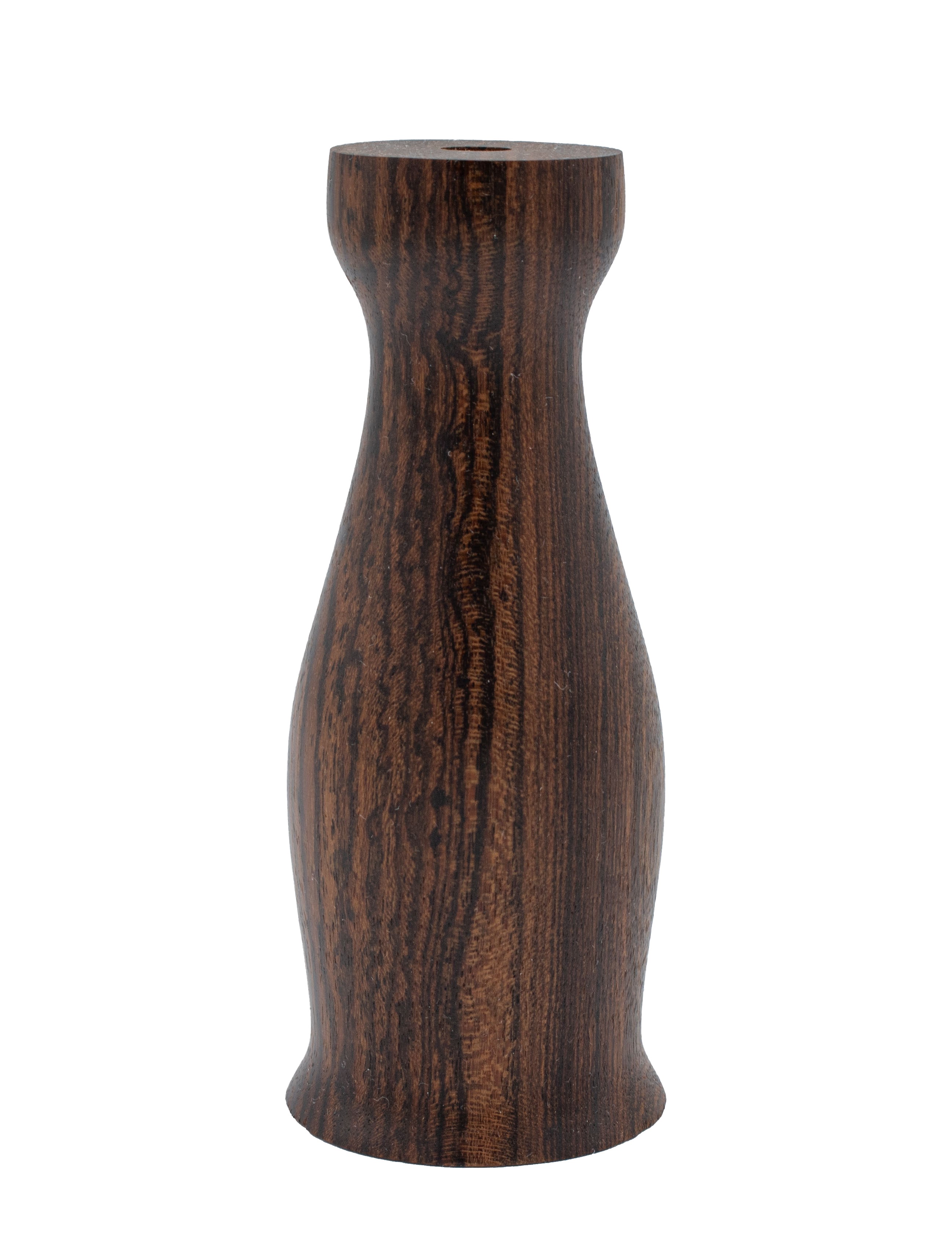
E17: Bocote
Cordia spp. From Mexico, Central and South America. Fairly heavy dense wood that turns reasonably
well. Looks to be porous when being turned, but not when sanded and finished. Somewhat
unusual wavy grain in places. Very light brown with close, prominent, very dark grain.
Striking appearance. Very waxy—sawdust compacted and smoked as it was being drilled.
Would work with this species again.
Larger view 1
Larger view 2
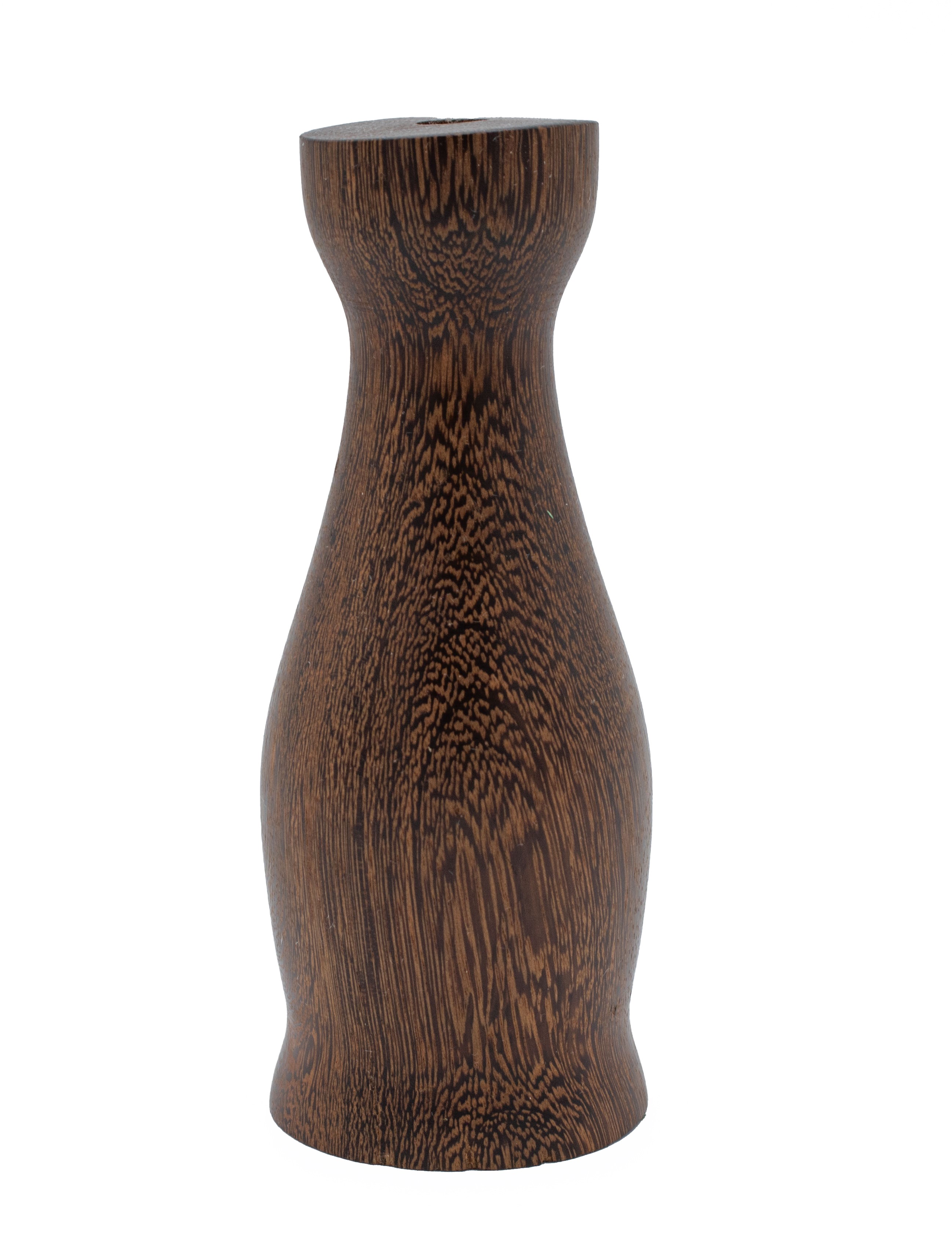
E18: Brownheart
Vouacapoua Americana. Endangered/Vulnerable. From S. America, primarily Brazil. Also called Wacapou. Very
heavy wood that is hard to work and requires very sharp tools. It was bad about tearing
out and was very difficult to sand. When finished, it looks like a very dark brown
version of wenge. While it is striking when finished, would avoid working with this
species.
Larger view 1
Larger view 2
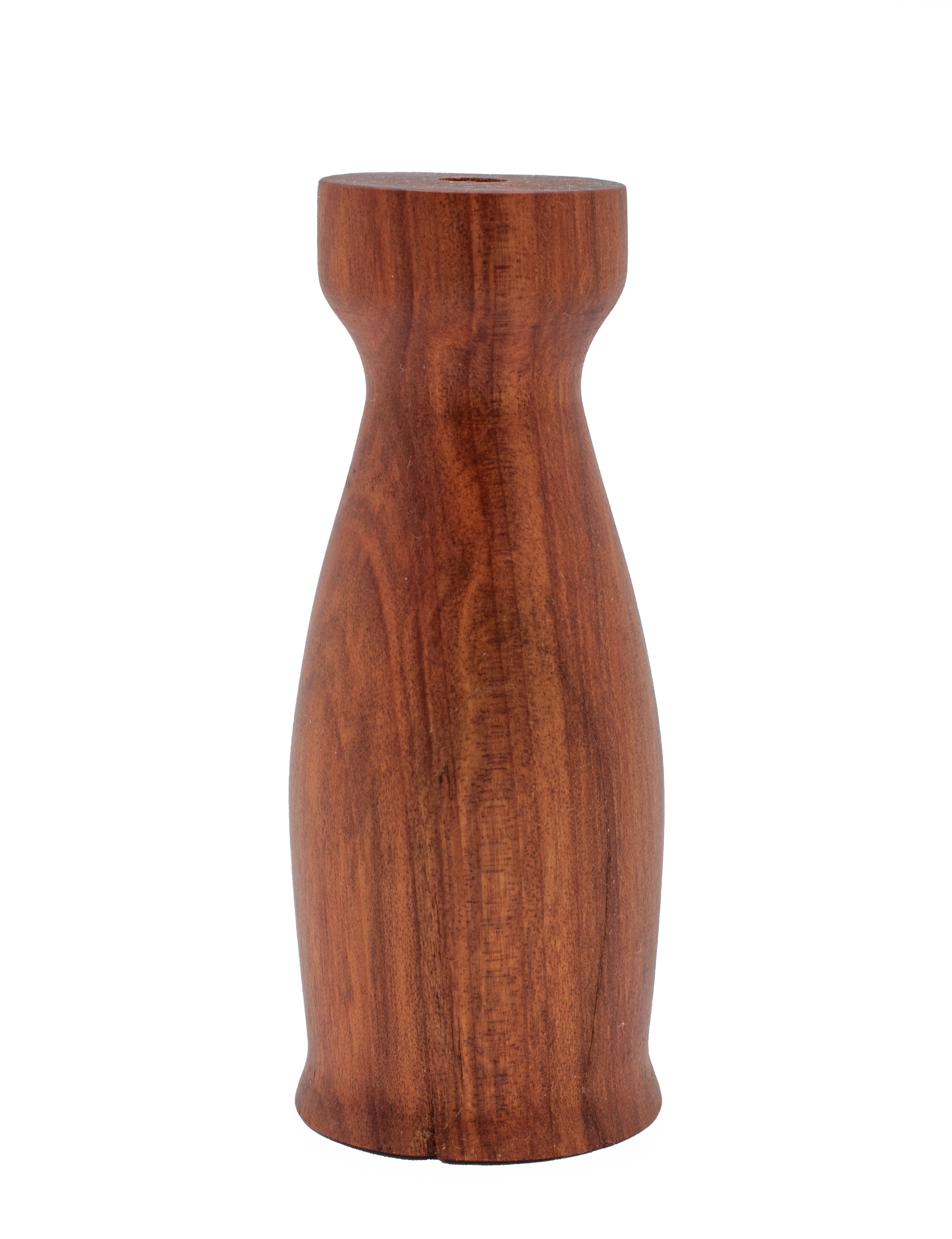
E19: Redheart
Erythroxylum spp and Simira spp. From Central and S. America. Also called Chakte Kok. Excellent turning wood similar
in hardness to walnut or hard maple. Bright red with dark streaks when turned, but
ages to a more reddish brown. Would be an excellent alternative to paduak. Turns,
drills, sands, and finishes well. Also used for high-end furniture, inlay work, and
musical instruments. Would work with this species again.
Larger view 1
Larger view 2
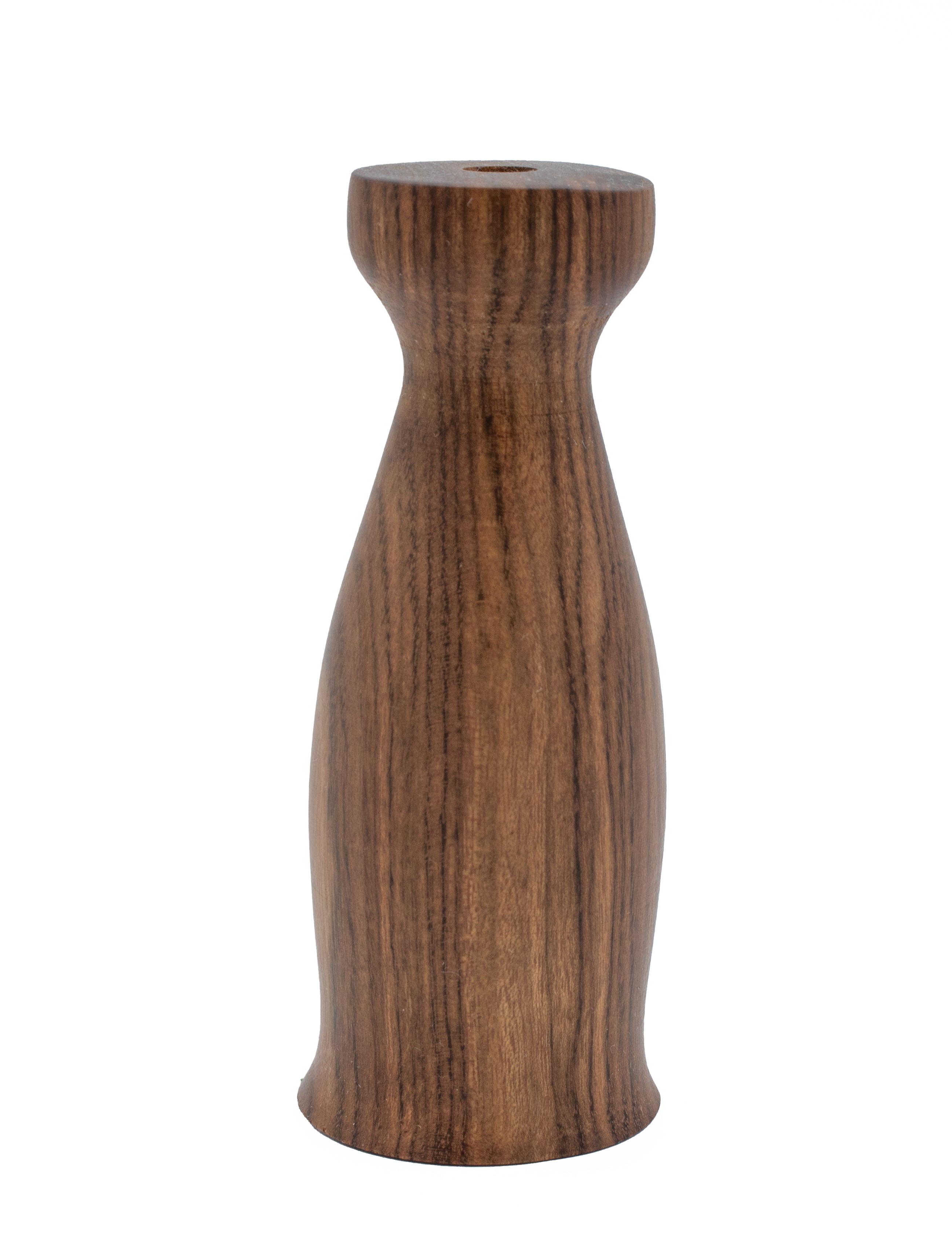
E20: Caribbean Rosewood
Metopium Brownei. Endangered/Vulnerable. From Caribbean and Central America. Also called Chechen, Chechem,
Black Poisonwood. In same family as poison ivy. Wood is safe to handle, but the dust
can cause skin irritation. Very beautiful wood with lots of contrasting colors from
golds to reds to dark browns. Very hard and brittle and takes a light touch, but still
works okay overall. It drills very hot and waxy. It also sands hard and very hot and
will burn easily on a sander. Widely used in musical instruments. In spite of these
difficulties, would work with this species again.
Larger view 1
Larger view 2
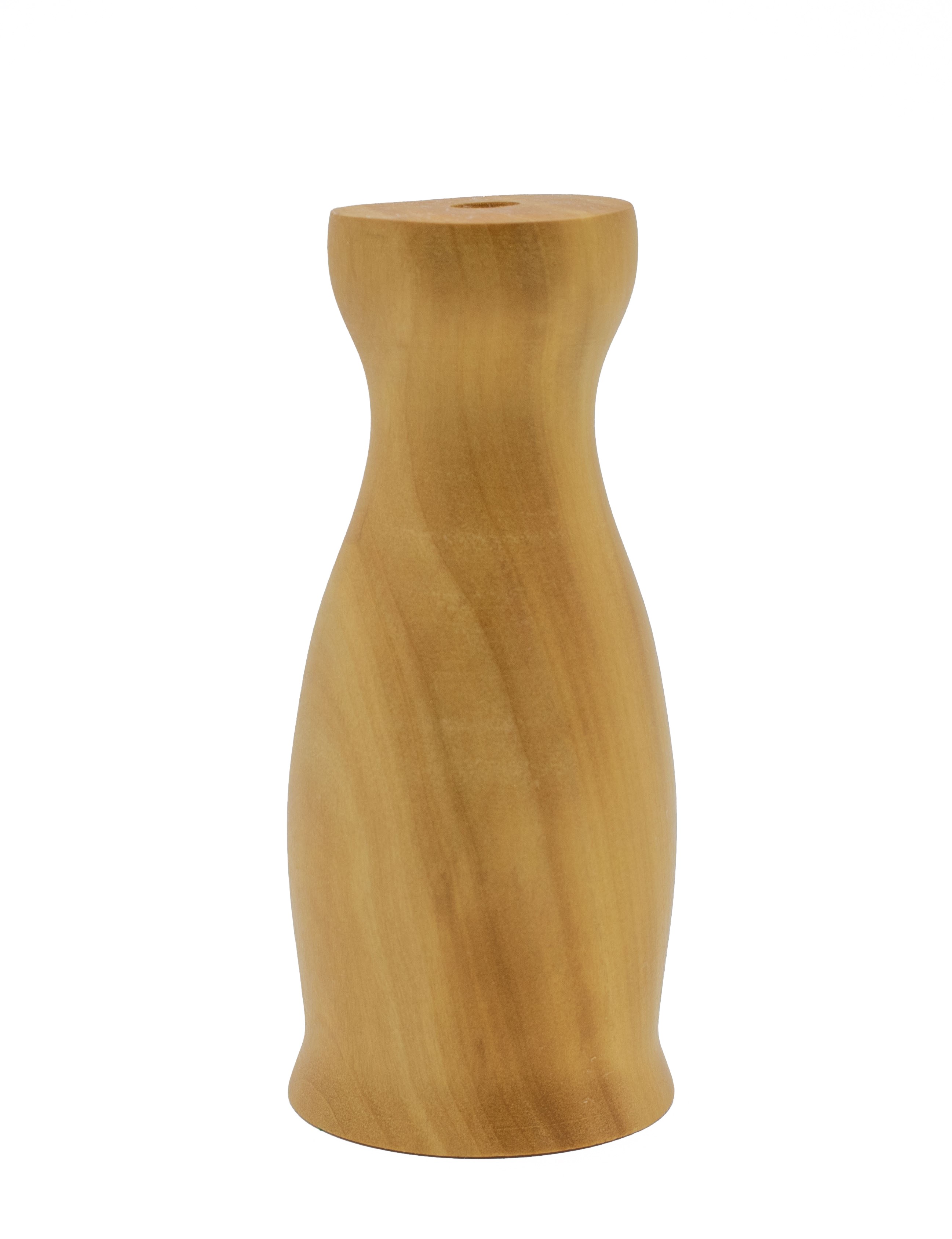
E21: Pau Amarello
See E 15 above. From South America. Color-streaked version of yellowheart. Bought
by mistake due to different marketing name. Beautiful wood, easy to work. Would work
with this species again.
Larger view 1
Larger view 2

E22: Lacewood
Panopsis spp. From South America. Also called Brazilian Lacewood, S. American Lacewood. Related
to Leopardwood. See E14. Dark red with prominent lace effect. Similar to walnut in
hardness but less porous. Works and sands easily. Would work with this species again.
Larger view 1
Larger view 2

E23: Cedar of Lebanon
Cedrus Libani. Endangered/Vulnerable. From Lebanon and Eastern Mediterranean region. Probably the
worst turning wood in this project so far. As soft as white pine and tears very easily.
Sands easily because it’s so soft but does not take a high finish--just a soft luster.
Looks like white pine, not at all like native red cedar. Very unusual blue-gray, almost
slate-colored streaks through it, but they do not follow the grain lines. Have not
seen similar color distribution in any other wood, but not particularly handsome.
Would probably work better with hand tools than with modern machine tools. This wood
is mentioned in several places in the Bible and was used for the pillars in Solomon’s
temple in Jerusalem. Would avoid working with this species again.
Larger view 1
Larger view 2
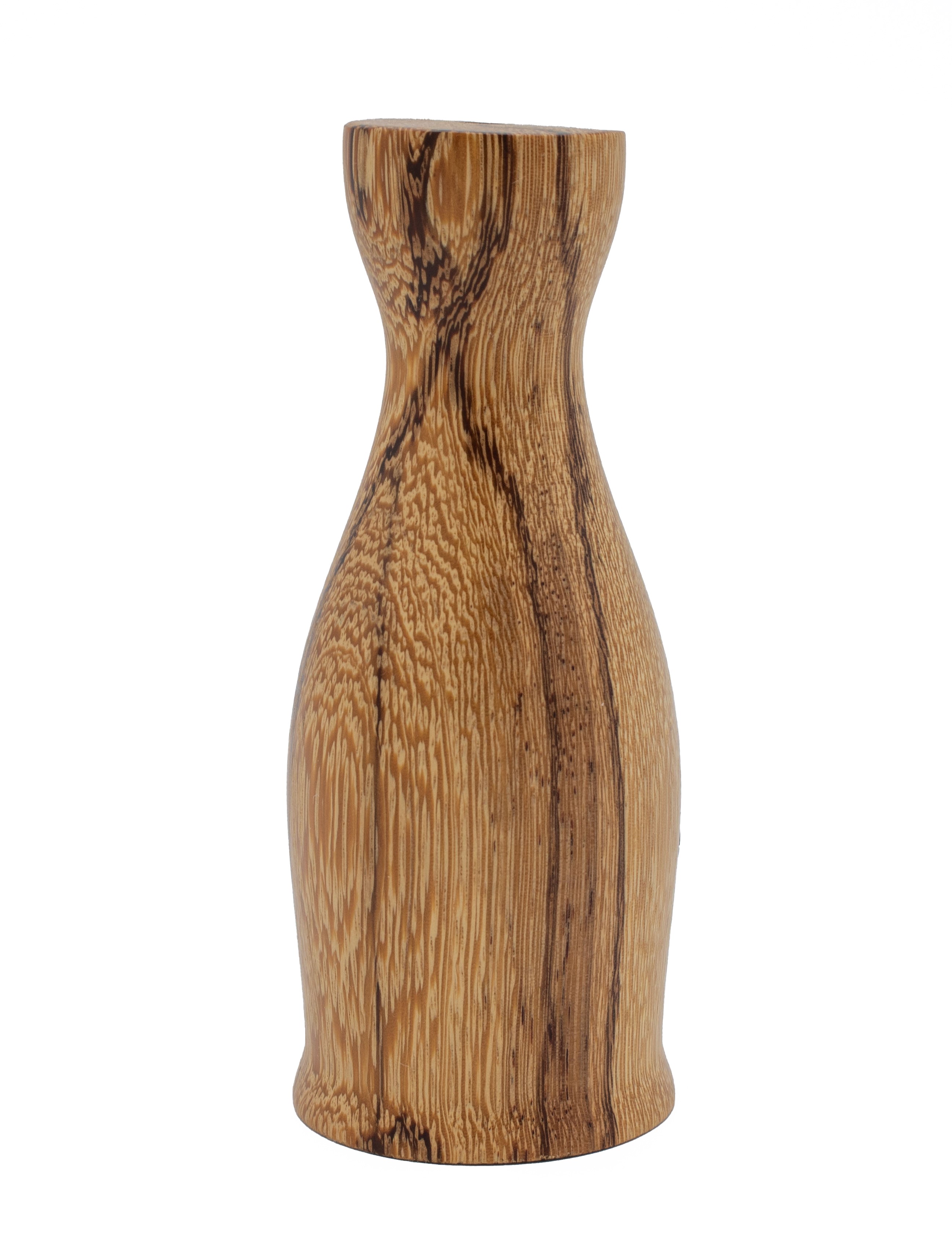
E24: Marblewood
Zygia Racemosa. From S. America. Also called Angelim Rajado. One of the hardest and most dense woods
in this project. Nearly twice as hard as Hard Maple. Looks similar to less expensive
Zebrawood, but not as coarse and easier to work. Large, very prominent pores in tan/gold
wood with very dark reddish black grain. Very showy. Somewhat waxy, so sawdust compacts
and smokes when drilled. Finishes and polishes well. Worth the extra effort. Would
be great accent wood with maple or walnut. Would work with this species again.
Larger view 1
Larger view 2
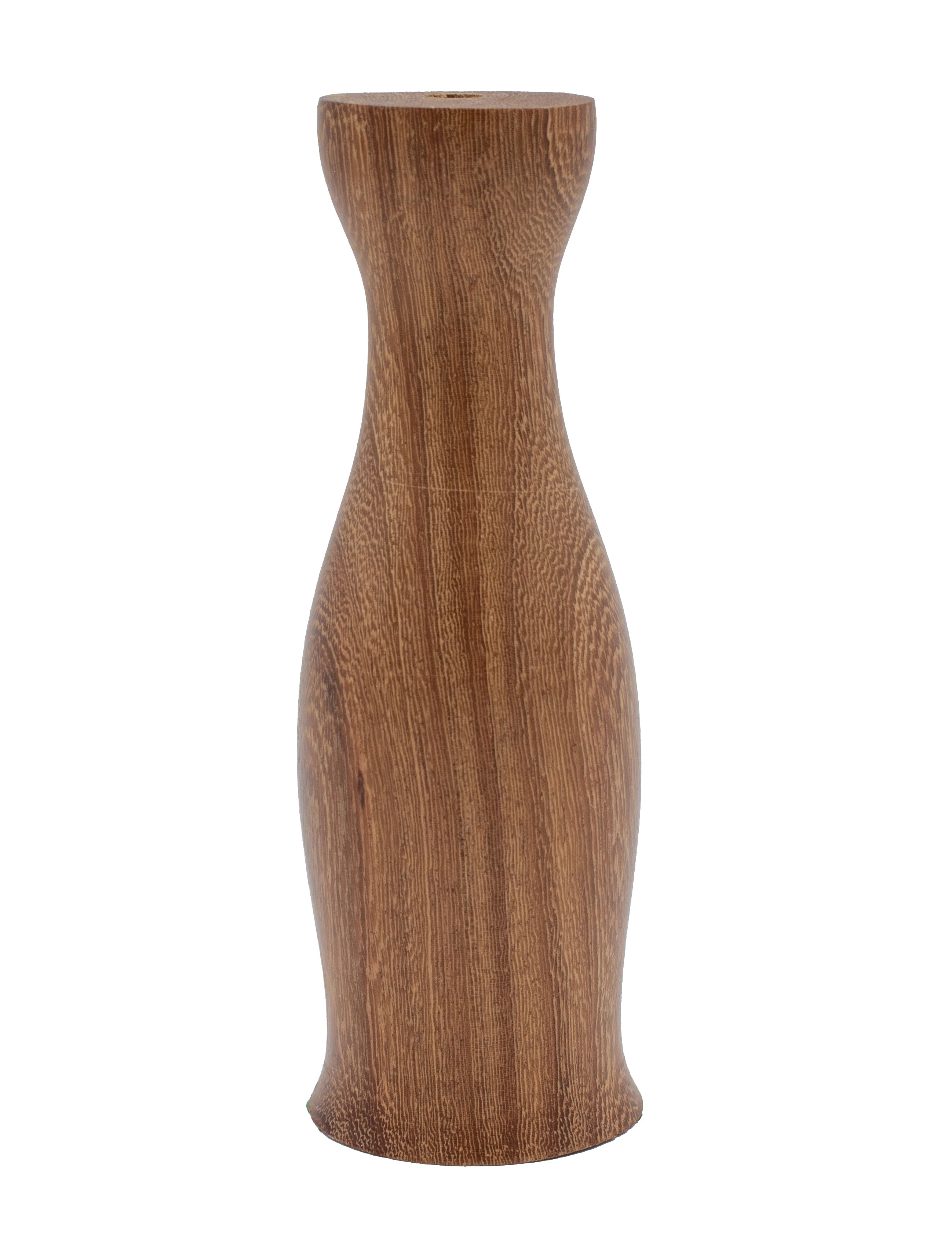
E25: Pau Rosa
Bobgunnia Fistuloides. Endangered/Vulnerable. From African rainforests. One of the world’s most colorful
woods, with hues ranging from yellows and pinks to purples and dark browns, although
colors somewhat darken with age. One of the few true “rainbow woods.” Hard and dense
but very fine grain. Works somewhat like hard maple. Very waxy and drills hot. Sawdust
quickly compacts and smokes when drilled. Turns, sands, finishes, and polishes well.
Would work with this species again.
Larger view 1
Larger view 2

E26: Curupau
Anadenanthera Colubrina and A. Pergrina. From S. America. Also called Curupay, Cebil, Patagonian Rosewood, although not a true
rosewood. Extremely hard, dense, waxy, tough wood with coarse interlocking grain.
However, sands well and finishes well. Light streaks in dark brown wood and almost
black grain. Very handsome and polishes to a high luster. Also used for flooring and
furniture. In spite of its difficulty, would work with this species again.
Larger view 1
Larger view 2
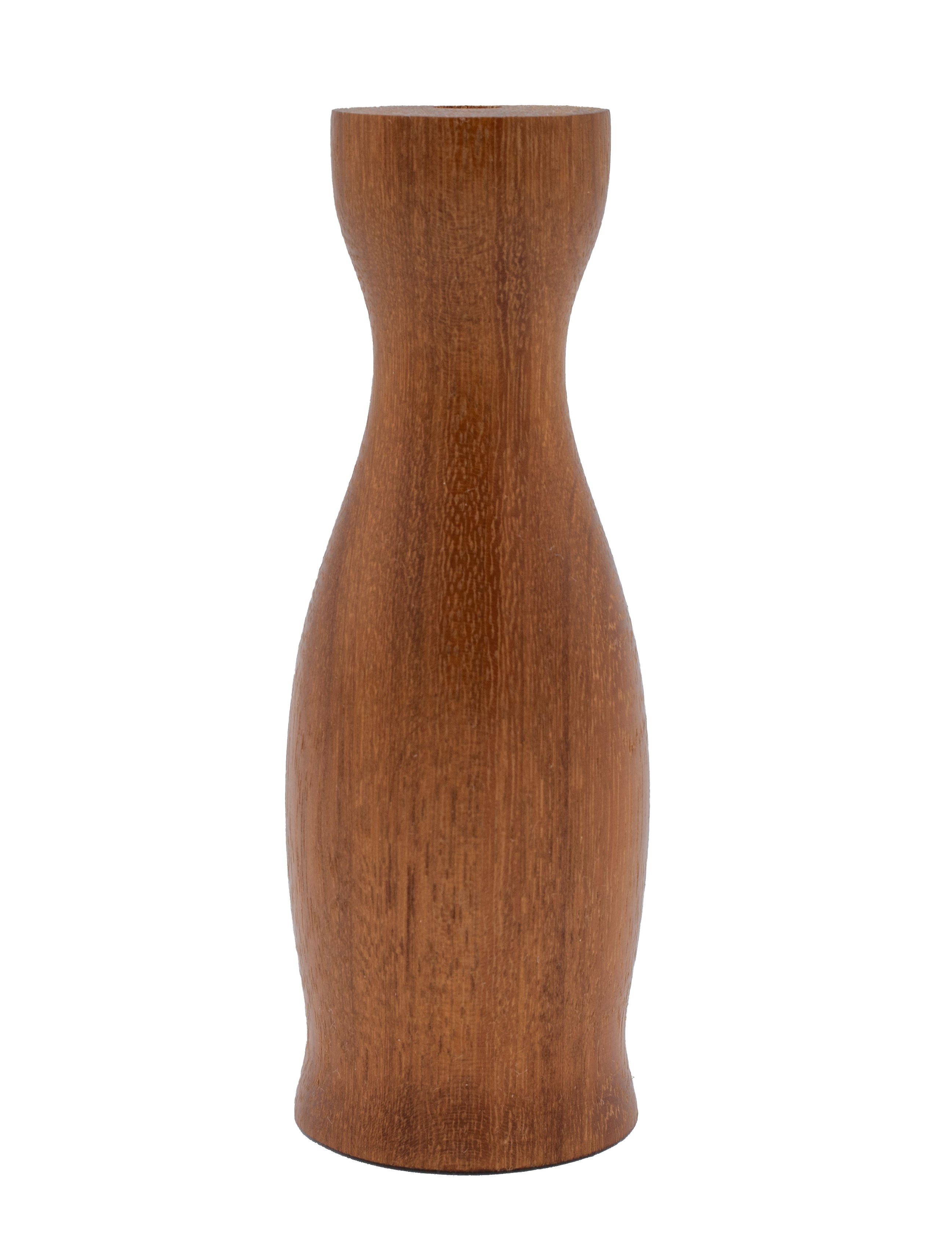
E27: Argentine Osage Orange
Maclura Tinctoria. From Central and S. America. Also called Fustic, Guatemalan Tigerwood. Very hard
and dense but works well on lathe. Fine-grained but waxy and drills hot. Sands and
finishes well. Not as colorful as domestic Osage Orange. Bright yellow with some streaks
of gold but ages to brown. Used in construction and for flooring and furniture. Would
work with this species again.
Larger view 1
Larger view 2
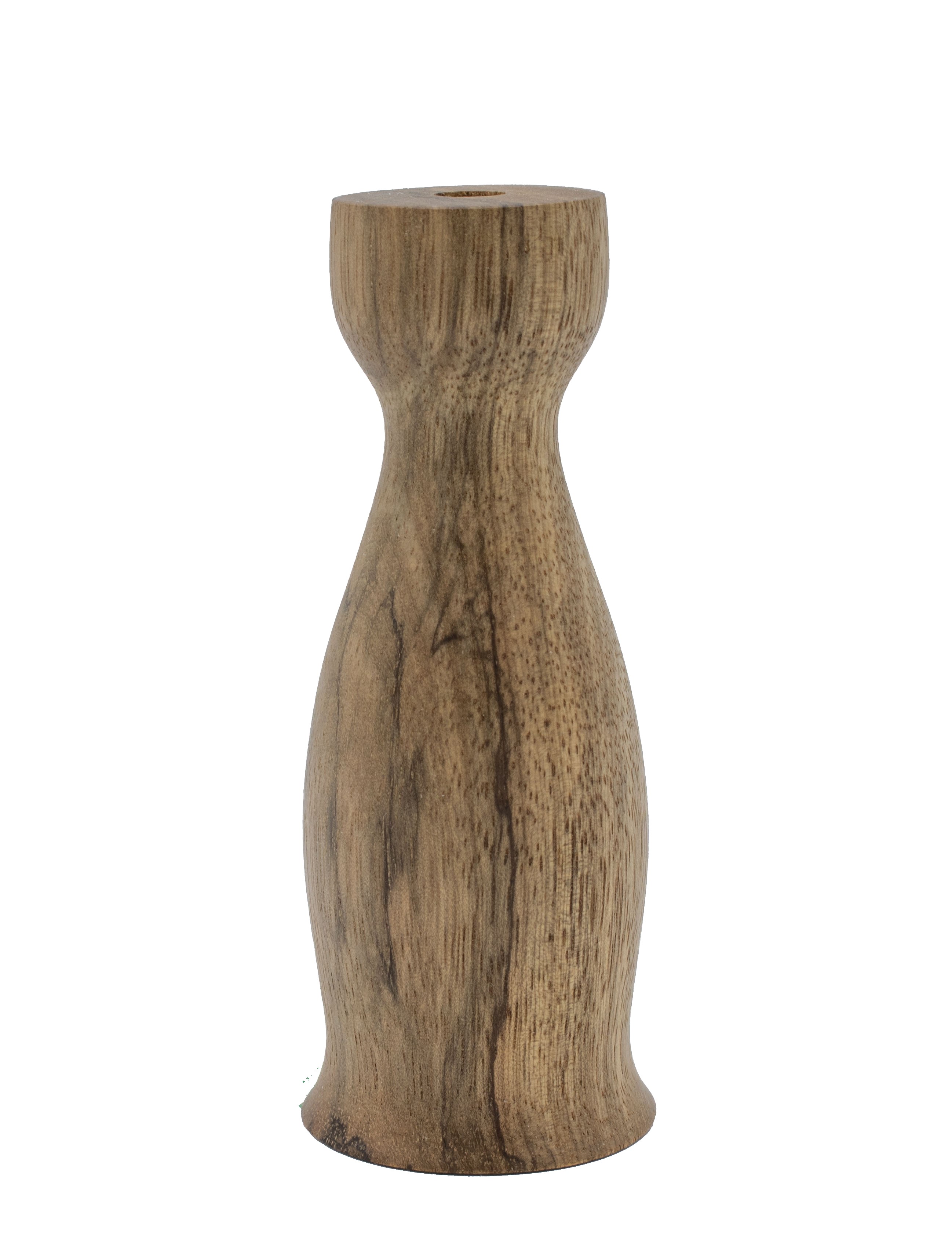
E28: Limba
Terminalis superba. From tropical W. Africa. Also called Afara, Korina. Marketed as Black Limba and White
Limba, even from the same log. White Limba is light tan to gold and plain, while pricier
Black Limba includes streaks of grey, brown, and black. Moderately coarse grain but
works easily and finishes well, much like walnut. Moderate health risks for skin and
respiratory irritation. Used for veneer, furniture, and musical instruments, especially
bodies of electric guitars. Would work with this species again.
Larger view 1
Larger view 2
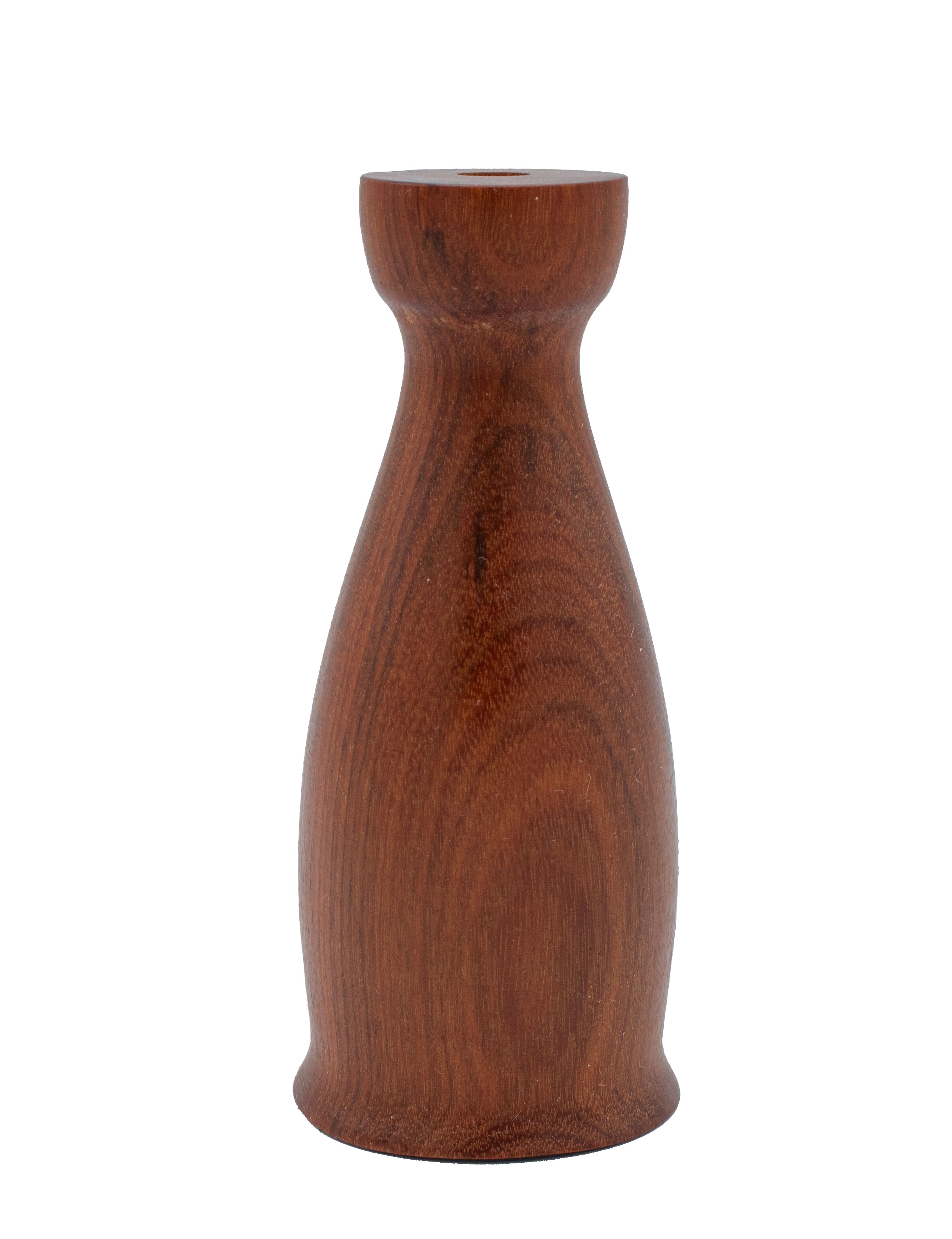
E29: Chatke Viga
Caesalpinia platyloba. From tropical Mexico and Central America. Also known as Paela and Aripin. Bright
orange to golden brown with darker streaks. One of the most colorful woods in the
collection. Also one of the hardest woods in the collection. Turns and sands like
Osage Orange, Dogwood, or Purpleheart. Requires a light touch and sharp tools and
extra time for sanding. Can last up to 100 years as fencepost. Used for inlays, high-end
furniture, musical instruments, and turnings. Related to endangered Brazilwood. In
spite of its difficulties, would work with this species again.
Larger view 1
Larger view 2
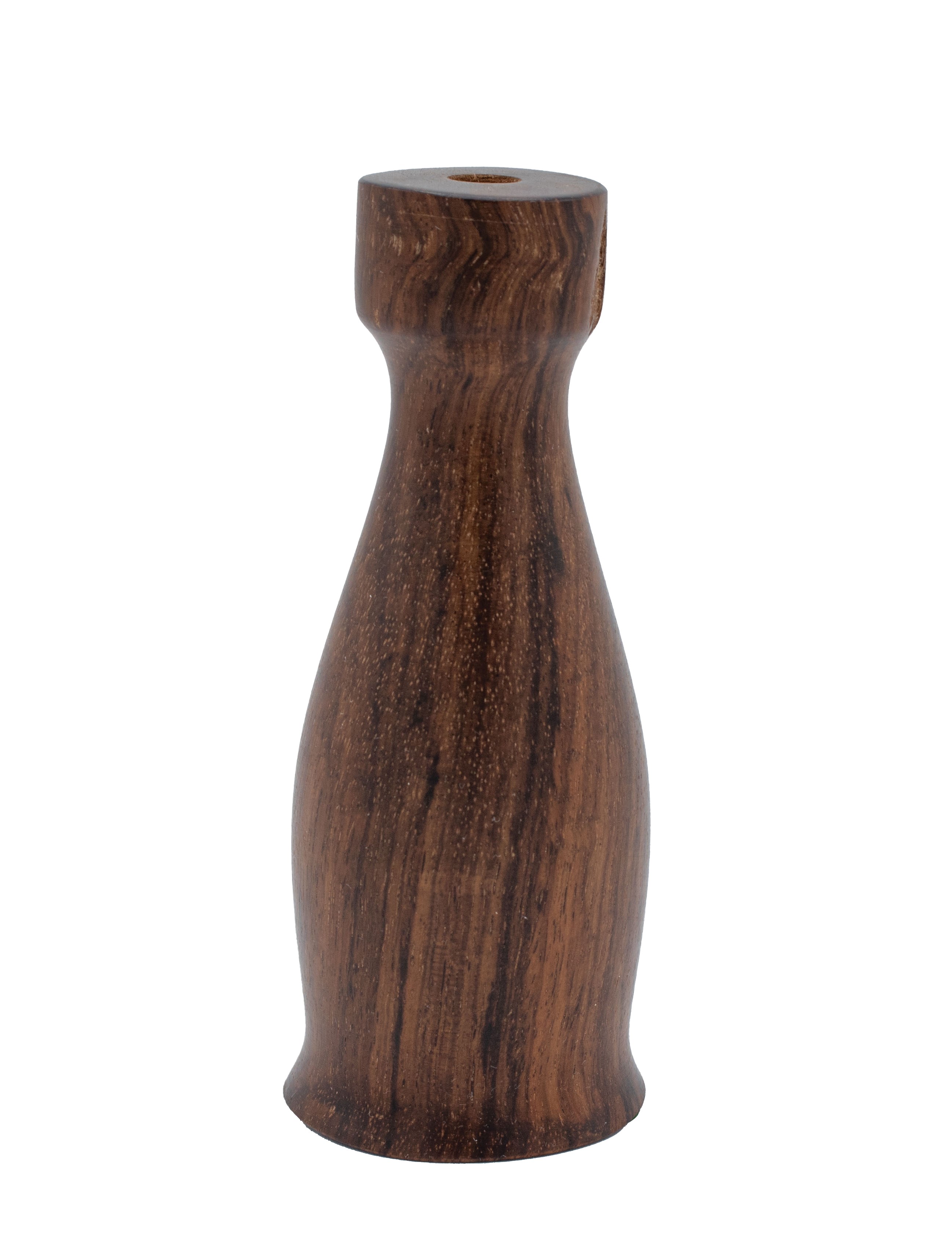
E30: Granadillo
Plymiscium spp. Endangered/Vulnerable. From Central and S. America. Also known as Macabauba, Macawood,
Hormigo, Orange Agate, Coyote. Very dense, hard, brittle, heavy, and prone to chipping,
but fine-grained. Sands very hard and drills hot, but finishes well. Highly variable,
showy colors from oranges to reds to purples with darker streaks. Used for furniture,
cabinetry, veneer, musical instruments as well as turned objects. Pricey but readily
available. Would be hesitant to work with this species again.
Larger view 1
Larger view 2
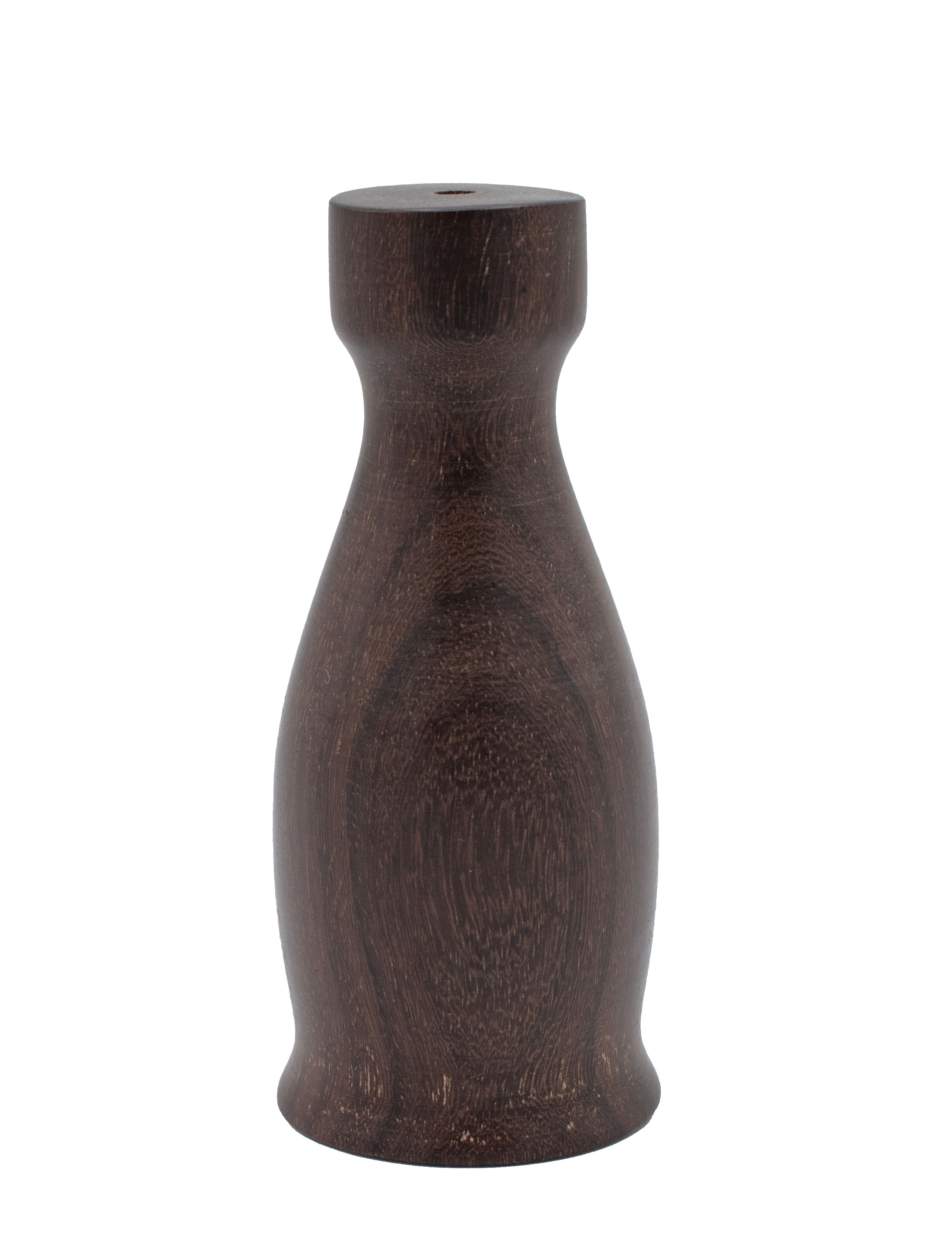
E31: Katalox
Swartzia cubensis. From Mexico, Central and S. America. Also known as Mexican Royal Ebony, but not a
true ebony. One of the world’s hardest woods. Very dense and heavy but fine-grained.
Works surprisingly well. Sands very hard and drills hot, but finishes beautifully.
Also used for fine furniture, inlays, and stringed instruments. One of the priciest
woods in this project. In spite of its difficulties, would work with this species
again.
Larger view 1
Larger view 2
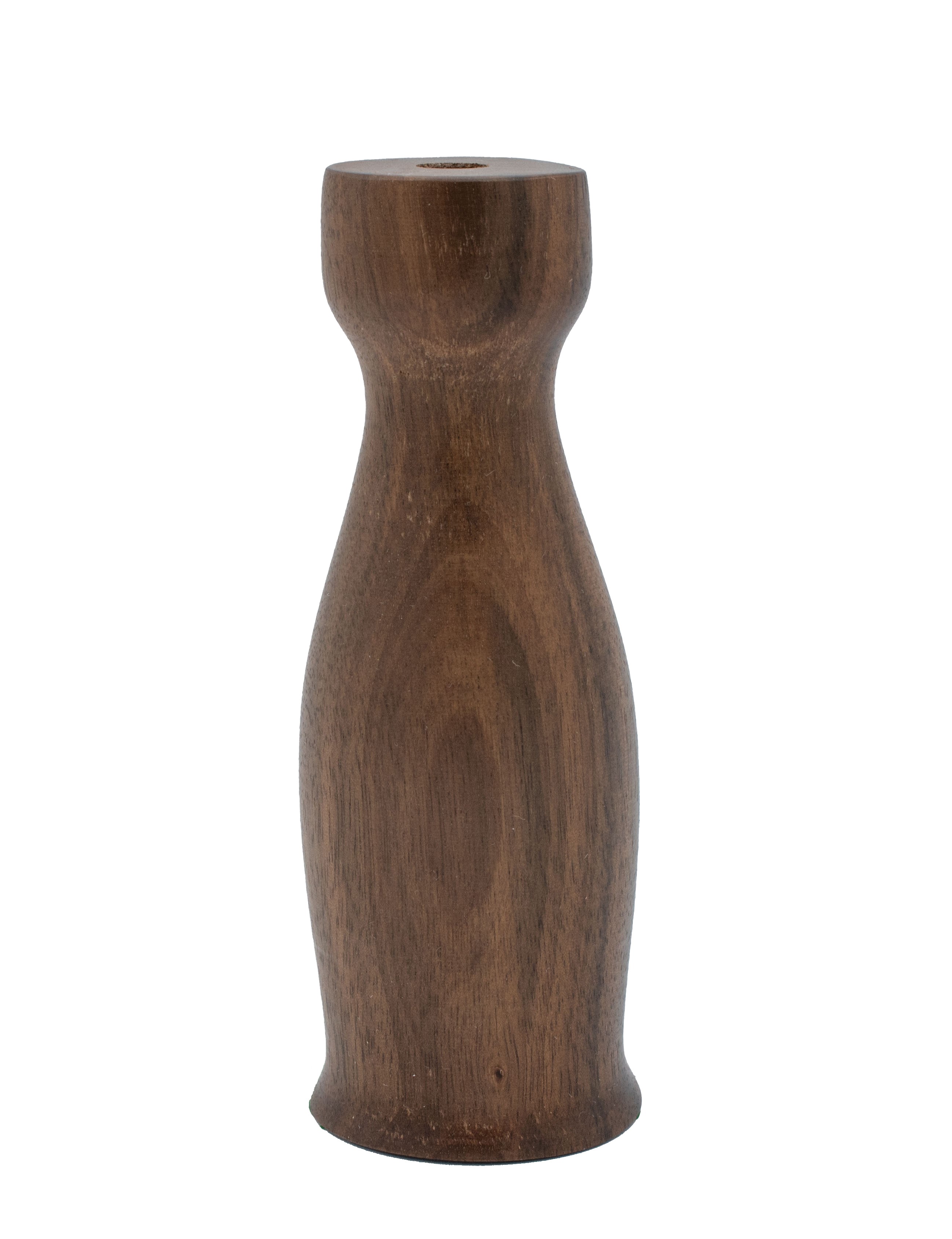
E32: Macassar Ebony
Diospyros celebica. Endangered/Vulnerable. From Southeast Asia. Also known as Striped Ebony and Amara
Ebony. A true ebony but not as scarce or expensive as most prized Ceylon Ebony. Almost black
in some places but with reddish brown and darker brown streaks in others. Extremely
hard but an excellent turning wood overall. Sands and finishes well. It drills hot,
but not waxy. Used for high-end cabinetry, billiard cues, musical instruments, and
turnings. One of the priciest woods in this project. Would work with this species
again.
Larger view 1
Larger view 2
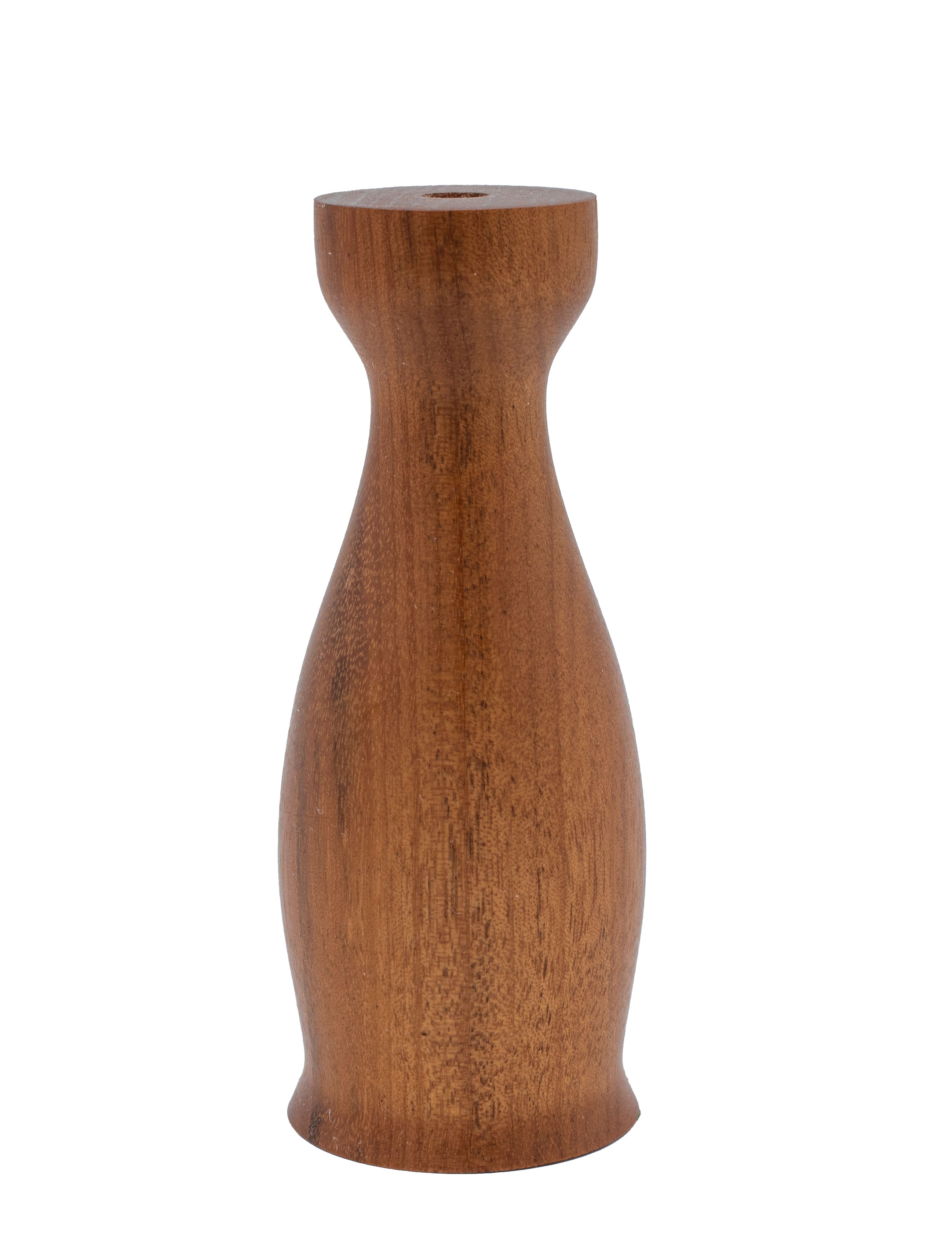
E33: Goncalo Alves
Astronium spp. From Mexico to Brazil. Also known as Jobillo, Tigre Caspi, and marketed for flooring
as Tigerwood. Not to be confused with several other S. American and African species
also marketed as Tigerwood. Very handsome wood but not showy. Light golden brown with
darker brown streaks. Relatively hard wood that works, sands, drills, and finishes
easily. Used for flooring, veneer, furniture, cabinetry, etc. and for pool cues, archery
bows, pistol grips, and knife handles. Would work with this species again.
Larger view 1
Larger view 2
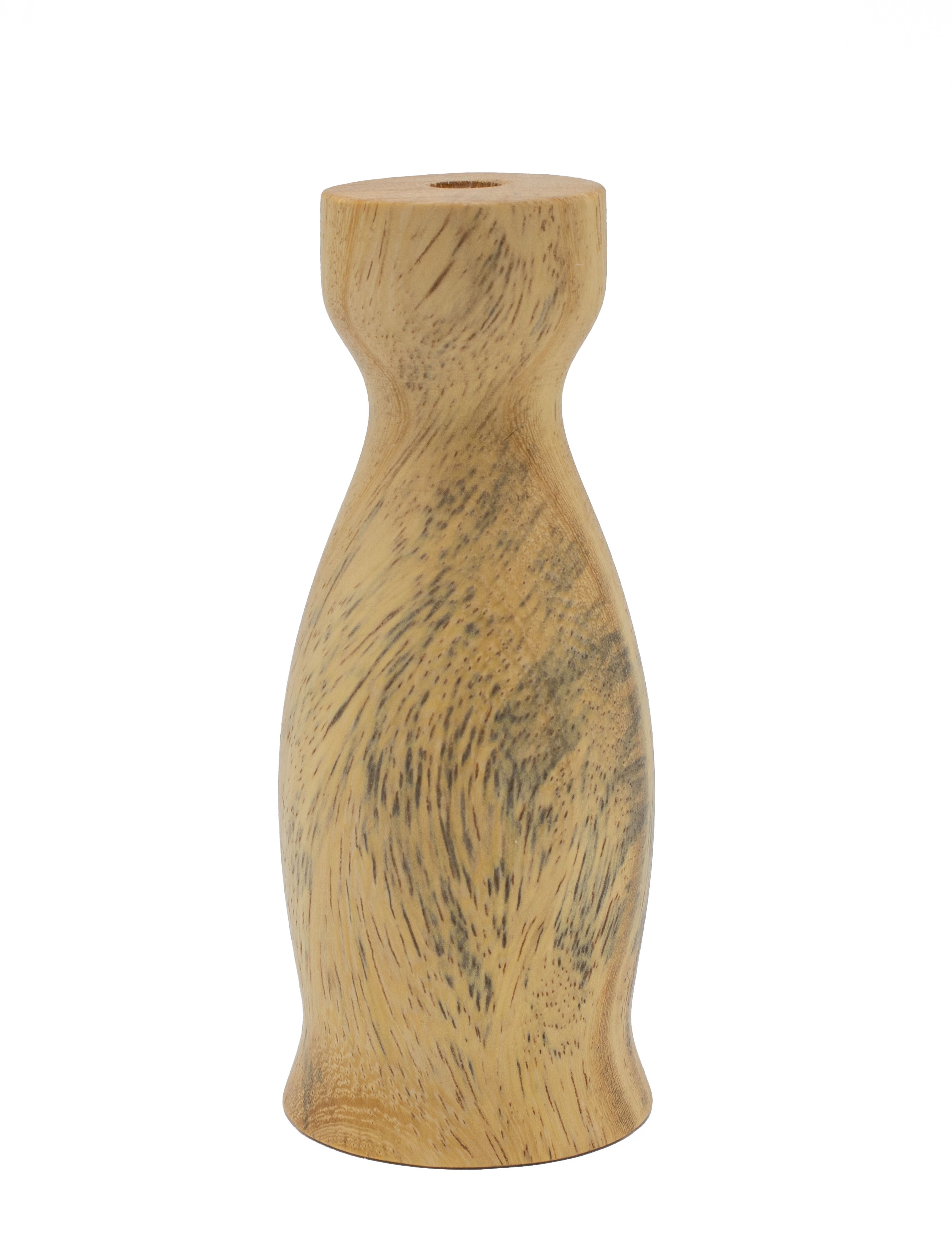
E34: Jacaranda
Jacaranda mimosifolia. From S. America but widely planted as an ornamental in warmer climates worldwide due
to its profuse blue blossoms. Not to be confused with several species of rosewoods
from the Dalbergin family also sometimes called Jacarandas. Also known as Black Poui,
Nupur, and Fern Tree. A very unusual turning wood. Relatively soft wood but turns
well and sands easily. Drills easily and dry. Light color overall with yellows and
tans but swirls of blackish-purple flecks. Similar in some ways to Hawaiian mango.
Used for woodturning and bowl carving. Would work with this species again.
Larger view 1
Larger view 2

E35: Indian Rosewood
Dalbergia latifolia. Endangered/Vulnerable. Also known as East Indian Rosewood. A true rosewood, so hard,
fine-grained, durable, beautiful. Dark brown with almost black grain and some gold
tones. Turns easily despite its hardness. Sands well and drills slightly waxy but
not hot. Used for high-grade furniture, veneer, and musical instruments, especially
acoustical guitars. Would work with this species again.
Larger view 1
Larger view 2
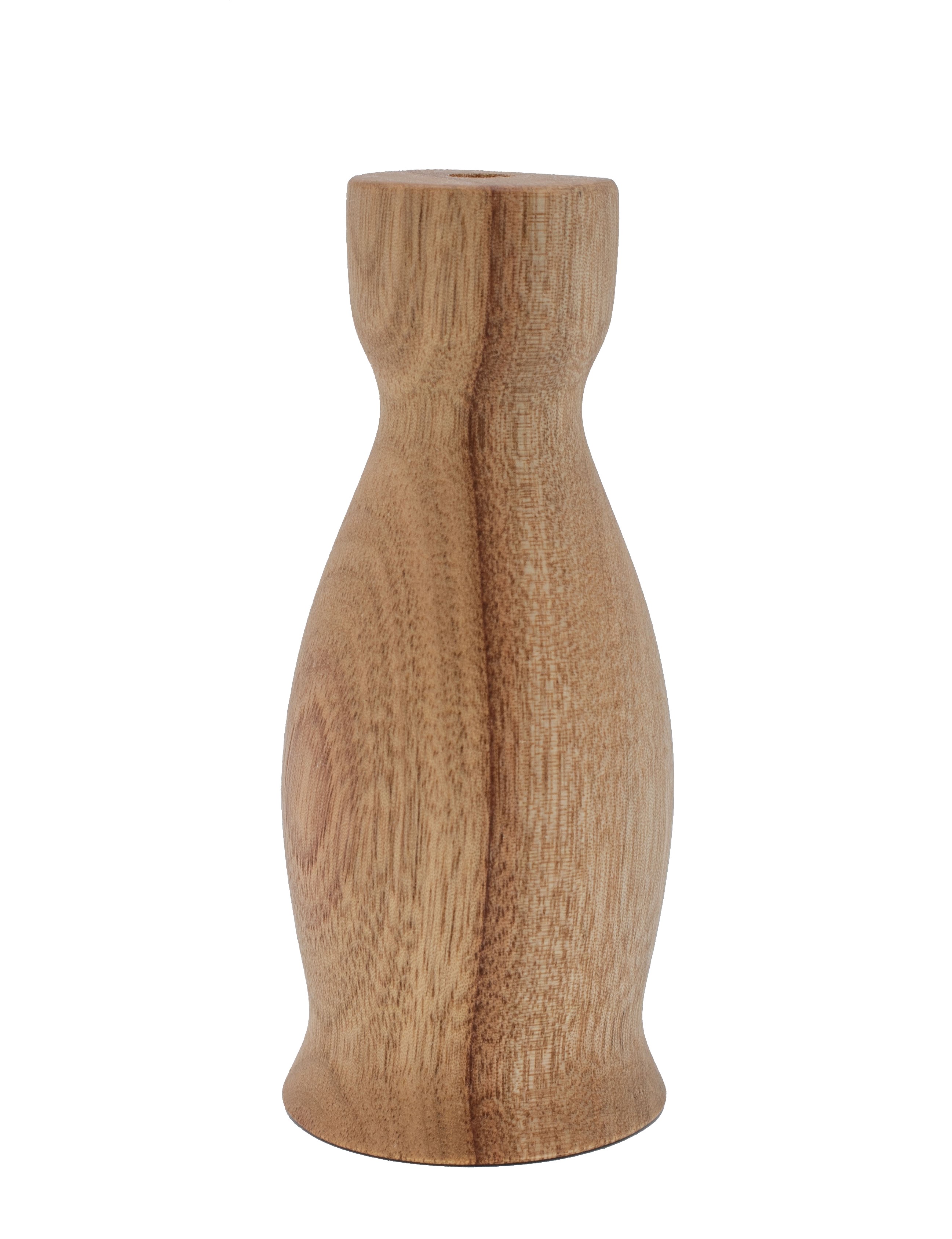
E36: Camphor
Cinnamomum camphora. From Southeast Asia originally but widely planted worldwide in tropical and subtropical
climates. Handsome wood with golden with dark red lines. Durable and similar to cherry
in hardness. Turns, sand, and drills easily. Has a distinctive odor and is a possible
skin and respiratory irritant. Used for veneer, chests, cabinetry, and furniture.
Would work with this species again.
Larger view 1
Larger view 2
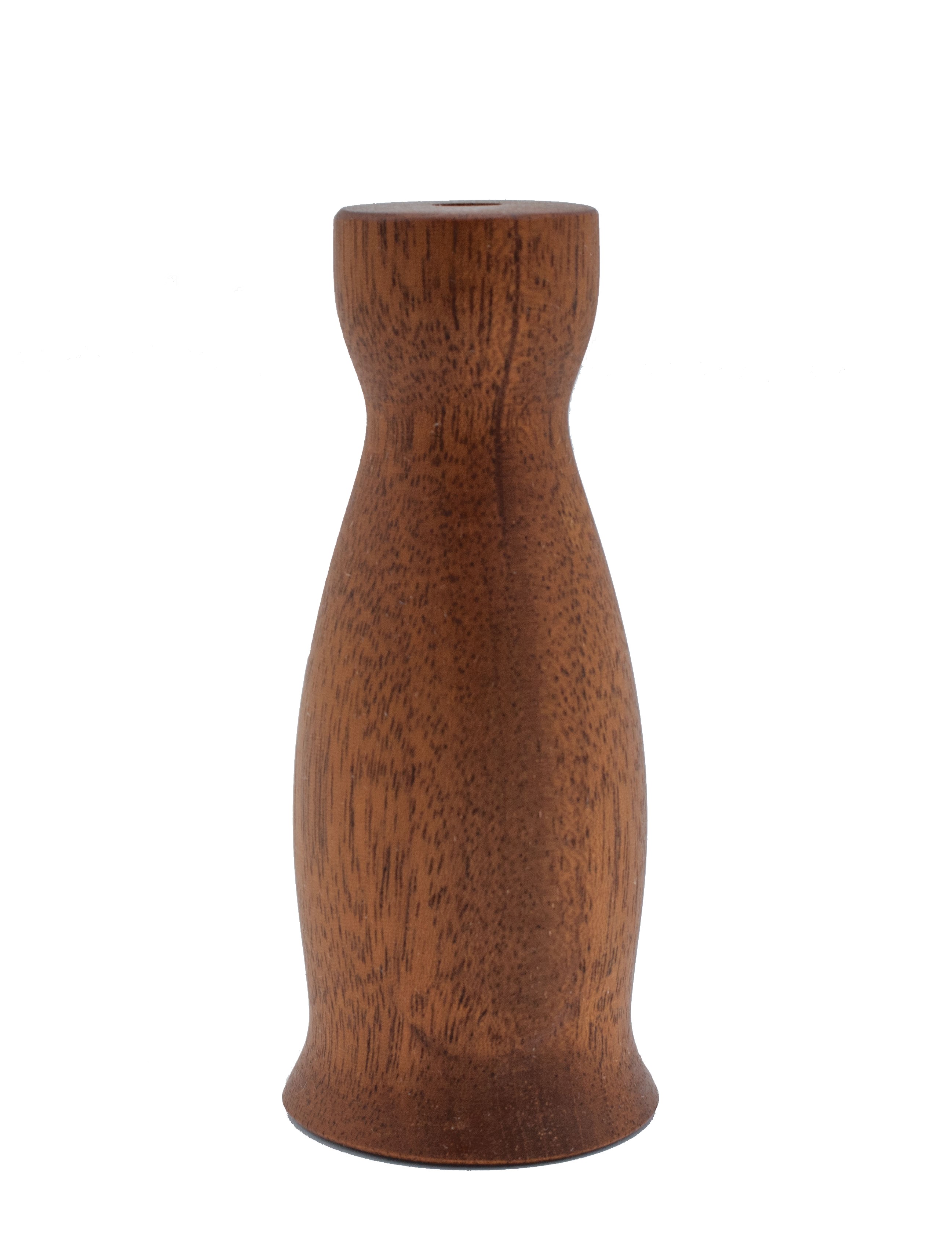
E37: Honduran Mahogany
Swietenia macrophylla. From S. Mexico to Central S. America. Endangered/vulnerable in the wild but often
plantation grown. Also known as Genuine Mahogany, Big-Leaf Mahogany, Brazilian Mahogany,
American Mahogany. Not in same family as African mahoganies. Very easy to work. Turns,
sands, and drills easily. Similar texture to walnut but more reddish. Possible mild
eye, skin, and respiratory irritation, especially from dust. An enduring favorite
for fine woodworking used for furniture, cabinetry, veneer, musical instruments, boatbuilding,
carving, and turning. Sample from Paul Litchy. Would work with this species again.
Larger view 1
Larger view 2

E38: Etimoe
Copaifeera spp. From West and Central Africa. Endangered/vulnerable. Also known as African Etimoe
and African Rosewood (one of several species marketed with this inaccurate name).
Handsome wood that turns and sands easily but drills very hot and waxy. Shades of
brown, gold, and dark brown. Used for veneer, furniture, flooring. Would work with
this species again.
Larger view 1
Larger view 2
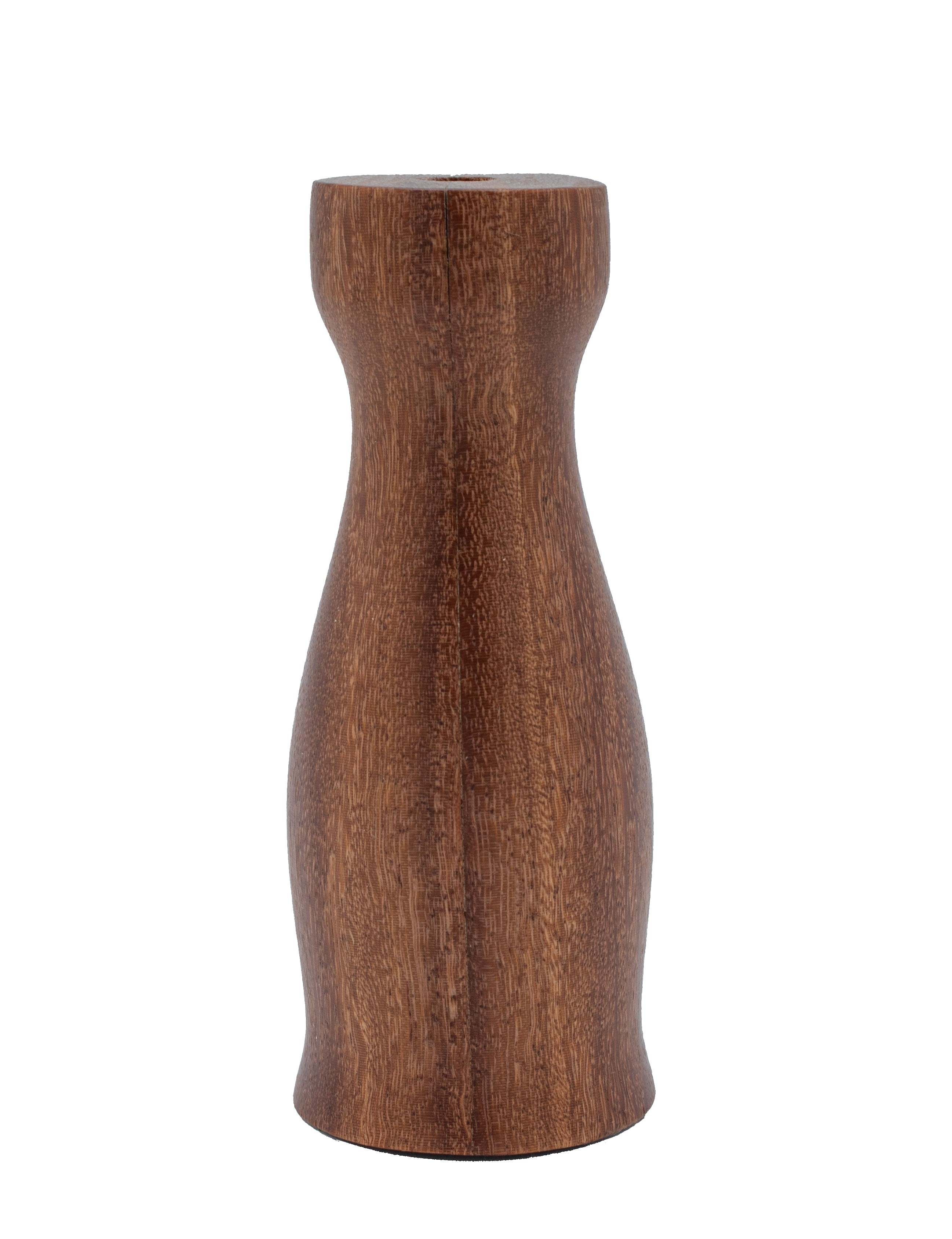
E39: Cumaru
Dipteryx Odorata. From S. America. Also known as Brazillian Teak, Brazillian Chestnut, and Tonka. One
of the world’s hardest and strongest woods. Handsome reddish brown with gold steaks.
Open grain similar to ash, but much harder. Turns well, drills well, but sands very
hard and hot. Extremely weather resistant. Used for furniture, flooring, boatbuilding,
docks, handles, and even bearings. Sample from Tom Wolentarski. Despite its difficulty,
would work with this species again.
Larger view 1
Larger view 2
Associate Professor of Developmental Studies (Retired)
English, Humanities, and Arts Division
Nashville State Community College
Associate of Arts (in Arts and Sciences)
Bachelor of Arts (in English and History) with Secondary Teaching Certification
Master of Arts in College Teaching (in Developmental Studies: Reading and Writing)
Specialist in College Teaching (in Developmental Studies: Reading and Writing)
Craftsman Information
Overview
Lifelong interest and involvement in traditional crafts and residential building trades. Primary career as a community college professor of English, but worked many times in the building trades or as a professional craftsman.
Chronology
- In 50’s and early 60’s, grew up in rural KY in large farming family. By age 20, had learned residential painting, metal and shingle roofing, basic carpentry, basic residential wiring, and basic concrete.
- In senior year of college, learned to make candles and worked as an exhibiting craftsman at a now-defunct theme park in W. KY.
- In graduate school in early 70’s, learned leatherwork and exhibited at weekend crafts shows in KY and IN. Work sold in several galleries and gift shops.
- In ’71, applied for membership in Kentucky Guild of Artists and Craftsmen. Submitted a variety of leatherworks to be juried and subsequently invited to join. Exhibited at their annual show in Berea, KY.
- In late 70’s, learned to make pottery on a potter’s wheel as well as slab and coil pots.
- In early 80’s, built my first real workshop from ground up and wired it.
- In early 80’s, restored several small sailboats, both wood and fiberglass, and learned fiberglass work.
- In late 80’s, learned traditional basketmaking.
- In early 90’s, built family boat dock at our new camp on southern end of Kentucky Lake. Also built large deck at the camp.
- In late 90’s through early 2000’s, built four small wooden rowboats and oars.
- In 2018 through present, have become an active wood turner. Expanded existing workshop into a woodturning studio.
- In 2022, joined TN Craft (formerly TACA), American Association of Woodturners, and Tennessee Association of Woodturners.
- In 2023, applied for membership in Foothills Craft Guild. Submitted a variety of woodturnings to be juried and subsequently invited to join.
- In late 2023, began showing my woodturnings in gallery of Mentone Arts Center south of Chattanooga on Lookout Mountain.
- In early 2024, began showing my woodturnings in gallery of Mud Puddle Studio in Pegram, TN.
- » Disclaimer and Fair Use
This is not a fully documented academic paper. While the entry for each species is based primarily on my shop notes and personal observations, some entries also contain information about usage of the species and/or scientific information. This additional information was gleaned from many sources as I researched each species online. Especially helpful were the descriptions offered by various online vendors, information from forestry and woodworking websites and government agencies, and entries from the Wood Database. According to the guidelines in current use in the TN Board of Regents colleges and universities, all of this information would be considered general information in the public domain. All of the wording in the original document is mine, and no sources need to be cited.
This document is not copyrighted and should also be considered to be in the public domain. It may be duplicated and distributed at will without seeking my permission. My goal is for it to serve as a reference for other woodworkers and an instructional resource for students.
- » Sustainability
When this project began, I made an erroneous assumption. I assumed that if the wood from a particular species was available for purchase in the U.S., then that species was not in danger of extinction. However, in late 2022, I discovered that some of the most widely available exotic hardwoods are either endangered or vulnerable in their wild habitats. Thus, the notes above include “Endangered/Vulnerable” if that species is vulnerable due to overharvesting or in danger of extinction. Although the harvesting and sale of many of these threatened species are closely regulated by various governments and the international lumber industry, users of this document are encouraged to consider sustainability in making their purchases. For more detailed information, consult the “CITES Lists” from the Convention on International Trade of Endangered Species and the “Red List of Threatened Species” from the International Union for Conservation of Nature.
- » Problems with Wood Names
Woods are often marketed with more than one name for a single species. For example, the Central and South American wood, usually called Granadillo, is also marketed as Macabauba, Macawood, Hormigo, Orange Agate, and Coyote. The common American wood Osage Orange is also known as Bodack, Bois d’Arc, and Hedge Iron. Sometimes, the more colorful or figured version of a species is called by a different name than the plain version. For example, when domestic sycamore is quartersawn, it is marketed as American Lacewood at a significantly higher price. Some vendors will use the name from its country of origin, while others will use a descriptive English name. A few vendors include the other name(s) of the species, but many do not. Particularly troublesome are woods marketed as mahoganies, rosewoods, satinwoods, ebonies, and lacewoods but are actually not members of those groups. They are usually less expensive and share some of the desirable qualities as their namesakes, but they are not true members of that species.
The free online Wood Database is the most reliable source I’ve found to sort out these names as it lists all the names under which a species is marketed as well as related species. This website also gives the scientific name of the wood, which is seldom given on vendors’ websites. The abbreviation “spp” in the scientific names above means “multiple species.” For example, the lumber industry uses the name “soft maple” to market all maples that are not “hard maple” (sugar maple only). The scientific name of this soft maple group is “Acer spp,” meaning “multiple species of maple.” This source also gives useful info about the qualities, uses, health concerns, and sustainability of the wood.
- » The Process
After a blank arrived or was cut, it was checked for internal moisture using a pin-type digital moisture meter. Some samples were set aside for further drying for as long as two years before turning. When a sample was dry enough, it was prepped for the final turning and finishing. The centers were marked, and the edges were cut off on a bandsaw. Then, the blank was rounded for later turning. These blanks were prepped in batches.
In the final turning and finishing, a specific procedure was followed using the same techniques and tools on each sample so that the qualities of each wood could be more accurately compared to other woods. In the final turning, the rounded blank was mounted in a lathe chuck, and the sample was shaped, sanded, and finished. The top was then parted, and the hole was drilled using a chuck in the lathe’s tailpiece. A ¼” hole was drilled first and then enlarged to the final 3/8” hole. Then, the bottom of the sample was parted at the chuck. Finally, the top and bottom of the sample were sanded on a stationary belt sander, and the finish was applied to them manually.
The lathe used was a Rikon 70-220 VSR, and only the middle of its 3 ranges of speeds was used. Speeds of 800-1000 rpm were used for turning and sanding. The lathe chuck used was a reversible Teknatool Nova. The lathe chisels used were a Benjamin’s Best ¾” HHS roughing gouge, two full-size custom-made shaping chisels (made by Randy Greenwell) with Easy Wood carbide cutters, and a Sorby 3/16” HHS parting tool. The sandpapers used ranged from 80 grit for the hardest samples to 600 grit wet/dry and were used in the standard progression for woodworking. No attempt was made to achieve a perfect finish, just one that would allow the color, grain, and texture of the sample to be examined.
The finish was a simple, common, shop-made mixture of beeswax melted into food-grade mineral oil. This allowed it to be applied quickly on the lathe by hand and handled immediately after. It was applied first by hand with the lathe turned off. Then, the finish was worked into the wood at 500 rpm in both forward and reverse before it was ”heated in” by friction at 800 rpm, which set the finish enough to be handled. This finish has a slight yellowing effect similar to most of the other more time-consuming finishes.
- » Wood Sources
- The first twelve samples turned came from species already on hand in my workshop. All other samples were purchased from online vendors unless the shop notes above say otherwise. The prices of the samples of domestic species were usually $2-8 each, while the exotics usually cost $4-10 each.
- Fellow woodworkers have contributed ideas, encouragement, and approximately 1/3 of the samples in this project. They are listed later in this document. Thanks to you all.
- Middle Tennessee Lumber--A huge company centered in Dickson, TN and has a retail location in Clarksville, TN. At both locations, they sell hardwood by the single plank, but the Dickson location focuses on wholesale customers. Primarily Appalachian hardwoods, but a few exotics at the Clarksville location. Stock sold in planks by the board foot in both places. My primary source of hardwood for other woodworking projects. Highly recommended. A source for this project.
All of the following sources can be found online and are included because of their offerings for woodturners.
- Turningblanks.net--Also known as Got Wood? LLC. A small, highly specialized, family-owned company in S. Carolina that buys logs and processes them into bowl and spindle blanks. They have their own kiln, and new kiln-dried blanks appear on their product list every week or so. The end grain on all blanks is sealed in wax. Modest selection of woods—usually fewer than 25 species—and often out of particular sizes of blanks, so the site must be checked regularly for specific sizes and new species. They usually stock some of the more common exotics; same for domestics. Their prices are lower than most other vendors, their service is outstanding, and their shipping is reasonable and very fast. The Bargain Bin on their website offers blanks at the lowest prices I’ve seen. A major source for this project.
- Cherokee Wood Products--A large company in S. California that sells everything from boards to veneers to turning blanks. Have bought lots of thin wood from them and am always satisfied. Shipping is slow and somewhat pricey due to distance, but still not exorbitant. Have purchased only a few turning blanks here, but all were perfect and had moisture contents in 5-8% range, and the ends were sealed. A source for this project.
- Bell Forest Wood Products--A company in Michigan that specializes in exotics and figured domestics. The largest selection of species I’ve found so far and has excellent descriptions. Also extremely wide variety of spindle sizes, but fewer sizes in bowl blanks. Shipping is fast and reasonable. All items ordered have been waxed only on the ends but were all advertised as kiln-dried and arrived with less than 10% moisture. Offers a huge variety of green blanks. A source for this project.
- Craft Suppliers USA, The WoodTurner’s Catalog--A huge company in Utah that offers an amazing variety of domestic and exotic woods. Have found domestic woods there available nowhere else and at relatively reasonable prices. Most blanks are said to be “partially dried with no guarantee of moisture content.” First order had 2 dry, 2 partially dry, 1 very green. All blanks completely waxed. Shipping via UPS Ground is very reasonable, considering the weight and distance. A source for this project.
- Barrington Hardwoods--An Amazon vendor selling mostly spindle stock of native hardwoods, but with free shipping on all orders. A few bowl blanks offered, and a few exotics available in limited sizes. Purchases arrived planed and blemish-free. A source for this project.
- Ocooch Hardwoods--A small family-run vendor in Wisconsin that specializes in thin stock and planks for use by inlay, scroll saw, and laser engraving artisans. Mostly native hardwoods with a few exotics. Small turning blanks available at very reasonable prices. Items ordered arrived in perfect condition. Shipping costs are actual USPS and UPS fees with no handling charges added. A source for this project.
- Cook Woods--Huge selection of turning blanks, domestic and exotic, at reasonable prices. Free shipping on orders $75 or more. Lots of sales. Bowl blanks in a wide range of prices, but reasonable enough with free shipping.
- Advantage Lumber Company--A large company with several locations around the U.S. Specializes in imported hardwoods for high-end floors, decks, and fences. A small selection of green turning blanks offered, but includes some hard-to-find species, all at very reasonable prices. A source for this project.
- Green Valley Wood Products--A large company in central Indiana that specializes in lumber for the hobbyist. Large variety of species available, but most blanks sold green and waxed. Most spindle blanks sold in lots. Bowl blanks of many species available in large sizes. Free shipping on some items.
- Oakbrook Wood Turning Supply--A small company in Utah that specializes in small stock for making pens, knives, turkey calls, etc. Has an extremely large number of domestic and imported species available, including some hard-to-find domestics.
- WoodTurningBlanks4U--A small company in FL that offers about 2 dozen species of domestic and exotic woods with some hard-to-find woods. Bowl and spindle blanks with very good prices on small sizes. Blanks sold green and arrived fully waxed. A source for this project.
- Gilmer Wood Company--A large firm that offers dozens of domestic and exotic species in very high grades for making instruments, pool cues, knife and pistol grips, as well as bowl blanks and turning blanks. Offerings range from $10 turning blanks to $4,000 slabs for tabletops.
- Exotic Wood Zone--A St. Louis company offering high-grades of domestic and exotic species for musical instruments as well as bowl blanks and turning blanks. Bowl blanks from $10 to $200. A source for this project.
- Turner’s Circle--An eBay company that offers an excellent variety of high-grade turning blanks of domestics and exotics in small sizes. A few bowl blanks. A source for this project.
- Etsy vendors--This huge website can be searched for turning blanks and bowl blanks from individuals and small companies.
- Ebay vendors--This huge website can be searched for turning blanks and bowl blanks from individuals to fairly large companies. These are usually offered as Buy It Now rather than on the timed Ebay auctions. A source for this project.
- Facebook Marketplace--An excellent source for larger quantities of wood in planks or slabs from nearby individuals and small local sawmills. However, the stock is seldom kiln-dried and seldom planed. An excellent source for inexpensive stock to be stored for a year or more before use. Sometimes the lumber harvested from a single tree is offered, either ripped into planks on a bandsaw mill or still in short logs in the seller’s yard. The ads are constantly changing as lots are sold, so a buyer must act quickly to get the best buys.
- » Shipping
Shipping costs were a major factor in this project. Of course, I had to pay direct shipping charges for my orders, and they varied widely among online vendors. But the cost of shipping wood from various foreign locations was a hidden factor built into the prices set by the vendors. In general, exotics from Central and South America were cheaper than those from Africa, Asia, or Australia.
UPS Ground and USPS Priority have usually been the two most reasonable shipping options. Faster options are exorbitant.
Turning blanks 12” or shorter can be shipped much more reasonably than longer blanks, even with same total package weight.
Shipping rates are usually based on weights up to a certain amount, so often shipping a few additional blanks in a single order costs no more than shipping fewer blanks. All of the online vendors used in this project offered estimates of shipping costs using various options, and these can be used to determine the maximum weight that can be shipped for a particular price.
Green blanks are cheaper than kiln-dried ones, but they are heavier and cost more to ship. Thus buying green blanks is sometimes a false economy. However, some species included here were only available in green blanks. They always arrived with at least the ends sealed in wax.
Some turning blanks are available on Amazon with free shipping via Prime. An especially good deal is turning blanks of domestic hardwoods from Barrington Hardwoods (listed above), which will ship blanks up to 30 inches long for free through Amazon Prime. Green Valley and Turningblanks.net (listed above) also offer some blanks on Amazon and eBay with free shipping.
- » Hardness of Woods on Janka Scale
Select Domestic Woods
- Cypress: 510
- Poplar: 540
- Sycamore: 770
- Elm: 830
- Longleaf Pine: 870
- Hackberry: 880
- Cherry: 950
- Black Walnut: 1010
- Red Oak: 1220
- Birch: 1260
- Beech: 1300
- Ash: 1320
- Hard Maple: 1450 (Soft maple is a commercial grouping of several related species. Their hardness ranges from 700 for Silver Maple to 950 for Red Maple. Hard maple is only sugar maple.)
- Locust: 1580
- Hickory: 1820
- Dogwood: 2150
- Persimmon: 2300
- Osage Orange: 2620
- Live Oak: 2680
- Desert Ironwood: 3260
Select Exotic Woods
- Redheart: 1210
- Wenge: 1930
- Morado: 1960
- Padauk: 1970
- Brownheart: 1980
- Bocote: 2100
- Argentine Osage Orange: 2380
- Bubinga: 2410
- Purpleheart: 2520
- Marblewood: 2530
- Jatoba: 2690
- Granadillo: 2700
- Bloodwood: 2900
- Curupau: 3630
- Katalox: 3660
- African Blackwood: 3680
- Snakewood: 3800
- Gidgee: 4270
- Lignum Vitae: 4390
- Quebracho: 4570
- » Contributors
In alphabetical order by last name:
- Leslie Angel, Franklin, TN
- Gunnar Barnes, Dickson, TN
- Jose Garcia, Dickson, TN
- Randy Greenwell, Henderson, KY
- Walter “Butch” Lichtenberg, Calvert City, KY
- Paul Litchy, Franklin, TN
- Meredith “Mickey” Luck, Fort Payne, AL
- Randy Rushing, Humboldt, TN
- Elwood Sellars, Medina, TN
- Paul Sellars, Henderson, KY
- Terry Sellars, Dickson, TN
- Cassie Smith, Medina, TN
- Phillip Sparks, Nashville, TN
- Tom Wolentarski, White Bluff, TN
Tennessee Tech Library - more than you expect
The Volpe Library welcomes your comments, questions, and suggestions.
This form is submitted directly to the Library Dean.


